Online Cloths Shopping versus Cloths Stores in the UK: How do Consumers Shop?
VerifiedAdded on 2023/06/13
|64
|15748
|370
AI Summary
This study investigates how online shopping compares to in-store shopping for clothing items by studying the consumers shopping orientation. The study involved n=800 UK citizens (undergraduate students in the university) aged over 15 years as well as 75 companies in the fashion industry. It was established that about 56% of the respondents shop in stores while 44% shop online for their clothing needs. Convenience was cited as the main motivating factor for online shoppers while the ability to try on products and presence of assistive personnel motivates in-store shoppers. To address changing dynamics in the marketplace as well as meet the demand, firms prefer operating on both online and in-store fronts.
Contribute Materials
Your contribution can guide someone’s learning journey. Share your
documents today.
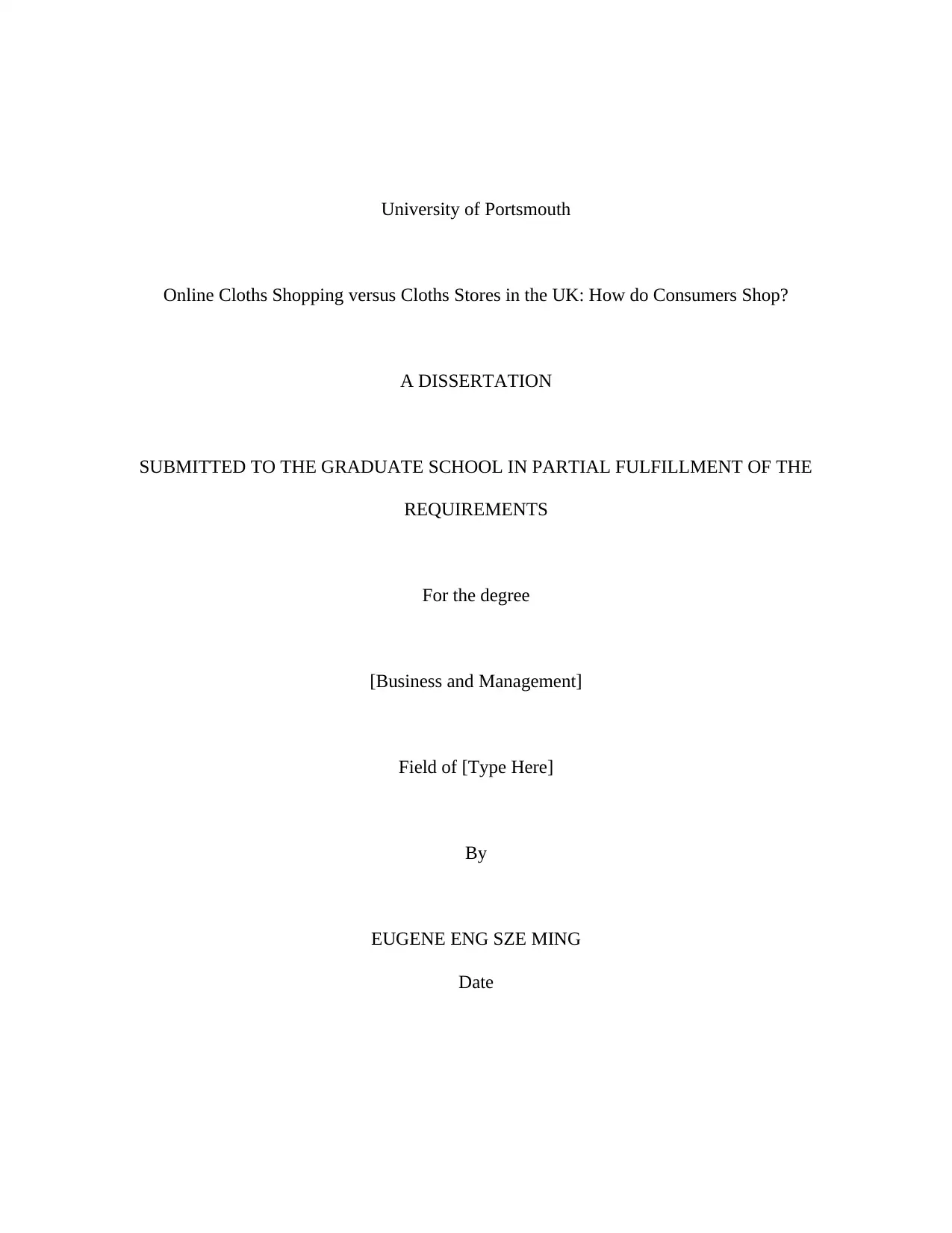
University of Portsmouth
Online Cloths Shopping versus Cloths Stores in the UK: How do Consumers Shop?
A DISSERTATION
SUBMITTED TO THE GRADUATE SCHOOL IN PARTIAL FULFILLMENT OF THE
REQUIREMENTS
For the degree
[Business and Management]
Field of [Type Here]
By
EUGENE ENG SZE MING
Date
Online Cloths Shopping versus Cloths Stores in the UK: How do Consumers Shop?
A DISSERTATION
SUBMITTED TO THE GRADUATE SCHOOL IN PARTIAL FULFILLMENT OF THE
REQUIREMENTS
For the degree
[Business and Management]
Field of [Type Here]
By
EUGENE ENG SZE MING
Date
Secure Best Marks with AI Grader
Need help grading? Try our AI Grader for instant feedback on your assignments.
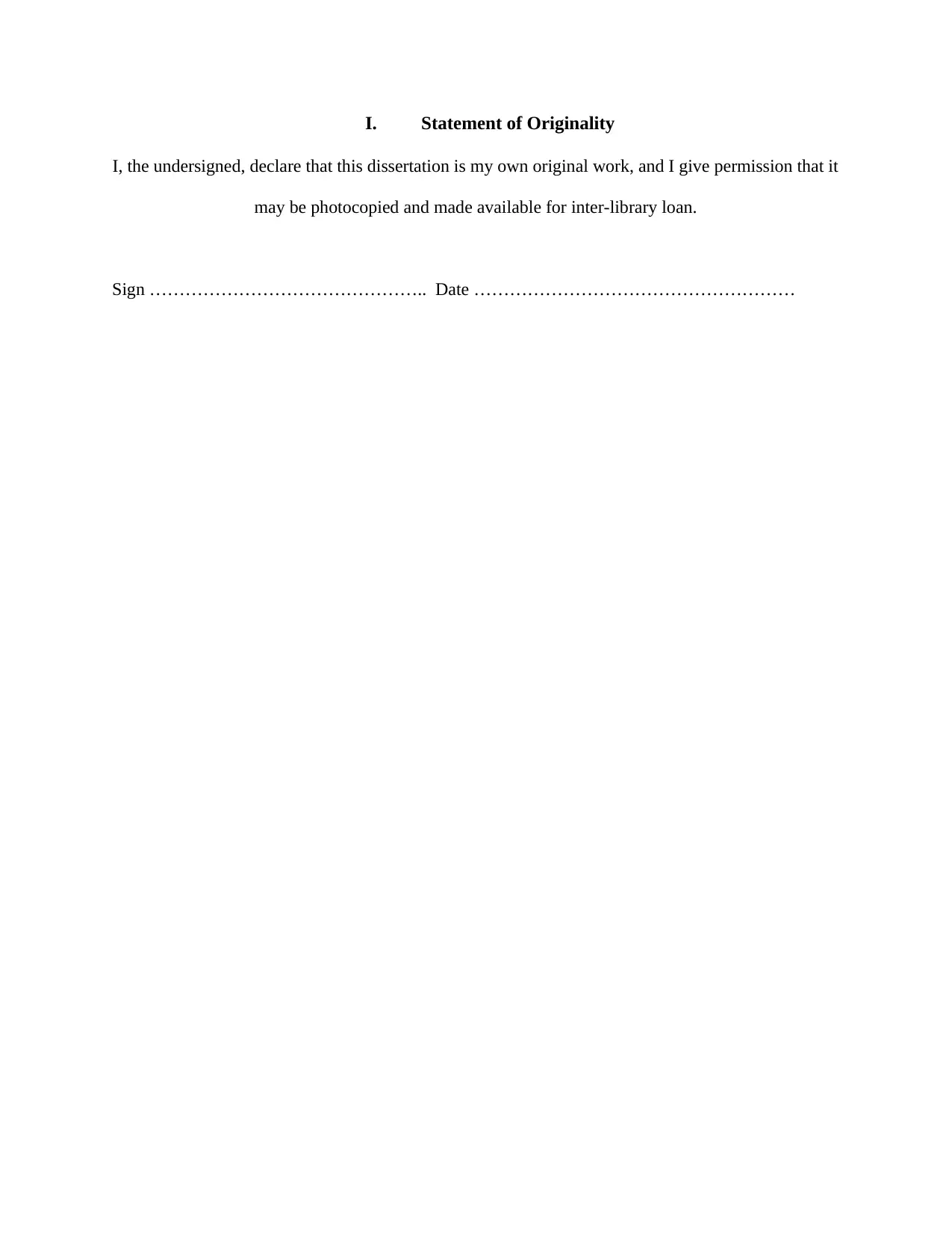
I. Statement of Originality
I, the undersigned, declare that this dissertation is my own original work, and I give permission that it
may be photocopied and made available for inter-library loan.
Sign ……………………………………….. Date ………………………………………………
I, the undersigned, declare that this dissertation is my own original work, and I give permission that it
may be photocopied and made available for inter-library loan.
Sign ……………………………………….. Date ………………………………………………
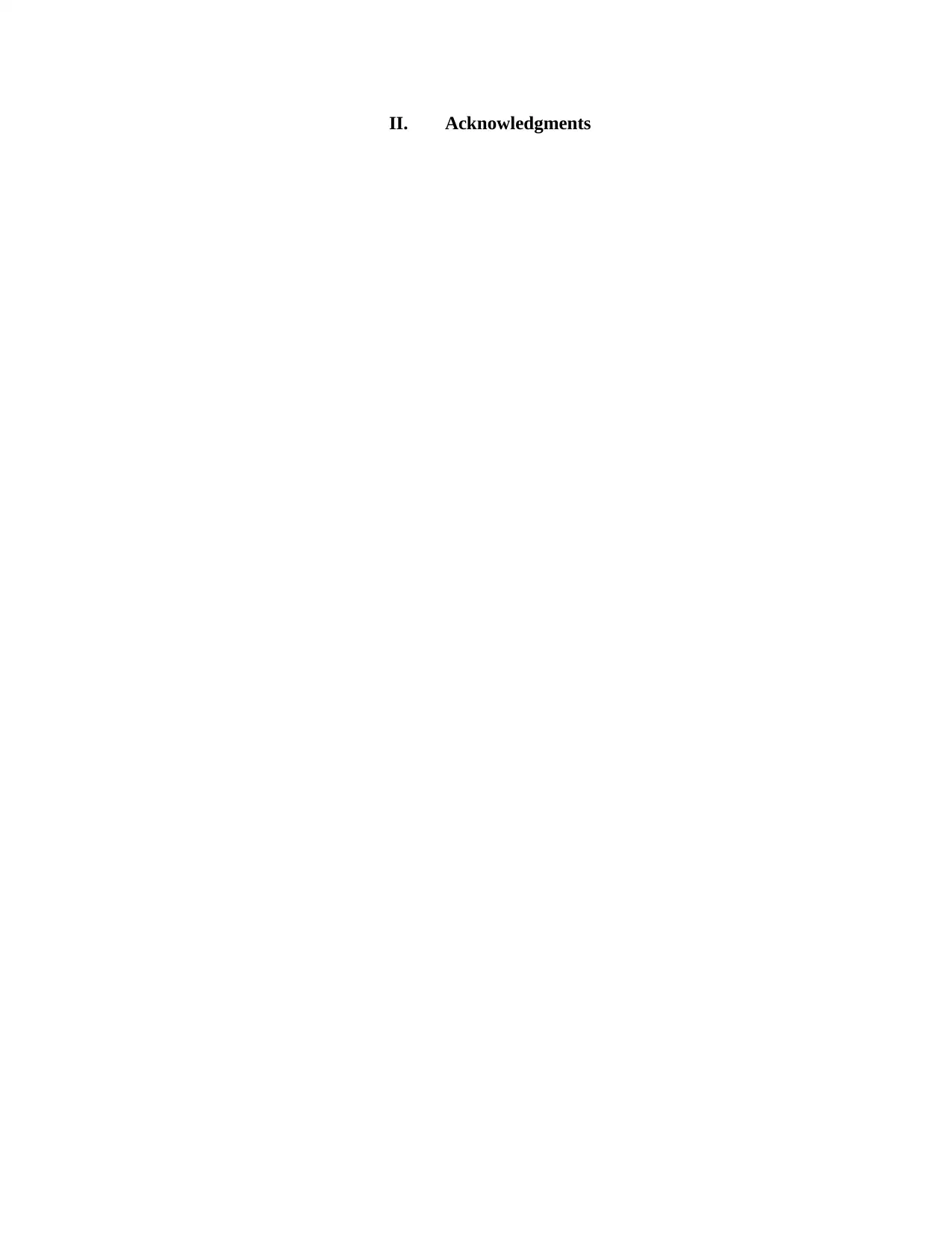
II. Acknowledgments

III. Abstract
This study investigates how online shopping compares to in-store shopping for clothing
items by studying the consumers shopping orientation. The researcher uses a mixed methods
approach to establish (1) how UK consumers shop for their clothing items, (2) what factors
motivate a consumer’s shopping orientation, and (3) how companies are strategizing to match the
changing marketplace dynamics in the fashion industry. The study involved n=800 UK citizens
(undergraduate students in the university) aged over 15 years as well as 75 companies in the
fashion industry. The survey technique (a survey was created on the Survey Monkey website)
and interviews were used to collect data.It was established that about 56% of the respondents
shop in stores while 44% shop online for their clothing needs. Convenience was cited as the
main motivating factor for online shoppers while the ability to try on products and presence of
assistive personnel motivates in-store shoppers. To address changing dynamics in the
marketplace as well as meet the demand, firms prefer operating on both online and in-store
fronts.
This study investigates how online shopping compares to in-store shopping for clothing
items by studying the consumers shopping orientation. The researcher uses a mixed methods
approach to establish (1) how UK consumers shop for their clothing items, (2) what factors
motivate a consumer’s shopping orientation, and (3) how companies are strategizing to match the
changing marketplace dynamics in the fashion industry. The study involved n=800 UK citizens
(undergraduate students in the university) aged over 15 years as well as 75 companies in the
fashion industry. The survey technique (a survey was created on the Survey Monkey website)
and interviews were used to collect data.It was established that about 56% of the respondents
shop in stores while 44% shop online for their clothing needs. Convenience was cited as the
main motivating factor for online shoppers while the ability to try on products and presence of
assistive personnel motivates in-store shoppers. To address changing dynamics in the
marketplace as well as meet the demand, firms prefer operating on both online and in-store
fronts.
Secure Best Marks with AI Grader
Need help grading? Try our AI Grader for instant feedback on your assignments.

IV. List of Contents
I. Statement of Originality..........................................................................................................2
II. Acknowledgments...................................................................................................................3
III. Abstract.................................................................................................................................4
V. List of Tables and Figures.......................................................................................................7
1. CHAPTER ONE: INTRODUCTION......................................................................................8
1.1. Statement of the Problem..................................................................................................8
1.2. Research Purpose Statement...........................................................................................10
1.3. Rationale of the Study.....................................................................................................10
1.4. Research Questions and Objectives................................................................................11
2. CHAPTER TWO: LITERATURE REVIEW........................................................................12
2.1. Introduction.....................................................................................................................12
2.2. Online vs. In Store Shopping: How UK Consumers Shop for Clothing Items...............13
2.2.1. Defining Online and In Store Shopping..................................................................13
2.2.2. The Fashion and Apparel Industry in the UK..........................................................14
2.2.3. How UK Consumers Shop for Clothing Items: Online or In-store?.......................15
2.3. The Motivations and Rationale for Shopping Decisions by UK Consumers.................18
2.3.1. The Merits of Online Shopping...............................................................................19
2.3.2. The Demerits of Online Shopping...........................................................................20
2.3.3. The Merits of In-Store Shopping.............................................................................20
I. Statement of Originality..........................................................................................................2
II. Acknowledgments...................................................................................................................3
III. Abstract.................................................................................................................................4
V. List of Tables and Figures.......................................................................................................7
1. CHAPTER ONE: INTRODUCTION......................................................................................8
1.1. Statement of the Problem..................................................................................................8
1.2. Research Purpose Statement...........................................................................................10
1.3. Rationale of the Study.....................................................................................................10
1.4. Research Questions and Objectives................................................................................11
2. CHAPTER TWO: LITERATURE REVIEW........................................................................12
2.1. Introduction.....................................................................................................................12
2.2. Online vs. In Store Shopping: How UK Consumers Shop for Clothing Items...............13
2.2.1. Defining Online and In Store Shopping..................................................................13
2.2.2. The Fashion and Apparel Industry in the UK..........................................................14
2.2.3. How UK Consumers Shop for Clothing Items: Online or In-store?.......................15
2.3. The Motivations and Rationale for Shopping Decisions by UK Consumers.................18
2.3.1. The Merits of Online Shopping...............................................................................19
2.3.2. The Demerits of Online Shopping...........................................................................20
2.3.3. The Merits of In-Store Shopping.............................................................................20
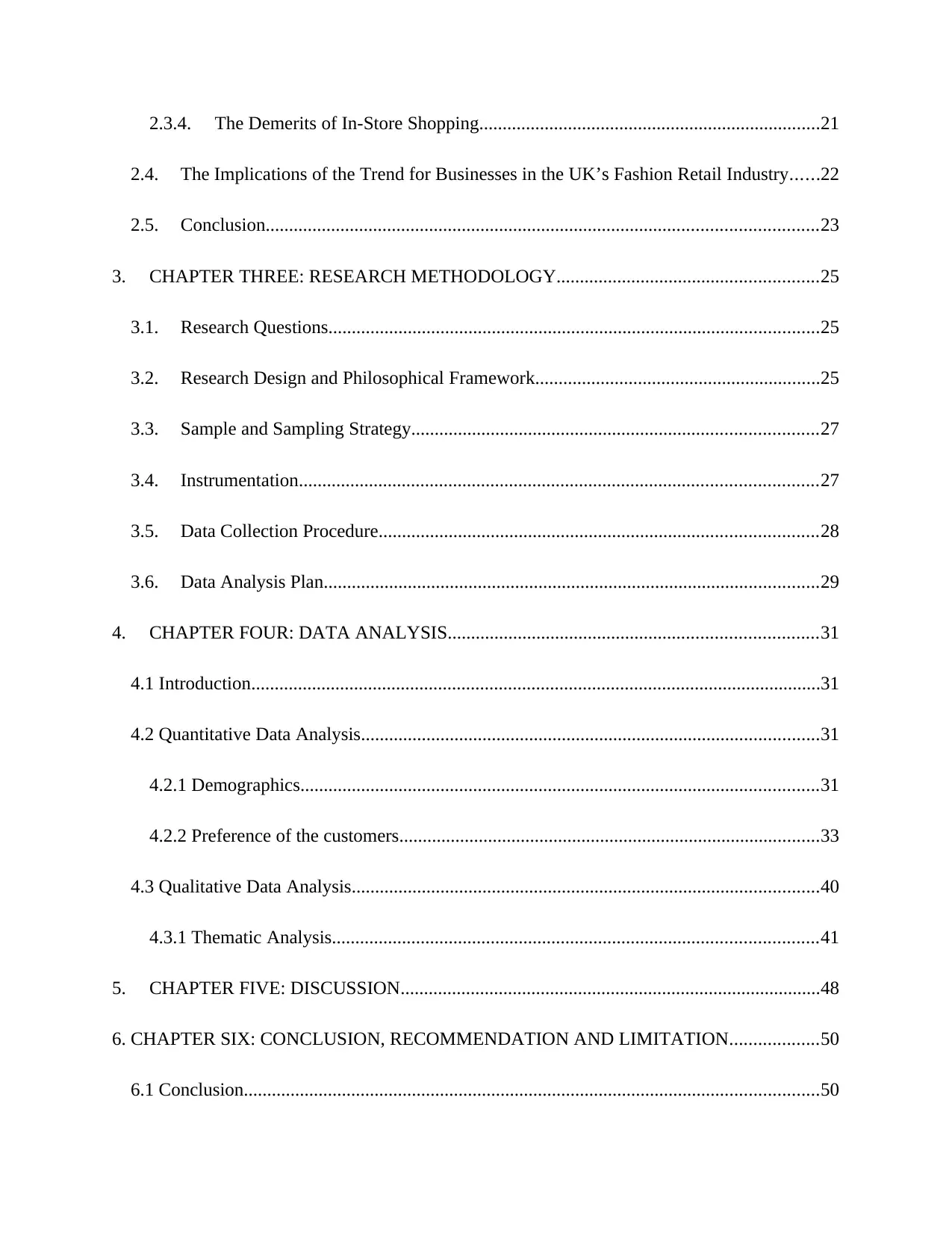
2.3.4. The Demerits of In-Store Shopping.........................................................................21
2.4. The Implications of the Trend for Businesses in the UK’s Fashion Retail Industry......22
2.5. Conclusion......................................................................................................................23
3. CHAPTER THREE: RESEARCH METHODOLOGY........................................................25
3.1. Research Questions.........................................................................................................25
3.2. Research Design and Philosophical Framework.............................................................25
3.3. Sample and Sampling Strategy.......................................................................................27
3.4. Instrumentation...............................................................................................................27
3.5. Data Collection Procedure..............................................................................................28
3.6. Data Analysis Plan..........................................................................................................29
4. CHAPTER FOUR: DATA ANALYSIS...............................................................................31
4.1 Introduction..........................................................................................................................31
4.2 Quantitative Data Analysis..................................................................................................31
4.2.1 Demographics...............................................................................................................31
4.2.2 Preference of the customers..........................................................................................33
4.3 Qualitative Data Analysis....................................................................................................40
4.3.1 Thematic Analysis........................................................................................................41
5. CHAPTER FIVE: DISCUSSION..........................................................................................48
6. CHAPTER SIX: CONCLUSION, RECOMMENDATION AND LIMITATION...................50
6.1 Conclusion...........................................................................................................................50
2.4. The Implications of the Trend for Businesses in the UK’s Fashion Retail Industry......22
2.5. Conclusion......................................................................................................................23
3. CHAPTER THREE: RESEARCH METHODOLOGY........................................................25
3.1. Research Questions.........................................................................................................25
3.2. Research Design and Philosophical Framework.............................................................25
3.3. Sample and Sampling Strategy.......................................................................................27
3.4. Instrumentation...............................................................................................................27
3.5. Data Collection Procedure..............................................................................................28
3.6. Data Analysis Plan..........................................................................................................29
4. CHAPTER FOUR: DATA ANALYSIS...............................................................................31
4.1 Introduction..........................................................................................................................31
4.2 Quantitative Data Analysis..................................................................................................31
4.2.1 Demographics...............................................................................................................31
4.2.2 Preference of the customers..........................................................................................33
4.3 Qualitative Data Analysis....................................................................................................40
4.3.1 Thematic Analysis........................................................................................................41
5. CHAPTER FIVE: DISCUSSION..........................................................................................48
6. CHAPTER SIX: CONCLUSION, RECOMMENDATION AND LIMITATION...................50
6.1 Conclusion...........................................................................................................................50
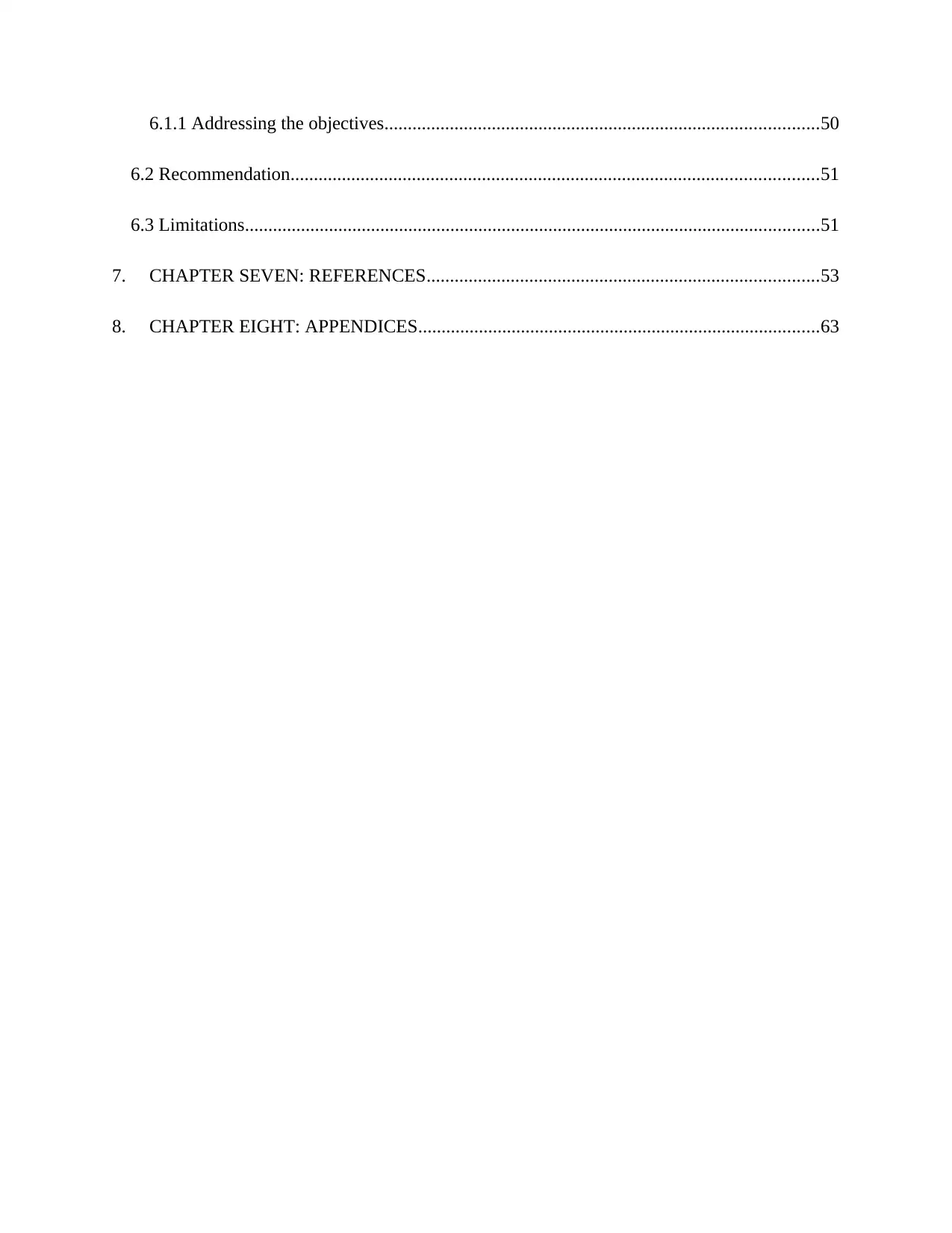
6.1.1 Addressing the objectives.............................................................................................50
6.2 Recommendation.................................................................................................................51
6.3 Limitations...........................................................................................................................51
7. CHAPTER SEVEN: REFERENCES....................................................................................53
8. CHAPTER EIGHT: APPENDICES......................................................................................63
6.2 Recommendation.................................................................................................................51
6.3 Limitations...........................................................................................................................51
7. CHAPTER SEVEN: REFERENCES....................................................................................53
8. CHAPTER EIGHT: APPENDICES......................................................................................63
Paraphrase This Document
Need a fresh take? Get an instant paraphrase of this document with our AI Paraphraser
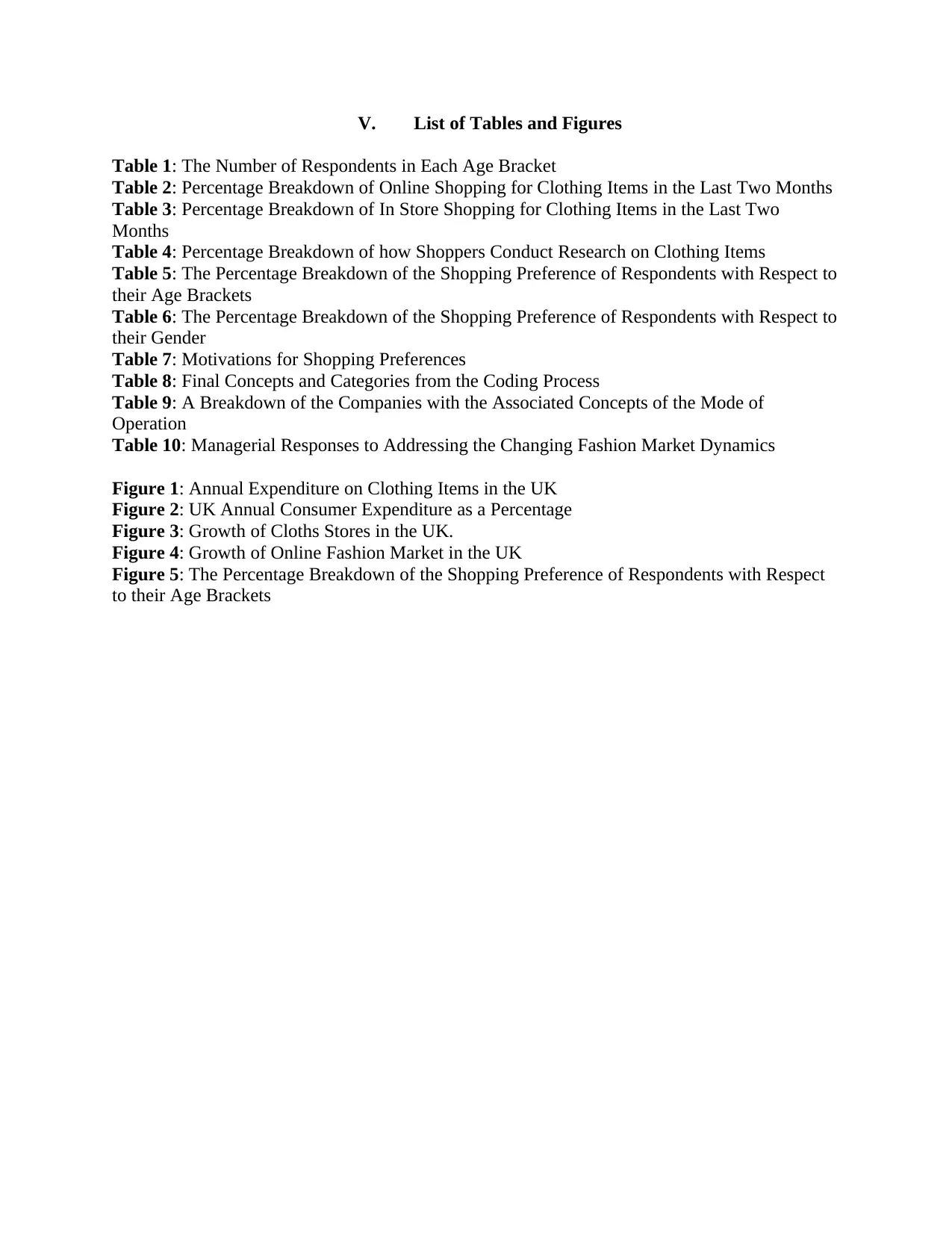
V. List of Tables and Figures
Table 1: The Number of Respondents in Each Age Bracket
Table 2: Percentage Breakdown of Online Shopping for Clothing Items in the Last Two Months
Table 3: Percentage Breakdown of In Store Shopping for Clothing Items in the Last Two
Months
Table 4: Percentage Breakdown of how Shoppers Conduct Research on Clothing Items
Table 5: The Percentage Breakdown of the Shopping Preference of Respondents with Respect to
their Age Brackets
Table 6: The Percentage Breakdown of the Shopping Preference of Respondents with Respect to
their Gender
Table 7: Motivations for Shopping Preferences
Table 8: Final Concepts and Categories from the Coding Process
Table 9: A Breakdown of the Companies with the Associated Concepts of the Mode of
Operation
Table 10: Managerial Responses to Addressing the Changing Fashion Market Dynamics
Figure 1: Annual Expenditure on Clothing Items in the UK
Figure 2: UK Annual Consumer Expenditure as a Percentage
Figure 3: Growth of Cloths Stores in the UK.
Figure 4: Growth of Online Fashion Market in the UK
Figure 5: The Percentage Breakdown of the Shopping Preference of Respondents with Respect
to their Age Brackets
Table 1: The Number of Respondents in Each Age Bracket
Table 2: Percentage Breakdown of Online Shopping for Clothing Items in the Last Two Months
Table 3: Percentage Breakdown of In Store Shopping for Clothing Items in the Last Two
Months
Table 4: Percentage Breakdown of how Shoppers Conduct Research on Clothing Items
Table 5: The Percentage Breakdown of the Shopping Preference of Respondents with Respect to
their Age Brackets
Table 6: The Percentage Breakdown of the Shopping Preference of Respondents with Respect to
their Gender
Table 7: Motivations for Shopping Preferences
Table 8: Final Concepts and Categories from the Coding Process
Table 9: A Breakdown of the Companies with the Associated Concepts of the Mode of
Operation
Table 10: Managerial Responses to Addressing the Changing Fashion Market Dynamics
Figure 1: Annual Expenditure on Clothing Items in the UK
Figure 2: UK Annual Consumer Expenditure as a Percentage
Figure 3: Growth of Cloths Stores in the UK.
Figure 4: Growth of Online Fashion Market in the UK
Figure 5: The Percentage Breakdown of the Shopping Preference of Respondents with Respect
to their Age Brackets
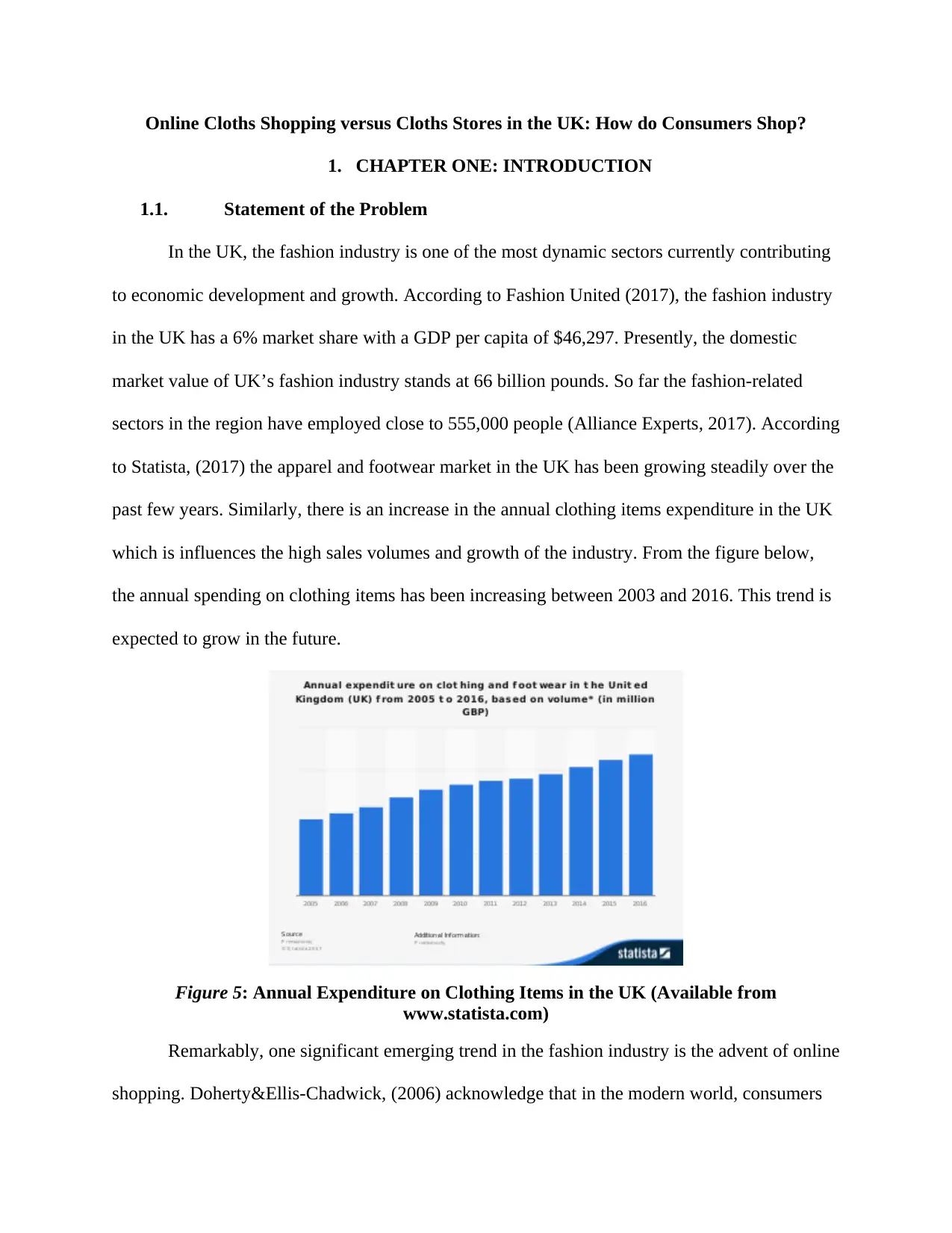
Online Cloths Shopping versus Cloths Stores in the UK: How do Consumers Shop?
1. CHAPTER ONE: INTRODUCTION
1.1. Statement of the Problem
In the UK, the fashion industry is one of the most dynamic sectors currently contributing
to economic development and growth. According to Fashion United (2017), the fashion industry
in the UK has a 6% market share with a GDP per capita of $46,297. Presently, the domestic
market value of UK’s fashion industry stands at 66 billion pounds. So far the fashion-related
sectors in the region have employed close to 555,000 people (Alliance Experts, 2017). According
to Statista, (2017) the apparel and footwear market in the UK has been growing steadily over the
past few years. Similarly, there is an increase in the annual clothing items expenditure in the UK
which is influences the high sales volumes and growth of the industry. From the figure below,
the annual spending on clothing items has been increasing between 2003 and 2016. This trend is
expected to grow in the future.
Figure 5: Annual Expenditure on Clothing Items in the UK (Available from
www.statista.com)
Remarkably, one significant emerging trend in the fashion industry is the advent of online
shopping. Doherty&Ellis-Chadwick, (2006) acknowledge that in the modern world, consumers
1. CHAPTER ONE: INTRODUCTION
1.1. Statement of the Problem
In the UK, the fashion industry is one of the most dynamic sectors currently contributing
to economic development and growth. According to Fashion United (2017), the fashion industry
in the UK has a 6% market share with a GDP per capita of $46,297. Presently, the domestic
market value of UK’s fashion industry stands at 66 billion pounds. So far the fashion-related
sectors in the region have employed close to 555,000 people (Alliance Experts, 2017). According
to Statista, (2017) the apparel and footwear market in the UK has been growing steadily over the
past few years. Similarly, there is an increase in the annual clothing items expenditure in the UK
which is influences the high sales volumes and growth of the industry. From the figure below,
the annual spending on clothing items has been increasing between 2003 and 2016. This trend is
expected to grow in the future.
Figure 5: Annual Expenditure on Clothing Items in the UK (Available from
www.statista.com)
Remarkably, one significant emerging trend in the fashion industry is the advent of online
shopping. Doherty&Ellis-Chadwick, (2006) acknowledge that in the modern world, consumers
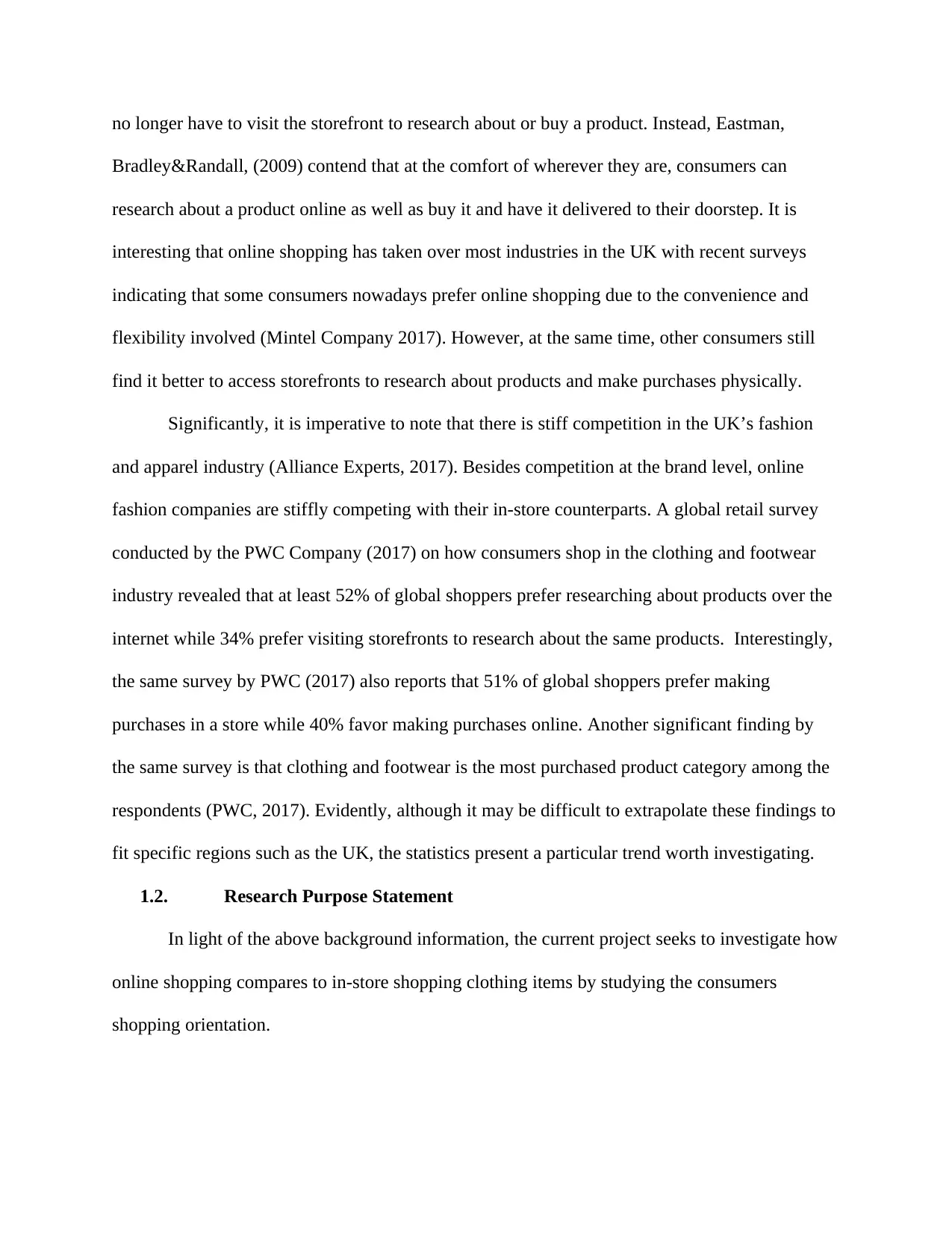
no longer have to visit the storefront to research about or buy a product. Instead, Eastman,
Bradley&Randall, (2009) contend that at the comfort of wherever they are, consumers can
research about a product online as well as buy it and have it delivered to their doorstep. It is
interesting that online shopping has taken over most industries in the UK with recent surveys
indicating that some consumers nowadays prefer online shopping due to the convenience and
flexibility involved (Mintel Company 2017). However, at the same time, other consumers still
find it better to access storefronts to research about products and make purchases physically.
Significantly, it is imperative to note that there is stiff competition in the UK’s fashion
and apparel industry (Alliance Experts, 2017). Besides competition at the brand level, online
fashion companies are stiffly competing with their in-store counterparts. A global retail survey
conducted by the PWC Company (2017) on how consumers shop in the clothing and footwear
industry revealed that at least 52% of global shoppers prefer researching about products over the
internet while 34% prefer visiting storefronts to research about the same products. Interestingly,
the same survey by PWC (2017) also reports that 51% of global shoppers prefer making
purchases in a store while 40% favor making purchases online. Another significant finding by
the same survey is that clothing and footwear is the most purchased product category among the
respondents (PWC, 2017). Evidently, although it may be difficult to extrapolate these findings to
fit specific regions such as the UK, the statistics present a particular trend worth investigating.
1.2. Research Purpose Statement
In light of the above background information, the current project seeks to investigate how
online shopping compares to in-store shopping clothing items by studying the consumers
shopping orientation.
Bradley&Randall, (2009) contend that at the comfort of wherever they are, consumers can
research about a product online as well as buy it and have it delivered to their doorstep. It is
interesting that online shopping has taken over most industries in the UK with recent surveys
indicating that some consumers nowadays prefer online shopping due to the convenience and
flexibility involved (Mintel Company 2017). However, at the same time, other consumers still
find it better to access storefronts to research about products and make purchases physically.
Significantly, it is imperative to note that there is stiff competition in the UK’s fashion
and apparel industry (Alliance Experts, 2017). Besides competition at the brand level, online
fashion companies are stiffly competing with their in-store counterparts. A global retail survey
conducted by the PWC Company (2017) on how consumers shop in the clothing and footwear
industry revealed that at least 52% of global shoppers prefer researching about products over the
internet while 34% prefer visiting storefronts to research about the same products. Interestingly,
the same survey by PWC (2017) also reports that 51% of global shoppers prefer making
purchases in a store while 40% favor making purchases online. Another significant finding by
the same survey is that clothing and footwear is the most purchased product category among the
respondents (PWC, 2017). Evidently, although it may be difficult to extrapolate these findings to
fit specific regions such as the UK, the statistics present a particular trend worth investigating.
1.2. Research Purpose Statement
In light of the above background information, the current project seeks to investigate how
online shopping compares to in-store shopping clothing items by studying the consumers
shopping orientation.
Secure Best Marks with AI Grader
Need help grading? Try our AI Grader for instant feedback on your assignments.

1.3. Rationale of the Study
According toDavis, (1989) the advent of information technology was meant to make life
easier and better for human beings. Hence, online shopping is intended to provide convenience
and flexibility to consumers. However, despite all the advantages of online shopping, research
studies and surveys indicate that relatively most consumers still prefer making their purchases in
stores (PWC, 2017). It is interesting, therefore, to compare online shopping to in-store shopping
of clothing items based on how consumers make their purchases. From such a viewpoint,
players in the fashion industry could find value in the study’s recommendations on how well to
approach their business operations to maximize sales volumes, returns, and profits.
Notably, in the UK, the fashion industry makes a significant contribution to economic
growth and development (Fahion United, 2017). Therefore, given that online shopping and in-
store shopping are entirely fragmenting the fashion and apparel industry, it is fundamental to
determine how to strike a balance between the two. It is important for stakeholders in the UK’s
fashion industry to comprehend the dynamics of the sector and the implications of online
shopping versus in-store shopping of clothing items.
1.4. Research Questions and Objectives
The main purpose of this research is to establish how online cloths shopping and in store
cloths shopping in the UK compare by determining how consumers shop. Therefore, the main
research question is: How do UK consumers shop for cloths and related products? Hence, the
researcher seeks to achieve the following specific objectives.
i. To identify whether UK consumers prefer online cloths shopping or in-store cloths
shopping
According toDavis, (1989) the advent of information technology was meant to make life
easier and better for human beings. Hence, online shopping is intended to provide convenience
and flexibility to consumers. However, despite all the advantages of online shopping, research
studies and surveys indicate that relatively most consumers still prefer making their purchases in
stores (PWC, 2017). It is interesting, therefore, to compare online shopping to in-store shopping
of clothing items based on how consumers make their purchases. From such a viewpoint,
players in the fashion industry could find value in the study’s recommendations on how well to
approach their business operations to maximize sales volumes, returns, and profits.
Notably, in the UK, the fashion industry makes a significant contribution to economic
growth and development (Fahion United, 2017). Therefore, given that online shopping and in-
store shopping are entirely fragmenting the fashion and apparel industry, it is fundamental to
determine how to strike a balance between the two. It is important for stakeholders in the UK’s
fashion industry to comprehend the dynamics of the sector and the implications of online
shopping versus in-store shopping of clothing items.
1.4. Research Questions and Objectives
The main purpose of this research is to establish how online cloths shopping and in store
cloths shopping in the UK compare by determining how consumers shop. Therefore, the main
research question is: How do UK consumers shop for cloths and related products? Hence, the
researcher seeks to achieve the following specific objectives.
i. To identify whether UK consumers prefer online cloths shopping or in-store cloths
shopping

ii. To determine the motivations and rationale for the consumer’s decision on the type of
shopping style
iii. To establish the implications of the trends for businesses in the UK’s fashion retail
industry
Concerning the same, the researcher also seeks to answer specific research questions to guide the
conduct of the study. These research questions are listed below.
i. How do UK consumers shop for their clothing items; in-store or through the internet?
ii. What are the motivations and rationale for the consumer’s decision on the type of
shopping style?
iii. How do businesses in the UK’s fashion retail industry cope with the fragmented
shopping Orientation of consumers?
It is imperative to note that these specific research questions only act as a guide to the study and
ensure that the research purpose and objectives have been efficiently accomplished.
After this introductory section, the next stage is the literature review section, which
compares, contrasts, analyzes, and critiques arguments and findings from previous scholarly
works on the research topic. The third chapter delineates the methodology assumed by the
researcher. The study utilizes mixed methods involving both qualitative and quantitative
techniques which are detailed in this section. The fourth chapter is the findings section which
presents what the researcher has found from the project. The fifth chapter presents the analysis
section of the project detailing the qualitative and quantitative data analysis techniques and
procedures used in the study. The final section presents the conclusion and recommendation part,
which, besides recapping the entire report, provides potential practical implications of the study
findings.
shopping style
iii. To establish the implications of the trends for businesses in the UK’s fashion retail
industry
Concerning the same, the researcher also seeks to answer specific research questions to guide the
conduct of the study. These research questions are listed below.
i. How do UK consumers shop for their clothing items; in-store or through the internet?
ii. What are the motivations and rationale for the consumer’s decision on the type of
shopping style?
iii. How do businesses in the UK’s fashion retail industry cope with the fragmented
shopping Orientation of consumers?
It is imperative to note that these specific research questions only act as a guide to the study and
ensure that the research purpose and objectives have been efficiently accomplished.
After this introductory section, the next stage is the literature review section, which
compares, contrasts, analyzes, and critiques arguments and findings from previous scholarly
works on the research topic. The third chapter delineates the methodology assumed by the
researcher. The study utilizes mixed methods involving both qualitative and quantitative
techniques which are detailed in this section. The fourth chapter is the findings section which
presents what the researcher has found from the project. The fifth chapter presents the analysis
section of the project detailing the qualitative and quantitative data analysis techniques and
procedures used in the study. The final section presents the conclusion and recommendation part,
which, besides recapping the entire report, provides potential practical implications of the study
findings.
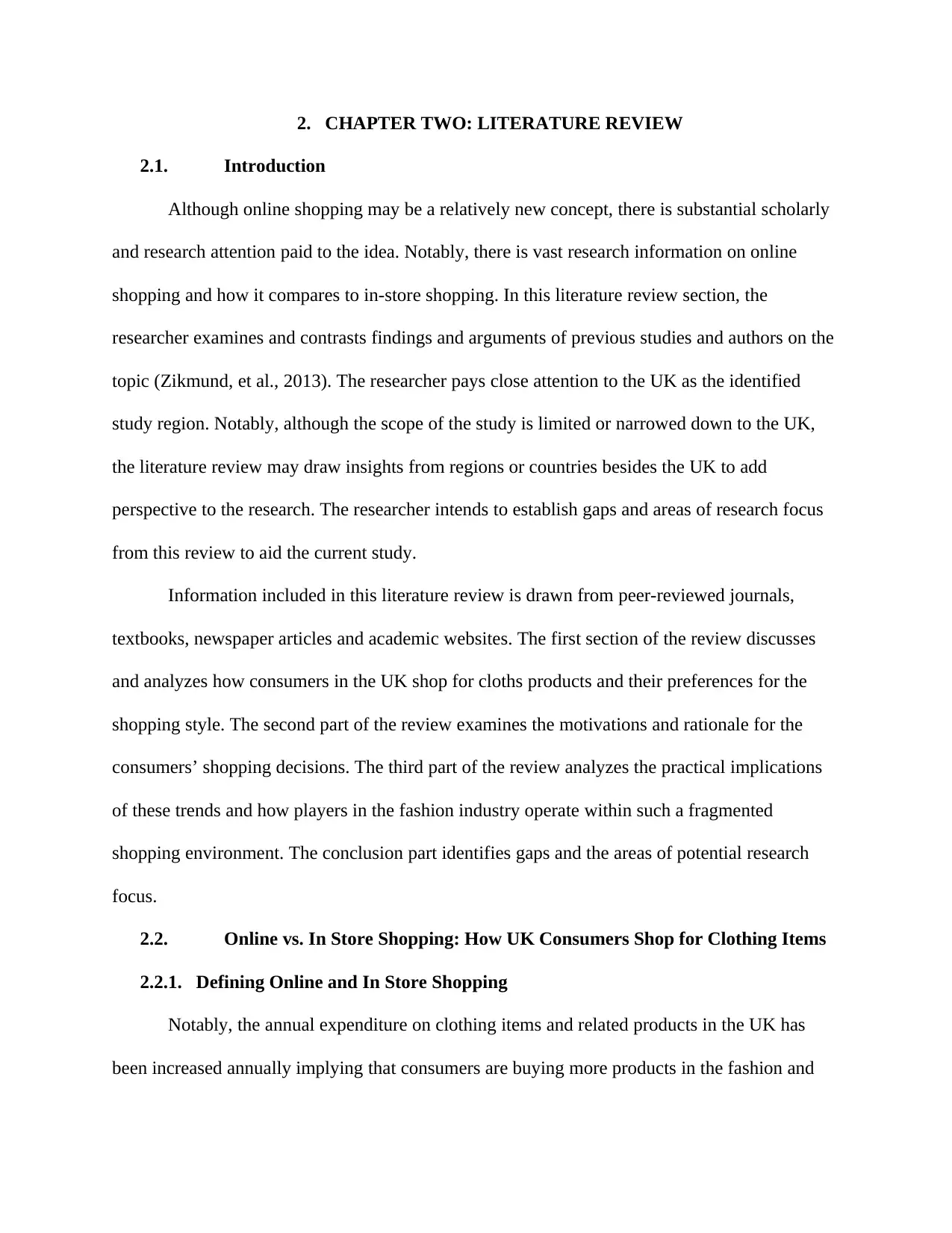
2. CHAPTER TWO: LITERATURE REVIEW
2.1. Introduction
Although online shopping may be a relatively new concept, there is substantial scholarly
and research attention paid to the idea. Notably, there is vast research information on online
shopping and how it compares to in-store shopping. In this literature review section, the
researcher examines and contrasts findings and arguments of previous studies and authors on the
topic (Zikmund, et al., 2013). The researcher pays close attention to the UK as the identified
study region. Notably, although the scope of the study is limited or narrowed down to the UK,
the literature review may draw insights from regions or countries besides the UK to add
perspective to the research. The researcher intends to establish gaps and areas of research focus
from this review to aid the current study.
Information included in this literature review is drawn from peer-reviewed journals,
textbooks, newspaper articles and academic websites. The first section of the review discusses
and analyzes how consumers in the UK shop for cloths products and their preferences for the
shopping style. The second part of the review examines the motivations and rationale for the
consumers’ shopping decisions. The third part of the review analyzes the practical implications
of these trends and how players in the fashion industry operate within such a fragmented
shopping environment. The conclusion part identifies gaps and the areas of potential research
focus.
2.2. Online vs. In Store Shopping: How UK Consumers Shop for Clothing Items
2.2.1. Defining Online and In Store Shopping
Notably, the annual expenditure on clothing items and related products in the UK has
been increased annually implying that consumers are buying more products in the fashion and
2.1. Introduction
Although online shopping may be a relatively new concept, there is substantial scholarly
and research attention paid to the idea. Notably, there is vast research information on online
shopping and how it compares to in-store shopping. In this literature review section, the
researcher examines and contrasts findings and arguments of previous studies and authors on the
topic (Zikmund, et al., 2013). The researcher pays close attention to the UK as the identified
study region. Notably, although the scope of the study is limited or narrowed down to the UK,
the literature review may draw insights from regions or countries besides the UK to add
perspective to the research. The researcher intends to establish gaps and areas of research focus
from this review to aid the current study.
Information included in this literature review is drawn from peer-reviewed journals,
textbooks, newspaper articles and academic websites. The first section of the review discusses
and analyzes how consumers in the UK shop for cloths products and their preferences for the
shopping style. The second part of the review examines the motivations and rationale for the
consumers’ shopping decisions. The third part of the review analyzes the practical implications
of these trends and how players in the fashion industry operate within such a fragmented
shopping environment. The conclusion part identifies gaps and the areas of potential research
focus.
2.2. Online vs. In Store Shopping: How UK Consumers Shop for Clothing Items
2.2.1. Defining Online and In Store Shopping
Notably, the annual expenditure on clothing items and related products in the UK has
been increased annually implying that consumers are buying more products in the fashion and
Paraphrase This Document
Need a fresh take? Get an instant paraphrase of this document with our AI Paraphraser
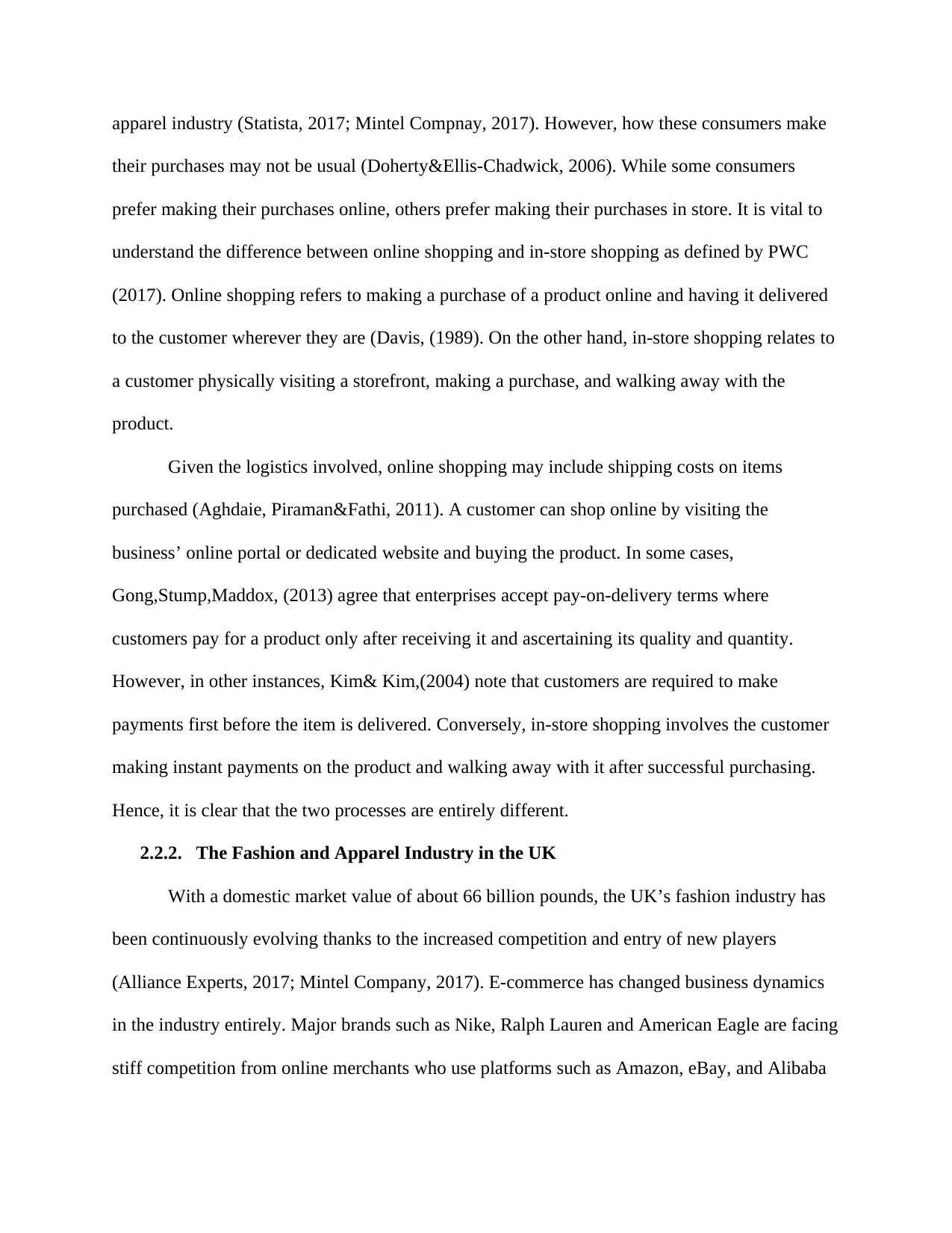
apparel industry (Statista, 2017; Mintel Compnay, 2017). However, how these consumers make
their purchases may not be usual (Doherty&Ellis-Chadwick, 2006). While some consumers
prefer making their purchases online, others prefer making their purchases in store. It is vital to
understand the difference between online shopping and in-store shopping as defined by PWC
(2017). Online shopping refers to making a purchase of a product online and having it delivered
to the customer wherever they are (Davis, (1989). On the other hand, in-store shopping relates to
a customer physically visiting a storefront, making a purchase, and walking away with the
product.
Given the logistics involved, online shopping may include shipping costs on items
purchased (Aghdaie, Piraman&Fathi, 2011). A customer can shop online by visiting the
business’ online portal or dedicated website and buying the product. In some cases,
Gong,Stump,Maddox, (2013) agree that enterprises accept pay-on-delivery terms where
customers pay for a product only after receiving it and ascertaining its quality and quantity.
However, in other instances, Kim& Kim,(2004) note that customers are required to make
payments first before the item is delivered. Conversely, in-store shopping involves the customer
making instant payments on the product and walking away with it after successful purchasing.
Hence, it is clear that the two processes are entirely different.
2.2.2. The Fashion and Apparel Industry in the UK
With a domestic market value of about 66 billion pounds, the UK’s fashion industry has
been continuously evolving thanks to the increased competition and entry of new players
(Alliance Experts, 2017; Mintel Company, 2017). E-commerce has changed business dynamics
in the industry entirely. Major brands such as Nike, Ralph Lauren and American Eagle are facing
stiff competition from online merchants who use platforms such as Amazon, eBay, and Alibaba
their purchases may not be usual (Doherty&Ellis-Chadwick, 2006). While some consumers
prefer making their purchases online, others prefer making their purchases in store. It is vital to
understand the difference between online shopping and in-store shopping as defined by PWC
(2017). Online shopping refers to making a purchase of a product online and having it delivered
to the customer wherever they are (Davis, (1989). On the other hand, in-store shopping relates to
a customer physically visiting a storefront, making a purchase, and walking away with the
product.
Given the logistics involved, online shopping may include shipping costs on items
purchased (Aghdaie, Piraman&Fathi, 2011). A customer can shop online by visiting the
business’ online portal or dedicated website and buying the product. In some cases,
Gong,Stump,Maddox, (2013) agree that enterprises accept pay-on-delivery terms where
customers pay for a product only after receiving it and ascertaining its quality and quantity.
However, in other instances, Kim& Kim,(2004) note that customers are required to make
payments first before the item is delivered. Conversely, in-store shopping involves the customer
making instant payments on the product and walking away with it after successful purchasing.
Hence, it is clear that the two processes are entirely different.
2.2.2. The Fashion and Apparel Industry in the UK
With a domestic market value of about 66 billion pounds, the UK’s fashion industry has
been continuously evolving thanks to the increased competition and entry of new players
(Alliance Experts, 2017; Mintel Company, 2017). E-commerce has changed business dynamics
in the industry entirely. Major brands such as Nike, Ralph Lauren and American Eagle are facing
stiff competition from online merchants who use platforms such as Amazon, eBay, and Alibaba
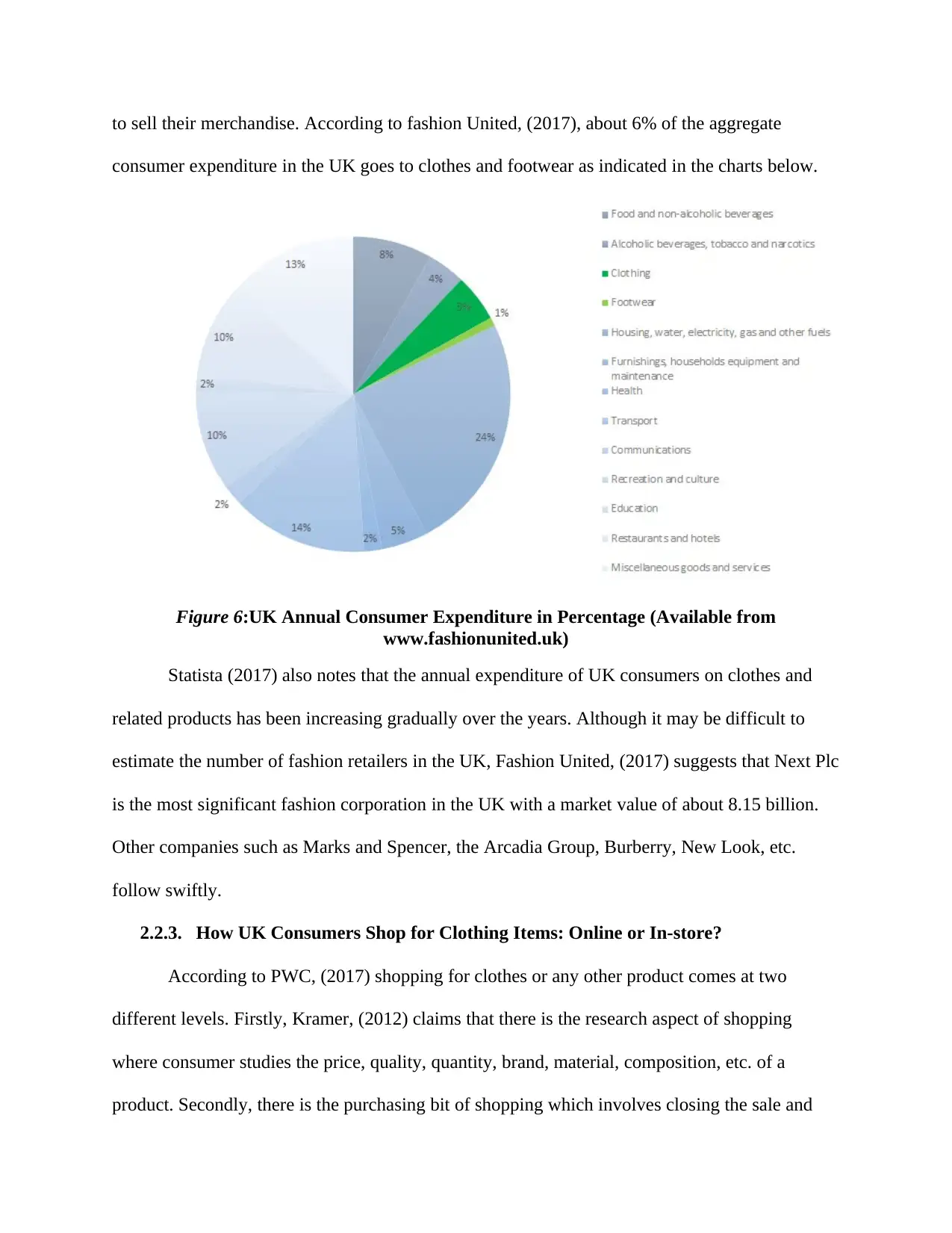
to sell their merchandise. According to fashion United, (2017), about 6% of the aggregate
consumer expenditure in the UK goes to clothes and footwear as indicated in the charts below.
Figure 6:UK Annual Consumer Expenditure in Percentage (Available from
www.fashionunited.uk)
Statista (2017) also notes that the annual expenditure of UK consumers on clothes and
related products has been increasing gradually over the years. Although it may be difficult to
estimate the number of fashion retailers in the UK, Fashion United, (2017) suggests that Next Plc
is the most significant fashion corporation in the UK with a market value of about 8.15 billion.
Other companies such as Marks and Spencer, the Arcadia Group, Burberry, New Look, etc.
follow swiftly.
2.2.3. How UK Consumers Shop for Clothing Items: Online or In-store?
According to PWC, (2017) shopping for clothes or any other product comes at two
different levels. Firstly, Kramer, (2012) claims that there is the research aspect of shopping
where consumer studies the price, quality, quantity, brand, material, composition, etc. of a
product. Secondly, there is the purchasing bit of shopping which involves closing the sale and
consumer expenditure in the UK goes to clothes and footwear as indicated in the charts below.
Figure 6:UK Annual Consumer Expenditure in Percentage (Available from
www.fashionunited.uk)
Statista (2017) also notes that the annual expenditure of UK consumers on clothes and
related products has been increasing gradually over the years. Although it may be difficult to
estimate the number of fashion retailers in the UK, Fashion United, (2017) suggests that Next Plc
is the most significant fashion corporation in the UK with a market value of about 8.15 billion.
Other companies such as Marks and Spencer, the Arcadia Group, Burberry, New Look, etc.
follow swiftly.
2.2.3. How UK Consumers Shop for Clothing Items: Online or In-store?
According to PWC, (2017) shopping for clothes or any other product comes at two
different levels. Firstly, Kramer, (2012) claims that there is the research aspect of shopping
where consumer studies the price, quality, quantity, brand, material, composition, etc. of a
product. Secondly, there is the purchasing bit of shopping which involves closing the sale and
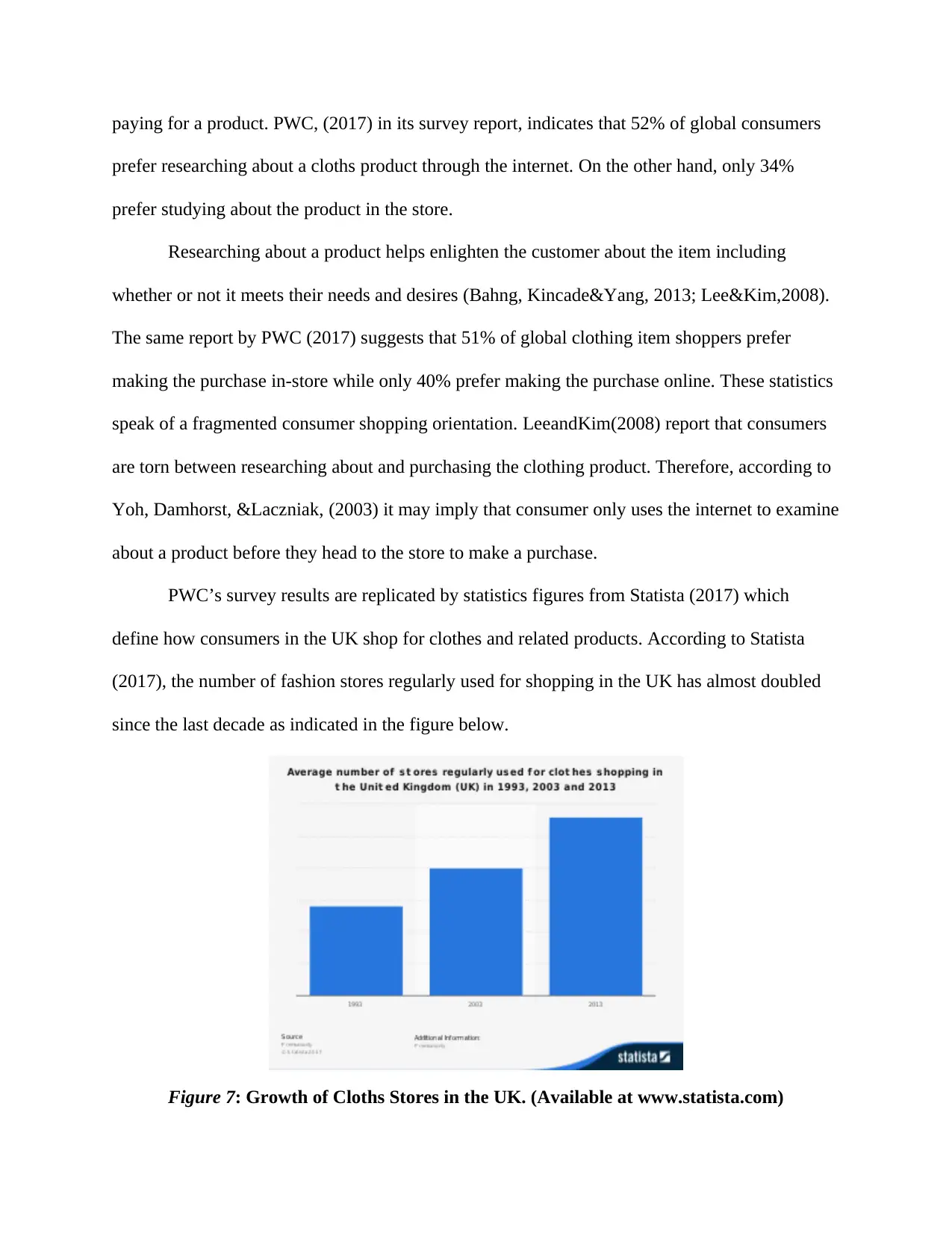
paying for a product. PWC, (2017) in its survey report, indicates that 52% of global consumers
prefer researching about a cloths product through the internet. On the other hand, only 34%
prefer studying about the product in the store.
Researching about a product helps enlighten the customer about the item including
whether or not it meets their needs and desires (Bahng, Kincade&Yang, 2013; Lee&Kim,2008).
The same report by PWC (2017) suggests that 51% of global clothing item shoppers prefer
making the purchase in-store while only 40% prefer making the purchase online. These statistics
speak of a fragmented consumer shopping orientation. LeeandKim(2008) report that consumers
are torn between researching about and purchasing the clothing product. Therefore, according to
Yoh, Damhorst, &Laczniak, (2003) it may imply that consumer only uses the internet to examine
about a product before they head to the store to make a purchase.
PWC’s survey results are replicated by statistics figures from Statista (2017) which
define how consumers in the UK shop for clothes and related products. According to Statista
(2017), the number of fashion stores regularly used for shopping in the UK has almost doubled
since the last decade as indicated in the figure below.
Figure 7: Growth of Cloths Stores in the UK. (Available at www.statista.com)
prefer researching about a cloths product through the internet. On the other hand, only 34%
prefer studying about the product in the store.
Researching about a product helps enlighten the customer about the item including
whether or not it meets their needs and desires (Bahng, Kincade&Yang, 2013; Lee&Kim,2008).
The same report by PWC (2017) suggests that 51% of global clothing item shoppers prefer
making the purchase in-store while only 40% prefer making the purchase online. These statistics
speak of a fragmented consumer shopping orientation. LeeandKim(2008) report that consumers
are torn between researching about and purchasing the clothing product. Therefore, according to
Yoh, Damhorst, &Laczniak, (2003) it may imply that consumer only uses the internet to examine
about a product before they head to the store to make a purchase.
PWC’s survey results are replicated by statistics figures from Statista (2017) which
define how consumers in the UK shop for clothes and related products. According to Statista
(2017), the number of fashion stores regularly used for shopping in the UK has almost doubled
since the last decade as indicated in the figure below.
Figure 7: Growth of Cloths Stores in the UK. (Available at www.statista.com)
Secure Best Marks with AI Grader
Need help grading? Try our AI Grader for instant feedback on your assignments.
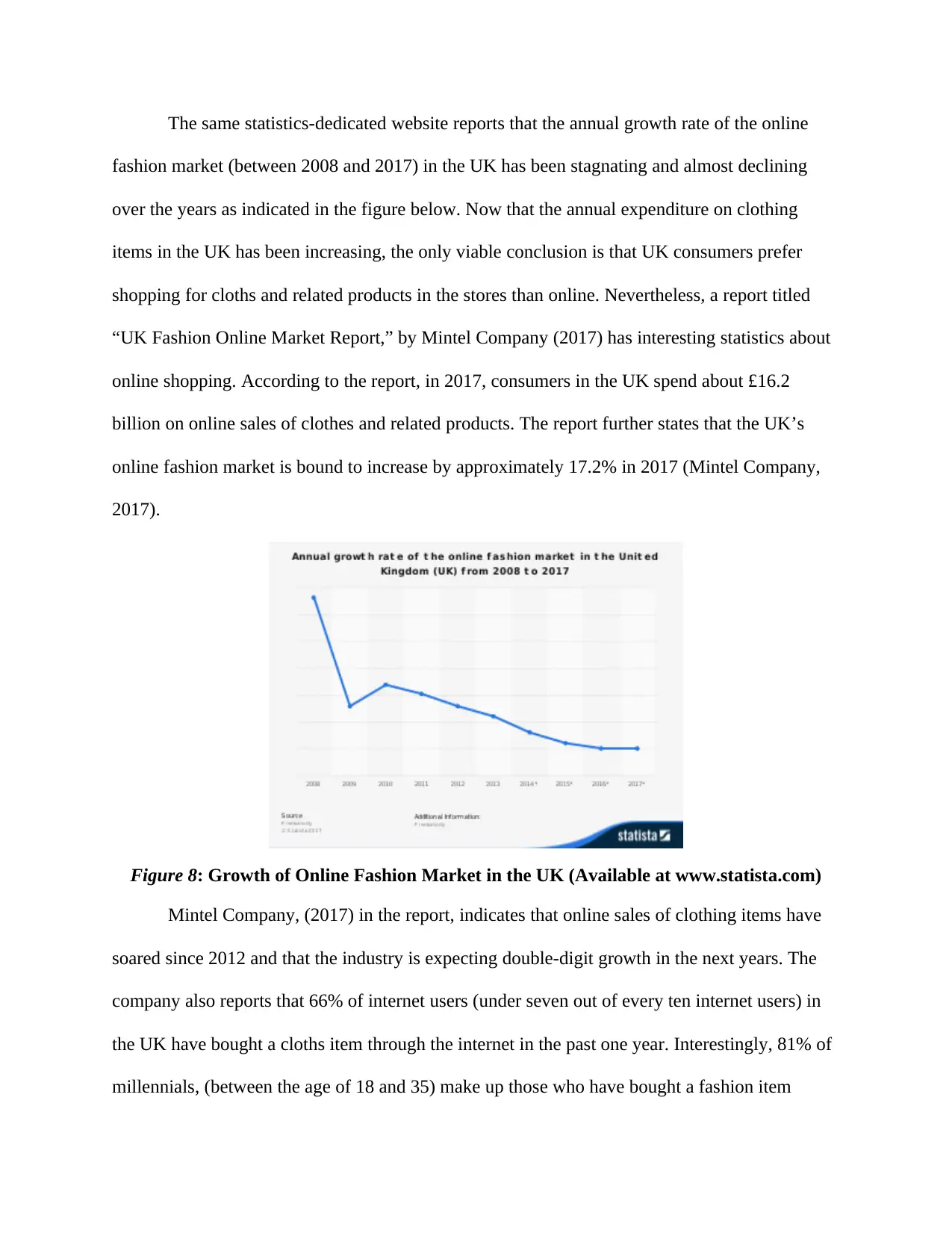
The same statistics-dedicated website reports that the annual growth rate of the online
fashion market (between 2008 and 2017) in the UK has been stagnating and almost declining
over the years as indicated in the figure below. Now that the annual expenditure on clothing
items in the UK has been increasing, the only viable conclusion is that UK consumers prefer
shopping for cloths and related products in the stores than online. Nevertheless, a report titled
“UK Fashion Online Market Report,” by Mintel Company (2017) has interesting statistics about
online shopping. According to the report, in 2017, consumers in the UK spend about £16.2
billion on online sales of clothes and related products. The report further states that the UK’s
online fashion market is bound to increase by approximately 17.2% in 2017 (Mintel Company,
2017).
Figure 8: Growth of Online Fashion Market in the UK (Available at www.statista.com)
Mintel Company, (2017) in the report, indicates that online sales of clothing items have
soared since 2012 and that the industry is expecting double-digit growth in the next years. The
company also reports that 66% of internet users (under seven out of every ten internet users) in
the UK have bought a cloths item through the internet in the past one year. Interestingly, 81% of
millennials, (between the age of 18 and 35) make up those who have bought a fashion item
fashion market (between 2008 and 2017) in the UK has been stagnating and almost declining
over the years as indicated in the figure below. Now that the annual expenditure on clothing
items in the UK has been increasing, the only viable conclusion is that UK consumers prefer
shopping for cloths and related products in the stores than online. Nevertheless, a report titled
“UK Fashion Online Market Report,” by Mintel Company (2017) has interesting statistics about
online shopping. According to the report, in 2017, consumers in the UK spend about £16.2
billion on online sales of clothes and related products. The report further states that the UK’s
online fashion market is bound to increase by approximately 17.2% in 2017 (Mintel Company,
2017).
Figure 8: Growth of Online Fashion Market in the UK (Available at www.statista.com)
Mintel Company, (2017) in the report, indicates that online sales of clothing items have
soared since 2012 and that the industry is expecting double-digit growth in the next years. The
company also reports that 66% of internet users (under seven out of every ten internet users) in
the UK have bought a cloths item through the internet in the past one year. Interestingly, 81% of
millennials, (between the age of 18 and 35) make up those who have bought a fashion item
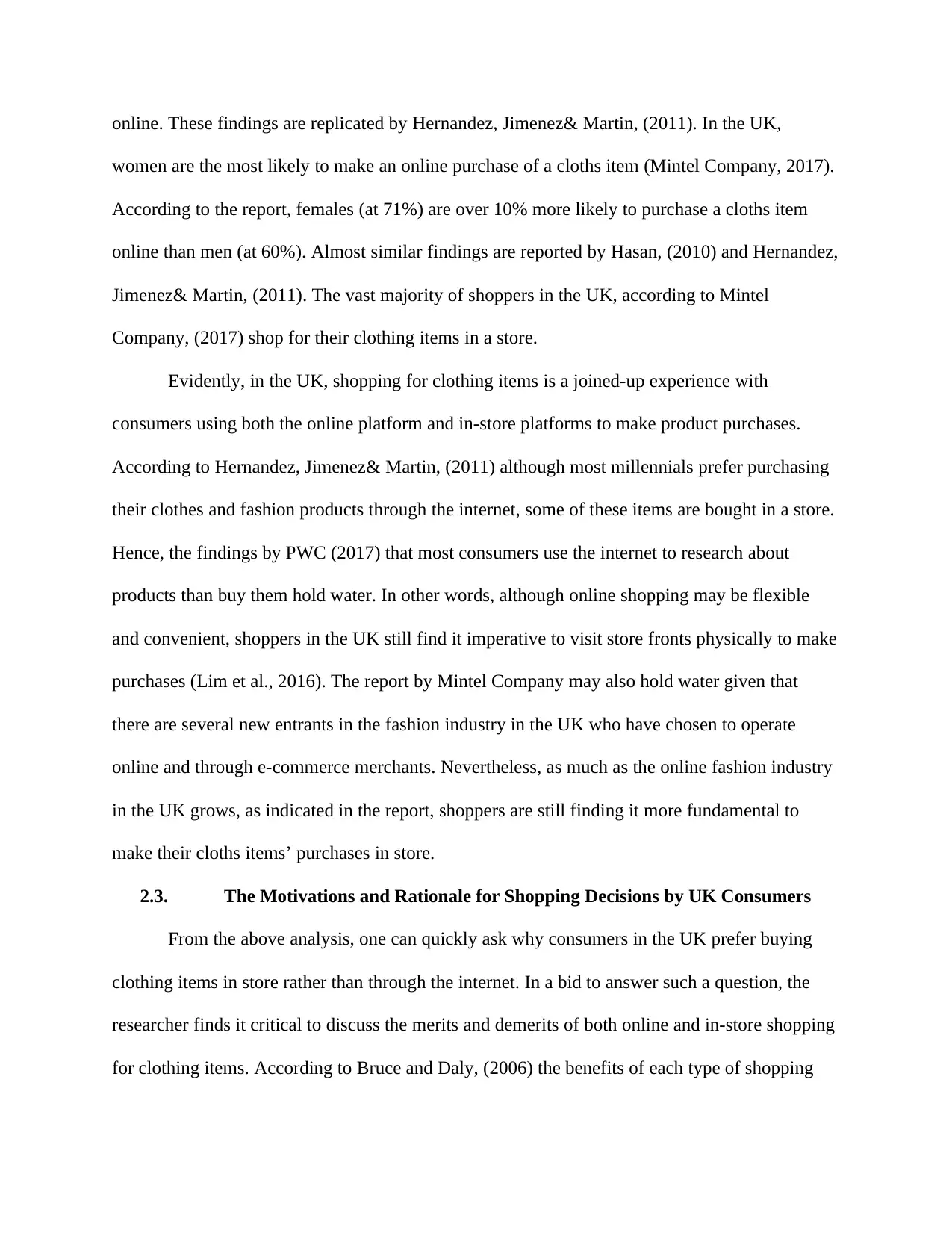
online. These findings are replicated by Hernandez, Jimenez& Martin, (2011). In the UK,
women are the most likely to make an online purchase of a cloths item (Mintel Company, 2017).
According to the report, females (at 71%) are over 10% more likely to purchase a cloths item
online than men (at 60%). Almost similar findings are reported by Hasan, (2010) and Hernandez,
Jimenez& Martin, (2011). The vast majority of shoppers in the UK, according to Mintel
Company, (2017) shop for their clothing items in a store.
Evidently, in the UK, shopping for clothing items is a joined-up experience with
consumers using both the online platform and in-store platforms to make product purchases.
According to Hernandez, Jimenez& Martin, (2011) although most millennials prefer purchasing
their clothes and fashion products through the internet, some of these items are bought in a store.
Hence, the findings by PWC (2017) that most consumers use the internet to research about
products than buy them hold water. In other words, although online shopping may be flexible
and convenient, shoppers in the UK still find it imperative to visit store fronts physically to make
purchases (Lim et al., 2016). The report by Mintel Company may also hold water given that
there are several new entrants in the fashion industry in the UK who have chosen to operate
online and through e-commerce merchants. Nevertheless, as much as the online fashion industry
in the UK grows, as indicated in the report, shoppers are still finding it more fundamental to
make their cloths items’ purchases in store.
2.3. The Motivations and Rationale for Shopping Decisions by UK Consumers
From the above analysis, one can quickly ask why consumers in the UK prefer buying
clothing items in store rather than through the internet. In a bid to answer such a question, the
researcher finds it critical to discuss the merits and demerits of both online and in-store shopping
for clothing items. According to Bruce and Daly, (2006) the benefits of each type of shopping
women are the most likely to make an online purchase of a cloths item (Mintel Company, 2017).
According to the report, females (at 71%) are over 10% more likely to purchase a cloths item
online than men (at 60%). Almost similar findings are reported by Hasan, (2010) and Hernandez,
Jimenez& Martin, (2011). The vast majority of shoppers in the UK, according to Mintel
Company, (2017) shop for their clothing items in a store.
Evidently, in the UK, shopping for clothing items is a joined-up experience with
consumers using both the online platform and in-store platforms to make product purchases.
According to Hernandez, Jimenez& Martin, (2011) although most millennials prefer purchasing
their clothes and fashion products through the internet, some of these items are bought in a store.
Hence, the findings by PWC (2017) that most consumers use the internet to research about
products than buy them hold water. In other words, although online shopping may be flexible
and convenient, shoppers in the UK still find it imperative to visit store fronts physically to make
purchases (Lim et al., 2016). The report by Mintel Company may also hold water given that
there are several new entrants in the fashion industry in the UK who have chosen to operate
online and through e-commerce merchants. Nevertheless, as much as the online fashion industry
in the UK grows, as indicated in the report, shoppers are still finding it more fundamental to
make their cloths items’ purchases in store.
2.3. The Motivations and Rationale for Shopping Decisions by UK Consumers
From the above analysis, one can quickly ask why consumers in the UK prefer buying
clothing items in store rather than through the internet. In a bid to answer such a question, the
researcher finds it critical to discuss the merits and demerits of both online and in-store shopping
for clothing items. According to Bruce and Daly, (2006) the benefits of each type of shopping

delineate why consumers prefer the particular kind of shopping. On the other hand, Diallo and
others, (2013) note that the demerits describe why consumers detest a specific type of shopping.
Researchers who have focused on this particular thematic area have asked their respondents the
benefits and limitations of each type of shopping experience (Dialo, et al., 2013; Bruce & Daly,
2006; Liu, Burns&Hou, 2013; Gong,Stump &Maddox, 2013; Eastman, Bradley&Randall, 2009).
Mowenand Minor, (1998) argue that the benefits represent the “reasons for” while the limitations
represent the “reasons against” specific kind of shopping experience.
2.3.1. The Merits of Online Shopping
Every researcher who has studied the benefits of online shopping has reported that the
experience is incredibly convenient. According to Gong,Stump &Maddox, (2013) with online
shopping, consumers can make purchases at any time of the day wherever they are; meaning that
they do not have to worry about the store being closed. Solomon and others (2011) acknowledge
that online shopping for clothes and related items also offers an infinite choice that may not be
accessible in a store. With online shopping, the variety of products is almost limitless meaning
that consumers can quickly get what they want (Qin, et al, 2014).
Importantly, Sarkar & Das, (2017) who compare online shopping to in-store shopping,
assert that online shopping gives the consumer a chance to make quick price comparisons from
different vendors, which is impossible with in-store shopping. Consumers hence have an
opportunity to compare product prices among merchants to choose the best. Some online cloths
items may be heavily discounted or come with several offers such as cash back and free delivery
which are all beneficial to the consumer (Arthur, 1996). Lastly, with online shopping, there are
no pressure sales by eager salespeople who awkwardly position customers. Therefore, online
shopping means that the shopper has complete control of their shopping experiences.
others, (2013) note that the demerits describe why consumers detest a specific type of shopping.
Researchers who have focused on this particular thematic area have asked their respondents the
benefits and limitations of each type of shopping experience (Dialo, et al., 2013; Bruce & Daly,
2006; Liu, Burns&Hou, 2013; Gong,Stump &Maddox, 2013; Eastman, Bradley&Randall, 2009).
Mowenand Minor, (1998) argue that the benefits represent the “reasons for” while the limitations
represent the “reasons against” specific kind of shopping experience.
2.3.1. The Merits of Online Shopping
Every researcher who has studied the benefits of online shopping has reported that the
experience is incredibly convenient. According to Gong,Stump &Maddox, (2013) with online
shopping, consumers can make purchases at any time of the day wherever they are; meaning that
they do not have to worry about the store being closed. Solomon and others (2011) acknowledge
that online shopping for clothes and related items also offers an infinite choice that may not be
accessible in a store. With online shopping, the variety of products is almost limitless meaning
that consumers can quickly get what they want (Qin, et al, 2014).
Importantly, Sarkar & Das, (2017) who compare online shopping to in-store shopping,
assert that online shopping gives the consumer a chance to make quick price comparisons from
different vendors, which is impossible with in-store shopping. Consumers hence have an
opportunity to compare product prices among merchants to choose the best. Some online cloths
items may be heavily discounted or come with several offers such as cash back and free delivery
which are all beneficial to the consumer (Arthur, 1996). Lastly, with online shopping, there are
no pressure sales by eager salespeople who awkwardly position customers. Therefore, online
shopping means that the shopper has complete control of their shopping experiences.
Paraphrase This Document
Need a fresh take? Get an instant paraphrase of this document with our AI Paraphraser
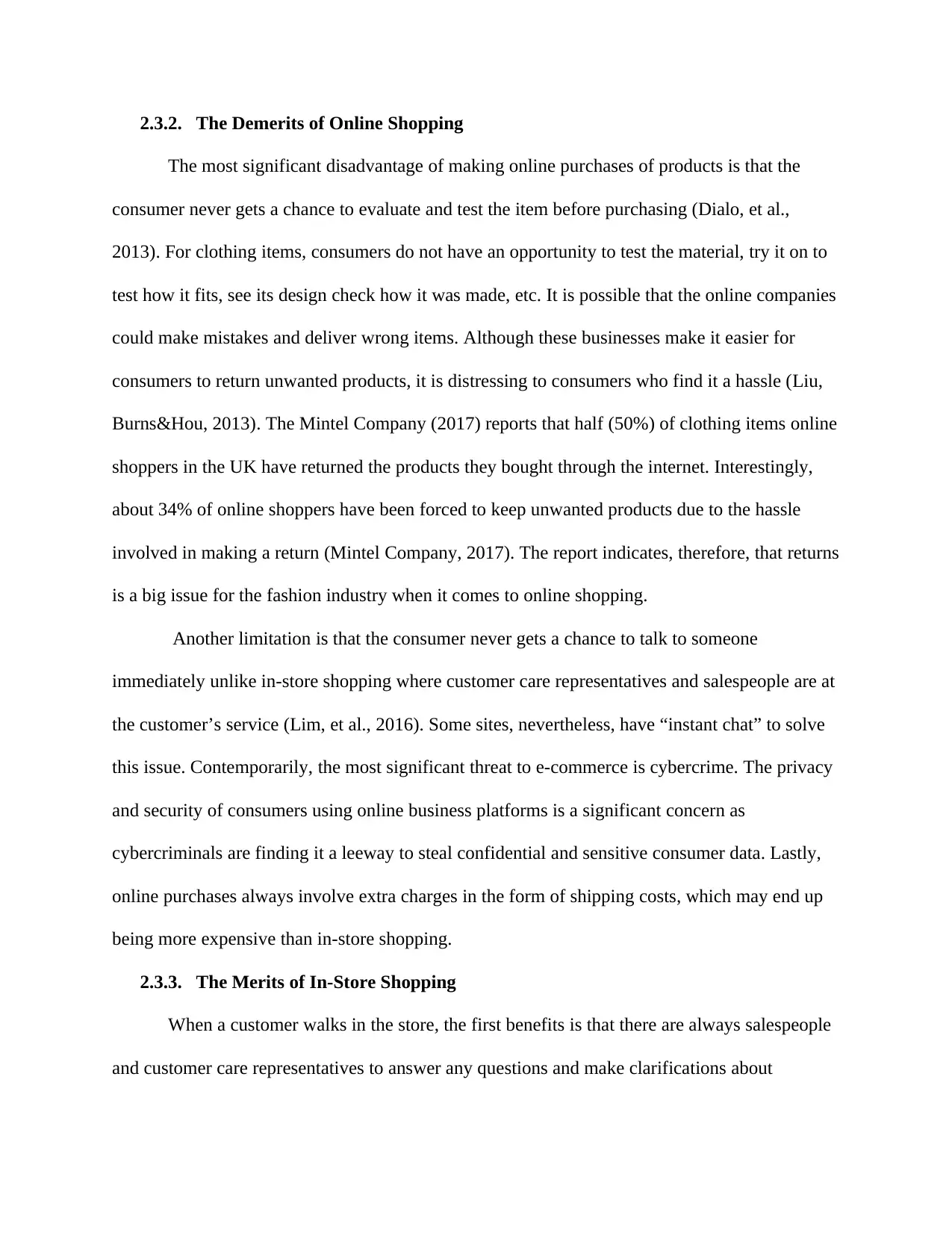
2.3.2. The Demerits of Online Shopping
The most significant disadvantage of making online purchases of products is that the
consumer never gets a chance to evaluate and test the item before purchasing (Dialo, et al.,
2013). For clothing items, consumers do not have an opportunity to test the material, try it on to
test how it fits, see its design check how it was made, etc. It is possible that the online companies
could make mistakes and deliver wrong items. Although these businesses make it easier for
consumers to return unwanted products, it is distressing to consumers who find it a hassle (Liu,
Burns&Hou, 2013). The Mintel Company (2017) reports that half (50%) of clothing items online
shoppers in the UK have returned the products they bought through the internet. Interestingly,
about 34% of online shoppers have been forced to keep unwanted products due to the hassle
involved in making a return (Mintel Company, 2017). The report indicates, therefore, that returns
is a big issue for the fashion industry when it comes to online shopping.
Another limitation is that the consumer never gets a chance to talk to someone
immediately unlike in-store shopping where customer care representatives and salespeople are at
the customer’s service (Lim, et al., 2016). Some sites, nevertheless, have “instant chat” to solve
this issue. Contemporarily, the most significant threat to e-commerce is cybercrime. The privacy
and security of consumers using online business platforms is a significant concern as
cybercriminals are finding it a leeway to steal confidential and sensitive consumer data. Lastly,
online purchases always involve extra charges in the form of shipping costs, which may end up
being more expensive than in-store shopping.
2.3.3. The Merits of In-Store Shopping
When a customer walks in the store, the first benefits is that there are always salespeople
and customer care representatives to answer any questions and make clarifications about
The most significant disadvantage of making online purchases of products is that the
consumer never gets a chance to evaluate and test the item before purchasing (Dialo, et al.,
2013). For clothing items, consumers do not have an opportunity to test the material, try it on to
test how it fits, see its design check how it was made, etc. It is possible that the online companies
could make mistakes and deliver wrong items. Although these businesses make it easier for
consumers to return unwanted products, it is distressing to consumers who find it a hassle (Liu,
Burns&Hou, 2013). The Mintel Company (2017) reports that half (50%) of clothing items online
shoppers in the UK have returned the products they bought through the internet. Interestingly,
about 34% of online shoppers have been forced to keep unwanted products due to the hassle
involved in making a return (Mintel Company, 2017). The report indicates, therefore, that returns
is a big issue for the fashion industry when it comes to online shopping.
Another limitation is that the consumer never gets a chance to talk to someone
immediately unlike in-store shopping where customer care representatives and salespeople are at
the customer’s service (Lim, et al., 2016). Some sites, nevertheless, have “instant chat” to solve
this issue. Contemporarily, the most significant threat to e-commerce is cybercrime. The privacy
and security of consumers using online business platforms is a significant concern as
cybercriminals are finding it a leeway to steal confidential and sensitive consumer data. Lastly,
online purchases always involve extra charges in the form of shipping costs, which may end up
being more expensive than in-store shopping.
2.3.3. The Merits of In-Store Shopping
When a customer walks in the store, the first benefits is that there are always salespeople
and customer care representatives to answer any questions and make clarifications about
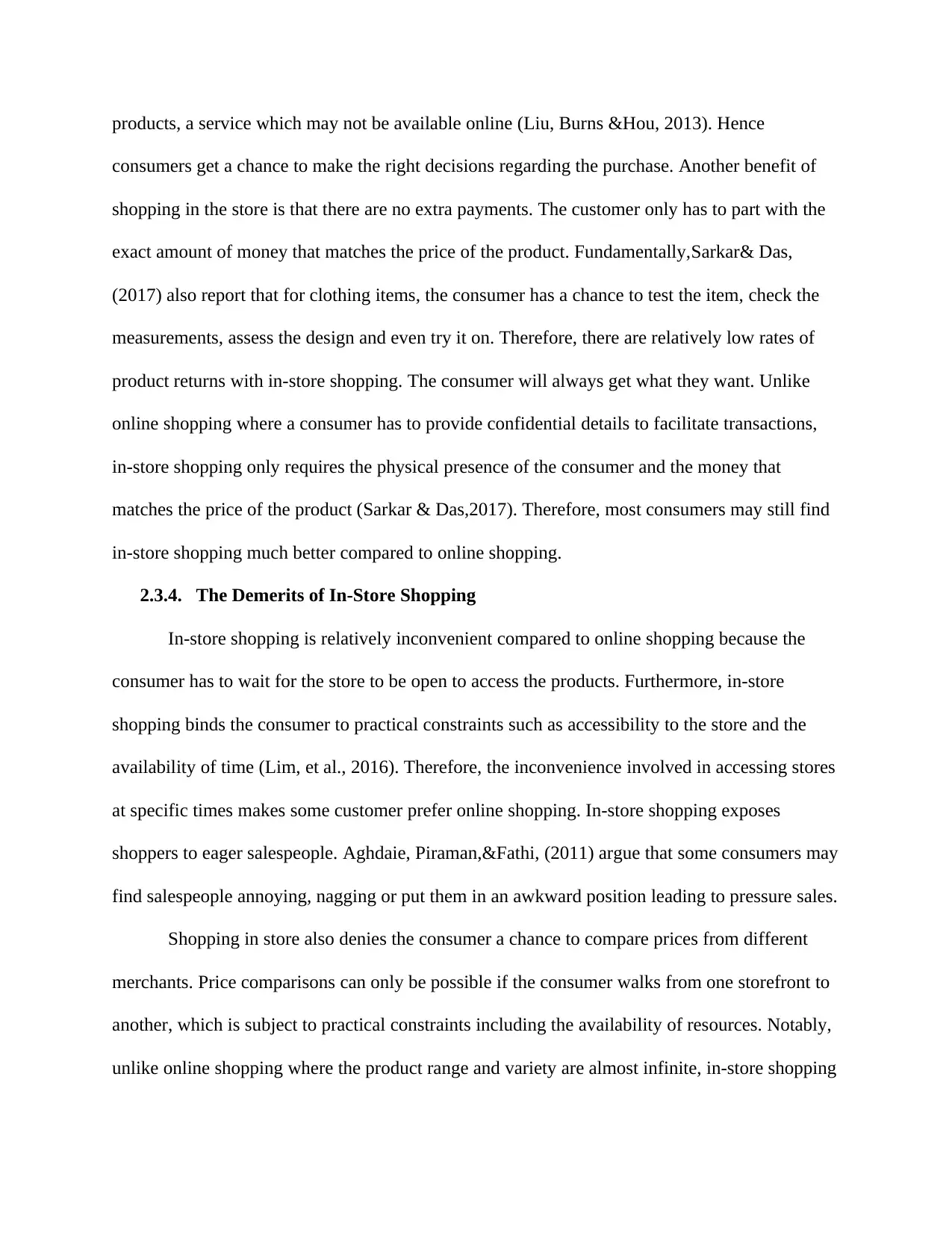
products, a service which may not be available online (Liu, Burns &Hou, 2013). Hence
consumers get a chance to make the right decisions regarding the purchase. Another benefit of
shopping in the store is that there are no extra payments. The customer only has to part with the
exact amount of money that matches the price of the product. Fundamentally,Sarkar& Das,
(2017) also report that for clothing items, the consumer has a chance to test the item, check the
measurements, assess the design and even try it on. Therefore, there are relatively low rates of
product returns with in-store shopping. The consumer will always get what they want. Unlike
online shopping where a consumer has to provide confidential details to facilitate transactions,
in-store shopping only requires the physical presence of the consumer and the money that
matches the price of the product (Sarkar & Das,2017). Therefore, most consumers may still find
in-store shopping much better compared to online shopping.
2.3.4. The Demerits of In-Store Shopping
In-store shopping is relatively inconvenient compared to online shopping because the
consumer has to wait for the store to be open to access the products. Furthermore, in-store
shopping binds the consumer to practical constraints such as accessibility to the store and the
availability of time (Lim, et al., 2016). Therefore, the inconvenience involved in accessing stores
at specific times makes some customer prefer online shopping. In-store shopping exposes
shoppers to eager salespeople. Aghdaie, Piraman,&Fathi, (2011) argue that some consumers may
find salespeople annoying, nagging or put them in an awkward position leading to pressure sales.
Shopping in store also denies the consumer a chance to compare prices from different
merchants. Price comparisons can only be possible if the consumer walks from one storefront to
another, which is subject to practical constraints including the availability of resources. Notably,
unlike online shopping where the product range and variety are almost infinite, in-store shopping
consumers get a chance to make the right decisions regarding the purchase. Another benefit of
shopping in the store is that there are no extra payments. The customer only has to part with the
exact amount of money that matches the price of the product. Fundamentally,Sarkar& Das,
(2017) also report that for clothing items, the consumer has a chance to test the item, check the
measurements, assess the design and even try it on. Therefore, there are relatively low rates of
product returns with in-store shopping. The consumer will always get what they want. Unlike
online shopping where a consumer has to provide confidential details to facilitate transactions,
in-store shopping only requires the physical presence of the consumer and the money that
matches the price of the product (Sarkar & Das,2017). Therefore, most consumers may still find
in-store shopping much better compared to online shopping.
2.3.4. The Demerits of In-Store Shopping
In-store shopping is relatively inconvenient compared to online shopping because the
consumer has to wait for the store to be open to access the products. Furthermore, in-store
shopping binds the consumer to practical constraints such as accessibility to the store and the
availability of time (Lim, et al., 2016). Therefore, the inconvenience involved in accessing stores
at specific times makes some customer prefer online shopping. In-store shopping exposes
shoppers to eager salespeople. Aghdaie, Piraman,&Fathi, (2011) argue that some consumers may
find salespeople annoying, nagging or put them in an awkward position leading to pressure sales.
Shopping in store also denies the consumer a chance to compare prices from different
merchants. Price comparisons can only be possible if the consumer walks from one storefront to
another, which is subject to practical constraints including the availability of resources. Notably,
unlike online shopping where the product range and variety are almost infinite, in-store shopping
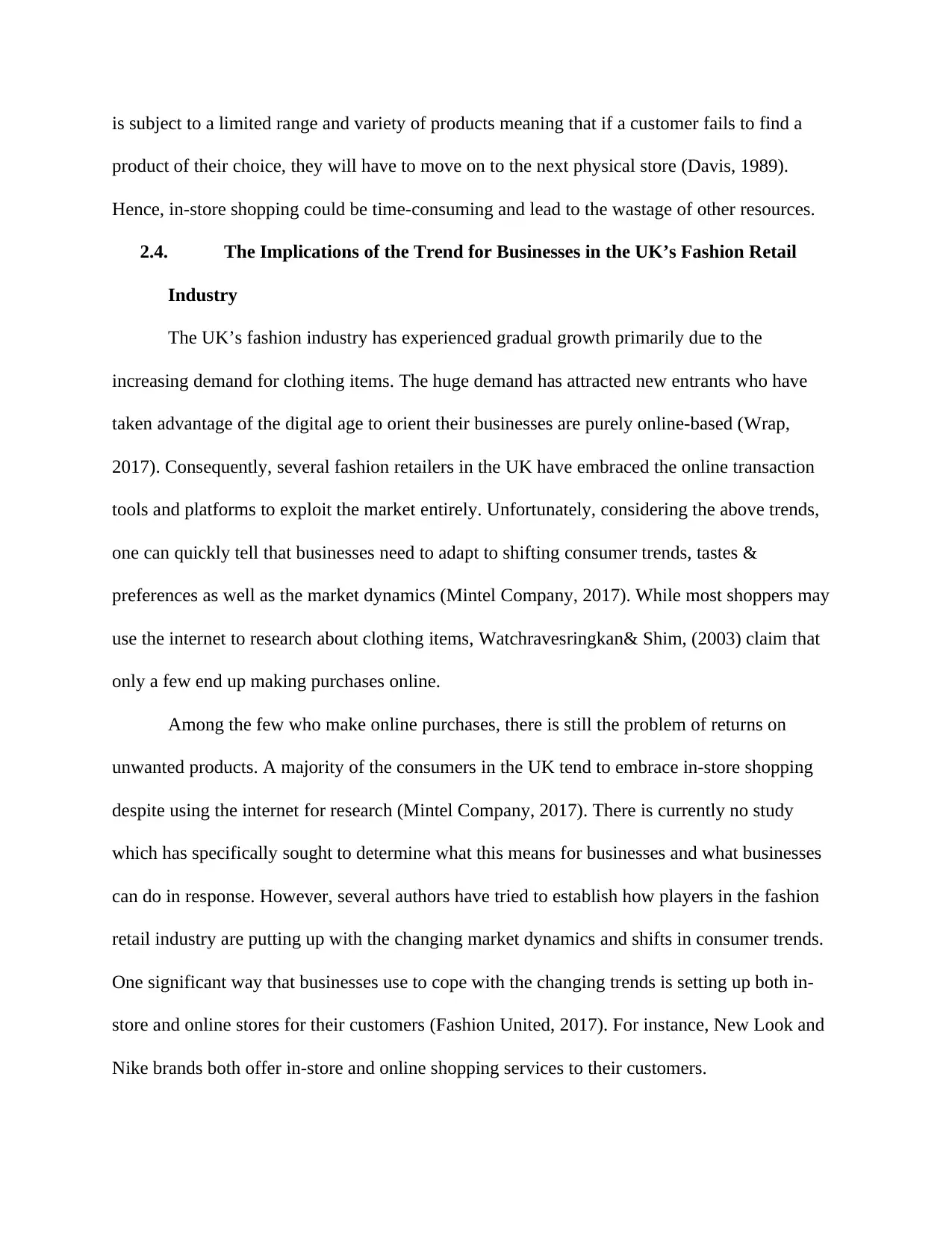
is subject to a limited range and variety of products meaning that if a customer fails to find a
product of their choice, they will have to move on to the next physical store (Davis, 1989).
Hence, in-store shopping could be time-consuming and lead to the wastage of other resources.
2.4. The Implications of the Trend for Businesses in the UK’s Fashion Retail
Industry
The UK’s fashion industry has experienced gradual growth primarily due to the
increasing demand for clothing items. The huge demand has attracted new entrants who have
taken advantage of the digital age to orient their businesses are purely online-based (Wrap,
2017). Consequently, several fashion retailers in the UK have embraced the online transaction
tools and platforms to exploit the market entirely. Unfortunately, considering the above trends,
one can quickly tell that businesses need to adapt to shifting consumer trends, tastes &
preferences as well as the market dynamics (Mintel Company, 2017). While most shoppers may
use the internet to research about clothing items, Watchravesringkan& Shim, (2003) claim that
only a few end up making purchases online.
Among the few who make online purchases, there is still the problem of returns on
unwanted products. A majority of the consumers in the UK tend to embrace in-store shopping
despite using the internet for research (Mintel Company, 2017). There is currently no study
which has specifically sought to determine what this means for businesses and what businesses
can do in response. However, several authors have tried to establish how players in the fashion
retail industry are putting up with the changing market dynamics and shifts in consumer trends.
One significant way that businesses use to cope with the changing trends is setting up both in-
store and online stores for their customers (Fashion United, 2017). For instance, New Look and
Nike brands both offer in-store and online shopping services to their customers.
product of their choice, they will have to move on to the next physical store (Davis, 1989).
Hence, in-store shopping could be time-consuming and lead to the wastage of other resources.
2.4. The Implications of the Trend for Businesses in the UK’s Fashion Retail
Industry
The UK’s fashion industry has experienced gradual growth primarily due to the
increasing demand for clothing items. The huge demand has attracted new entrants who have
taken advantage of the digital age to orient their businesses are purely online-based (Wrap,
2017). Consequently, several fashion retailers in the UK have embraced the online transaction
tools and platforms to exploit the market entirely. Unfortunately, considering the above trends,
one can quickly tell that businesses need to adapt to shifting consumer trends, tastes &
preferences as well as the market dynamics (Mintel Company, 2017). While most shoppers may
use the internet to research about clothing items, Watchravesringkan& Shim, (2003) claim that
only a few end up making purchases online.
Among the few who make online purchases, there is still the problem of returns on
unwanted products. A majority of the consumers in the UK tend to embrace in-store shopping
despite using the internet for research (Mintel Company, 2017). There is currently no study
which has specifically sought to determine what this means for businesses and what businesses
can do in response. However, several authors have tried to establish how players in the fashion
retail industry are putting up with the changing market dynamics and shifts in consumer trends.
One significant way that businesses use to cope with the changing trends is setting up both in-
store and online stores for their customers (Fashion United, 2017). For instance, New Look and
Nike brands both offer in-store and online shopping services to their customers.
Secure Best Marks with AI Grader
Need help grading? Try our AI Grader for instant feedback on your assignments.
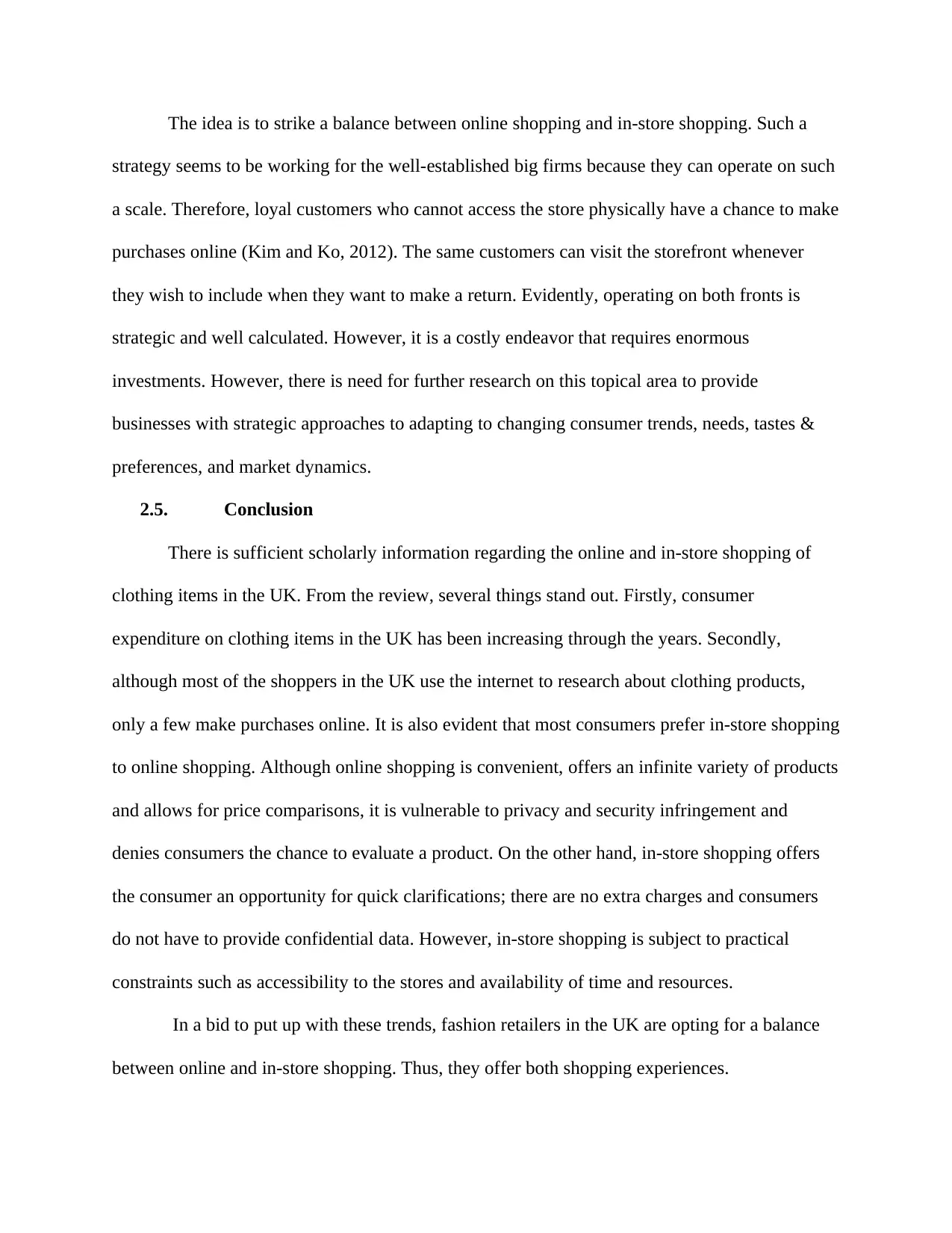
The idea is to strike a balance between online shopping and in-store shopping. Such a
strategy seems to be working for the well-established big firms because they can operate on such
a scale. Therefore, loyal customers who cannot access the store physically have a chance to make
purchases online (Kim and Ko, 2012). The same customers can visit the storefront whenever
they wish to include when they want to make a return. Evidently, operating on both fronts is
strategic and well calculated. However, it is a costly endeavor that requires enormous
investments. However, there is need for further research on this topical area to provide
businesses with strategic approaches to adapting to changing consumer trends, needs, tastes &
preferences, and market dynamics.
2.5. Conclusion
There is sufficient scholarly information regarding the online and in-store shopping of
clothing items in the UK. From the review, several things stand out. Firstly, consumer
expenditure on clothing items in the UK has been increasing through the years. Secondly,
although most of the shoppers in the UK use the internet to research about clothing products,
only a few make purchases online. It is also evident that most consumers prefer in-store shopping
to online shopping. Although online shopping is convenient, offers an infinite variety of products
and allows for price comparisons, it is vulnerable to privacy and security infringement and
denies consumers the chance to evaluate a product. On the other hand, in-store shopping offers
the consumer an opportunity for quick clarifications; there are no extra charges and consumers
do not have to provide confidential data. However, in-store shopping is subject to practical
constraints such as accessibility to the stores and availability of time and resources.
In a bid to put up with these trends, fashion retailers in the UK are opting for a balance
between online and in-store shopping. Thus, they offer both shopping experiences.
strategy seems to be working for the well-established big firms because they can operate on such
a scale. Therefore, loyal customers who cannot access the store physically have a chance to make
purchases online (Kim and Ko, 2012). The same customers can visit the storefront whenever
they wish to include when they want to make a return. Evidently, operating on both fronts is
strategic and well calculated. However, it is a costly endeavor that requires enormous
investments. However, there is need for further research on this topical area to provide
businesses with strategic approaches to adapting to changing consumer trends, needs, tastes &
preferences, and market dynamics.
2.5. Conclusion
There is sufficient scholarly information regarding the online and in-store shopping of
clothing items in the UK. From the review, several things stand out. Firstly, consumer
expenditure on clothing items in the UK has been increasing through the years. Secondly,
although most of the shoppers in the UK use the internet to research about clothing products,
only a few make purchases online. It is also evident that most consumers prefer in-store shopping
to online shopping. Although online shopping is convenient, offers an infinite variety of products
and allows for price comparisons, it is vulnerable to privacy and security infringement and
denies consumers the chance to evaluate a product. On the other hand, in-store shopping offers
the consumer an opportunity for quick clarifications; there are no extra charges and consumers
do not have to provide confidential data. However, in-store shopping is subject to practical
constraints such as accessibility to the stores and availability of time and resources.
In a bid to put up with these trends, fashion retailers in the UK are opting for a balance
between online and in-store shopping. Thus, they offer both shopping experiences.

Unfortunately, this topic area is mainly underdeveloped regarding research. Hence, the most
fundamental area of research focus for the current study is to determine how businesses can
adapt to the changing consumer trends and preferences. Another gap that needs to be filled is the
lack of conformity between statistics on the position of the online fashion retail market. It is vital
to determine whether or not the online fashion market is stagnating as suggested by Statista
(2017) or is improving as indicated by the Mintel Company (2017). Lastly, although information
on the research topic is sufficient, it is not exhaustive. Therefore, the researcher anticipates that
the current study will help fill up the gaps in existing literature as well as provide as much
information as possible on the research topic.
fundamental area of research focus for the current study is to determine how businesses can
adapt to the changing consumer trends and preferences. Another gap that needs to be filled is the
lack of conformity between statistics on the position of the online fashion retail market. It is vital
to determine whether or not the online fashion market is stagnating as suggested by Statista
(2017) or is improving as indicated by the Mintel Company (2017). Lastly, although information
on the research topic is sufficient, it is not exhaustive. Therefore, the researcher anticipates that
the current study will help fill up the gaps in existing literature as well as provide as much
information as possible on the research topic.
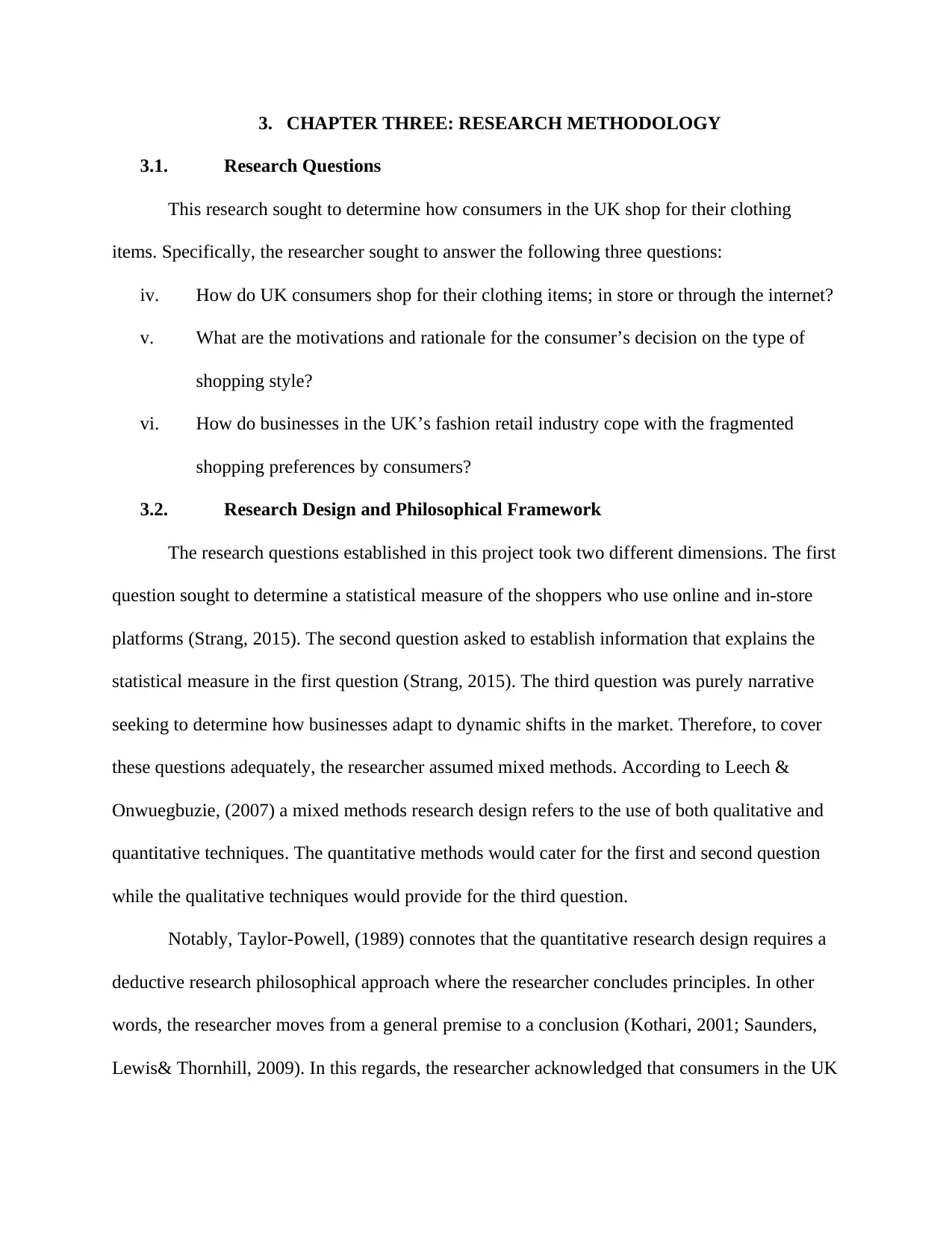
3. CHAPTER THREE: RESEARCH METHODOLOGY
3.1. Research Questions
This research sought to determine how consumers in the UK shop for their clothing
items. Specifically, the researcher sought to answer the following three questions:
iv. How do UK consumers shop for their clothing items; in store or through the internet?
v. What are the motivations and rationale for the consumer’s decision on the type of
shopping style?
vi. How do businesses in the UK’s fashion retail industry cope with the fragmented
shopping preferences by consumers?
3.2. Research Design and Philosophical Framework
The research questions established in this project took two different dimensions. The first
question sought to determine a statistical measure of the shoppers who use online and in-store
platforms (Strang, 2015). The second question asked to establish information that explains the
statistical measure in the first question (Strang, 2015). The third question was purely narrative
seeking to determine how businesses adapt to dynamic shifts in the market. Therefore, to cover
these questions adequately, the researcher assumed mixed methods. According to Leech &
Onwuegbuzie, (2007) a mixed methods research design refers to the use of both qualitative and
quantitative techniques. The quantitative methods would cater for the first and second question
while the qualitative techniques would provide for the third question.
Notably, Taylor-Powell, (1989) connotes that the quantitative research design requires a
deductive research philosophical approach where the researcher concludes principles. In other
words, the researcher moves from a general premise to a conclusion (Kothari, 2001; Saunders,
Lewis& Thornhill, 2009). In this regards, the researcher acknowledged that consumers in the UK
3.1. Research Questions
This research sought to determine how consumers in the UK shop for their clothing
items. Specifically, the researcher sought to answer the following three questions:
iv. How do UK consumers shop for their clothing items; in store or through the internet?
v. What are the motivations and rationale for the consumer’s decision on the type of
shopping style?
vi. How do businesses in the UK’s fashion retail industry cope with the fragmented
shopping preferences by consumers?
3.2. Research Design and Philosophical Framework
The research questions established in this project took two different dimensions. The first
question sought to determine a statistical measure of the shoppers who use online and in-store
platforms (Strang, 2015). The second question asked to establish information that explains the
statistical measure in the first question (Strang, 2015). The third question was purely narrative
seeking to determine how businesses adapt to dynamic shifts in the market. Therefore, to cover
these questions adequately, the researcher assumed mixed methods. According to Leech &
Onwuegbuzie, (2007) a mixed methods research design refers to the use of both qualitative and
quantitative techniques. The quantitative methods would cater for the first and second question
while the qualitative techniques would provide for the third question.
Notably, Taylor-Powell, (1989) connotes that the quantitative research design requires a
deductive research philosophical approach where the researcher concludes principles. In other
words, the researcher moves from a general premise to a conclusion (Kothari, 2001; Saunders,
Lewis& Thornhill, 2009). In this regards, the researcher acknowledged that consumers in the UK
Paraphrase This Document
Need a fresh take? Get an instant paraphrase of this document with our AI Paraphraser
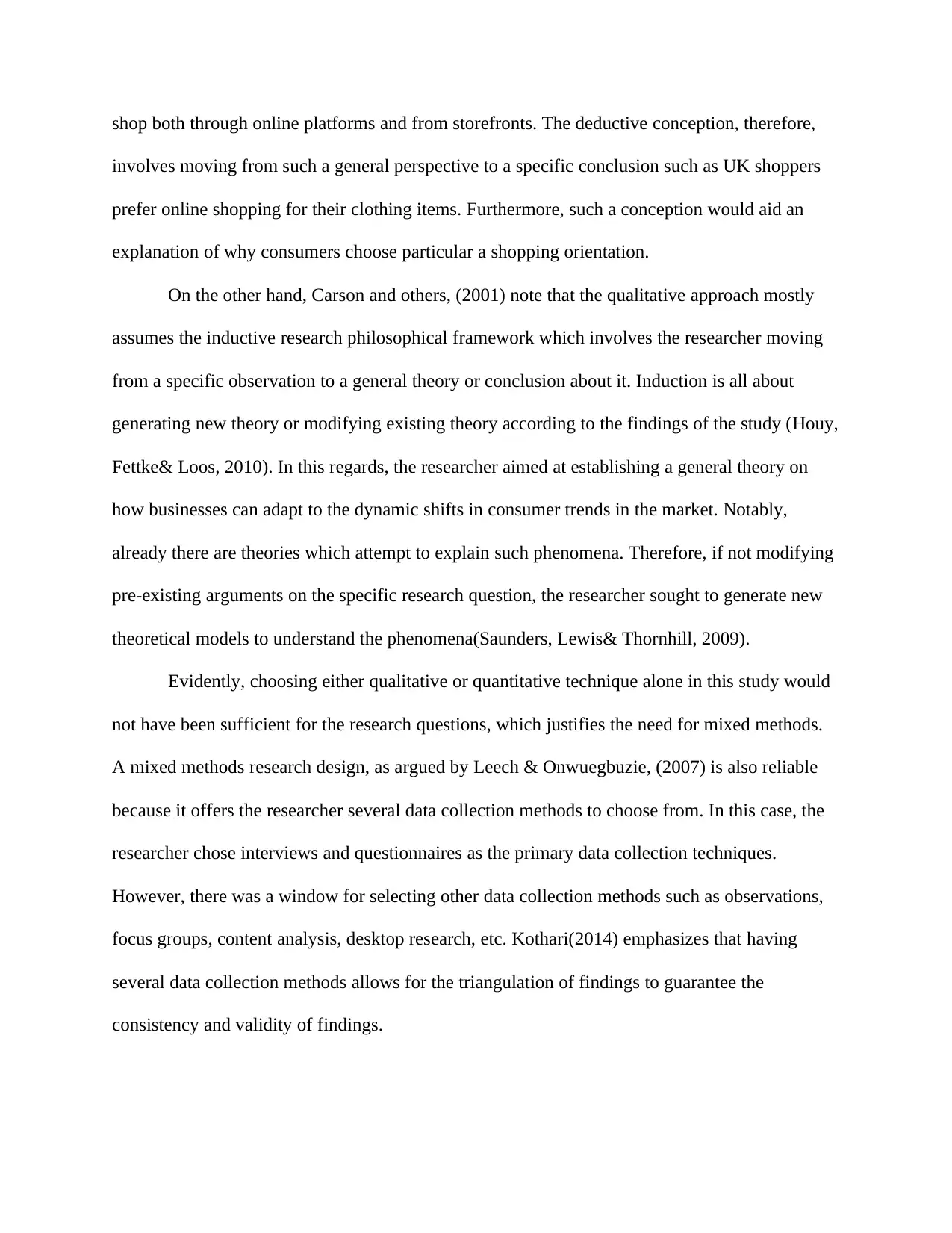
shop both through online platforms and from storefronts. The deductive conception, therefore,
involves moving from such a general perspective to a specific conclusion such as UK shoppers
prefer online shopping for their clothing items. Furthermore, such a conception would aid an
explanation of why consumers choose particular a shopping orientation.
On the other hand, Carson and others, (2001) note that the qualitative approach mostly
assumes the inductive research philosophical framework which involves the researcher moving
from a specific observation to a general theory or conclusion about it. Induction is all about
generating new theory or modifying existing theory according to the findings of the study (Houy,
Fettke& Loos, 2010). In this regards, the researcher aimed at establishing a general theory on
how businesses can adapt to the dynamic shifts in consumer trends in the market. Notably,
already there are theories which attempt to explain such phenomena. Therefore, if not modifying
pre-existing arguments on the specific research question, the researcher sought to generate new
theoretical models to understand the phenomena(Saunders, Lewis& Thornhill, 2009).
Evidently, choosing either qualitative or quantitative technique alone in this study would
not have been sufficient for the research questions, which justifies the need for mixed methods.
A mixed methods research design, as argued by Leech & Onwuegbuzie, (2007) is also reliable
because it offers the researcher several data collection methods to choose from. In this case, the
researcher chose interviews and questionnaires as the primary data collection techniques.
However, there was a window for selecting other data collection methods such as observations,
focus groups, content analysis, desktop research, etc. Kothari(2014) emphasizes that having
several data collection methods allows for the triangulation of findings to guarantee the
consistency and validity of findings.
involves moving from such a general perspective to a specific conclusion such as UK shoppers
prefer online shopping for their clothing items. Furthermore, such a conception would aid an
explanation of why consumers choose particular a shopping orientation.
On the other hand, Carson and others, (2001) note that the qualitative approach mostly
assumes the inductive research philosophical framework which involves the researcher moving
from a specific observation to a general theory or conclusion about it. Induction is all about
generating new theory or modifying existing theory according to the findings of the study (Houy,
Fettke& Loos, 2010). In this regards, the researcher aimed at establishing a general theory on
how businesses can adapt to the dynamic shifts in consumer trends in the market. Notably,
already there are theories which attempt to explain such phenomena. Therefore, if not modifying
pre-existing arguments on the specific research question, the researcher sought to generate new
theoretical models to understand the phenomena(Saunders, Lewis& Thornhill, 2009).
Evidently, choosing either qualitative or quantitative technique alone in this study would
not have been sufficient for the research questions, which justifies the need for mixed methods.
A mixed methods research design, as argued by Leech & Onwuegbuzie, (2007) is also reliable
because it offers the researcher several data collection methods to choose from. In this case, the
researcher chose interviews and questionnaires as the primary data collection techniques.
However, there was a window for selecting other data collection methods such as observations,
focus groups, content analysis, desktop research, etc. Kothari(2014) emphasizes that having
several data collection methods allows for the triangulation of findings to guarantee the
consistency and validity of findings.
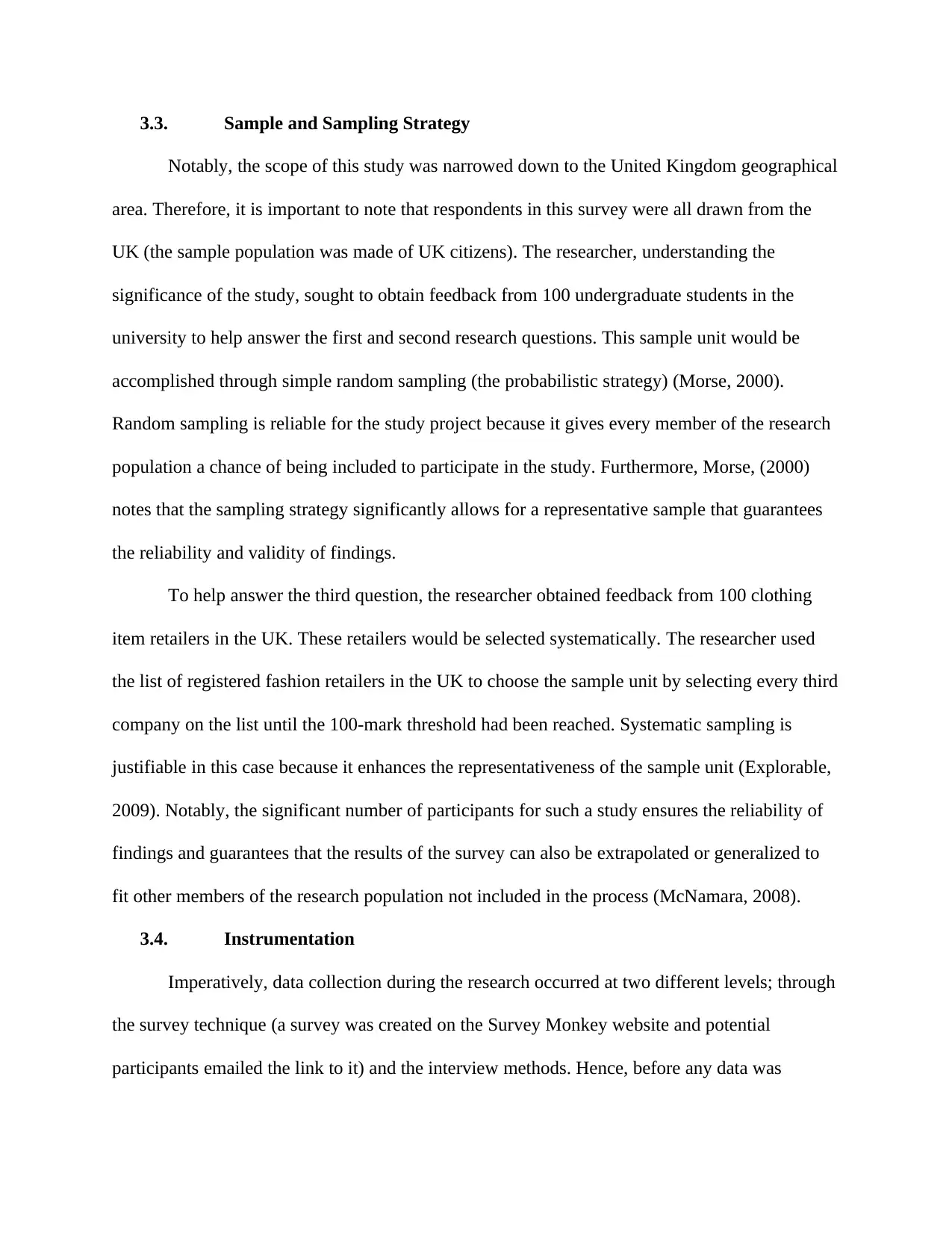
3.3. Sample and Sampling Strategy
Notably, the scope of this study was narrowed down to the United Kingdom geographical
area. Therefore, it is important to note that respondents in this survey were all drawn from the
UK (the sample population was made of UK citizens). The researcher, understanding the
significance of the study, sought to obtain feedback from 100 undergraduate students in the
university to help answer the first and second research questions. This sample unit would be
accomplished through simple random sampling (the probabilistic strategy) (Morse, 2000).
Random sampling is reliable for the study project because it gives every member of the research
population a chance of being included to participate in the study. Furthermore, Morse, (2000)
notes that the sampling strategy significantly allows for a representative sample that guarantees
the reliability and validity of findings.
To help answer the third question, the researcher obtained feedback from 100 clothing
item retailers in the UK. These retailers would be selected systematically. The researcher used
the list of registered fashion retailers in the UK to choose the sample unit by selecting every third
company on the list until the 100-mark threshold had been reached. Systematic sampling is
justifiable in this case because it enhances the representativeness of the sample unit (Explorable,
2009). Notably, the significant number of participants for such a study ensures the reliability of
findings and guarantees that the results of the survey can also be extrapolated or generalized to
fit other members of the research population not included in the process (McNamara, 2008).
3.4. Instrumentation
Imperatively, data collection during the research occurred at two different levels; through
the survey technique (a survey was created on the Survey Monkey website and potential
participants emailed the link to it) and the interview methods. Hence, before any data was
Notably, the scope of this study was narrowed down to the United Kingdom geographical
area. Therefore, it is important to note that respondents in this survey were all drawn from the
UK (the sample population was made of UK citizens). The researcher, understanding the
significance of the study, sought to obtain feedback from 100 undergraduate students in the
university to help answer the first and second research questions. This sample unit would be
accomplished through simple random sampling (the probabilistic strategy) (Morse, 2000).
Random sampling is reliable for the study project because it gives every member of the research
population a chance of being included to participate in the study. Furthermore, Morse, (2000)
notes that the sampling strategy significantly allows for a representative sample that guarantees
the reliability and validity of findings.
To help answer the third question, the researcher obtained feedback from 100 clothing
item retailers in the UK. These retailers would be selected systematically. The researcher used
the list of registered fashion retailers in the UK to choose the sample unit by selecting every third
company on the list until the 100-mark threshold had been reached. Systematic sampling is
justifiable in this case because it enhances the representativeness of the sample unit (Explorable,
2009). Notably, the significant number of participants for such a study ensures the reliability of
findings and guarantees that the results of the survey can also be extrapolated or generalized to
fit other members of the research population not included in the process (McNamara, 2008).
3.4. Instrumentation
Imperatively, data collection during the research occurred at two different levels; through
the survey technique (a survey was created on the Survey Monkey website and potential
participants emailed the link to it) and the interview methods. Hence, before any data was
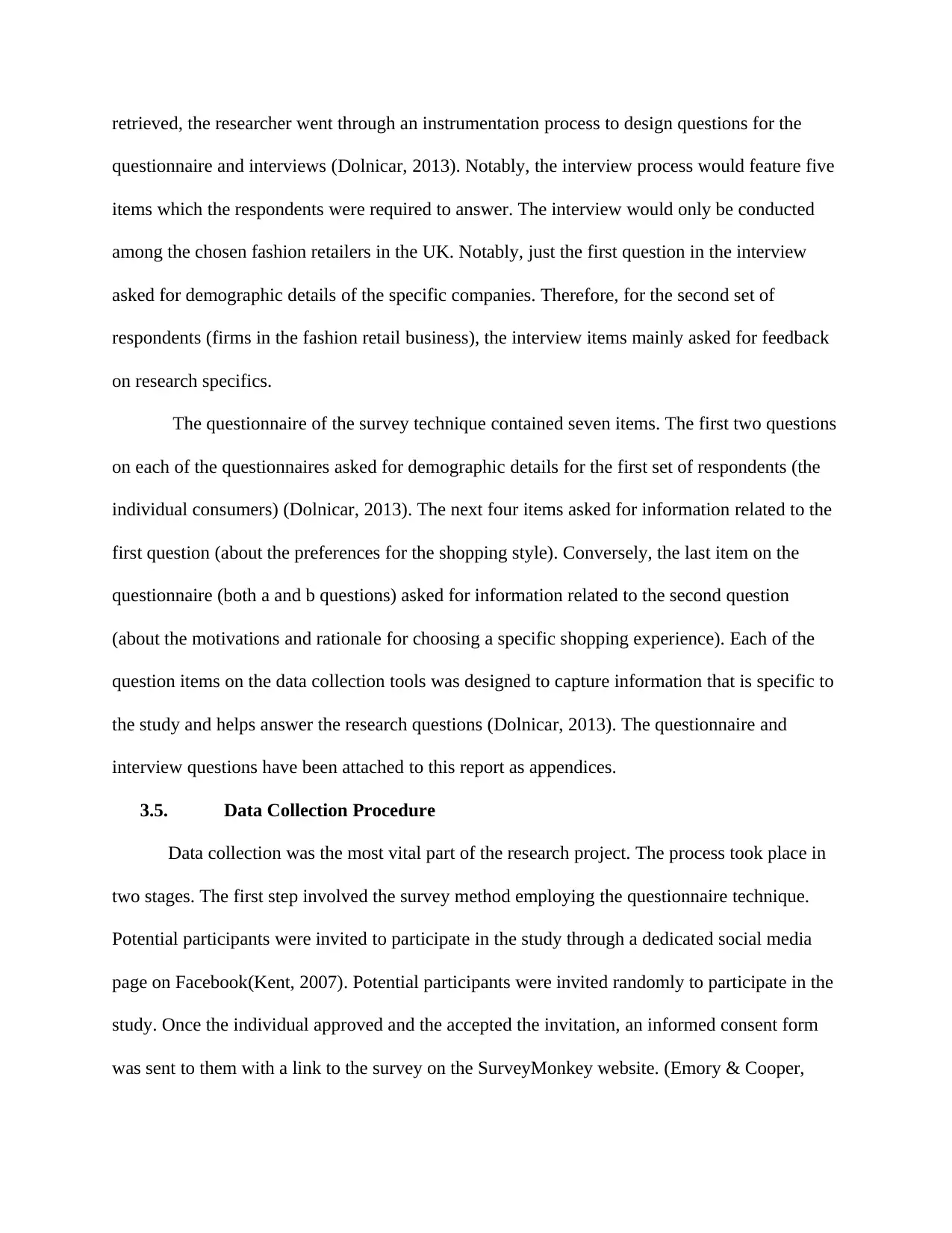
retrieved, the researcher went through an instrumentation process to design questions for the
questionnaire and interviews (Dolnicar, 2013). Notably, the interview process would feature five
items which the respondents were required to answer. The interview would only be conducted
among the chosen fashion retailers in the UK. Notably, just the first question in the interview
asked for demographic details of the specific companies. Therefore, for the second set of
respondents (firms in the fashion retail business), the interview items mainly asked for feedback
on research specifics.
The questionnaire of the survey technique contained seven items. The first two questions
on each of the questionnaires asked for demographic details for the first set of respondents (the
individual consumers) (Dolnicar, 2013). The next four items asked for information related to the
first question (about the preferences for the shopping style). Conversely, the last item on the
questionnaire (both a and b questions) asked for information related to the second question
(about the motivations and rationale for choosing a specific shopping experience). Each of the
question items on the data collection tools was designed to capture information that is specific to
the study and helps answer the research questions (Dolnicar, 2013). The questionnaire and
interview questions have been attached to this report as appendices.
3.5. Data Collection Procedure
Data collection was the most vital part of the research project. The process took place in
two stages. The first step involved the survey method employing the questionnaire technique.
Potential participants were invited to participate in the study through a dedicated social media
page on Facebook(Kent, 2007). Potential participants were invited randomly to participate in the
study. Once the individual approved and the accepted the invitation, an informed consent form
was sent to them with a link to the survey on the SurveyMonkey website. (Emory & Cooper,
questionnaire and interviews (Dolnicar, 2013). Notably, the interview process would feature five
items which the respondents were required to answer. The interview would only be conducted
among the chosen fashion retailers in the UK. Notably, just the first question in the interview
asked for demographic details of the specific companies. Therefore, for the second set of
respondents (firms in the fashion retail business), the interview items mainly asked for feedback
on research specifics.
The questionnaire of the survey technique contained seven items. The first two questions
on each of the questionnaires asked for demographic details for the first set of respondents (the
individual consumers) (Dolnicar, 2013). The next four items asked for information related to the
first question (about the preferences for the shopping style). Conversely, the last item on the
questionnaire (both a and b questions) asked for information related to the second question
(about the motivations and rationale for choosing a specific shopping experience). Each of the
question items on the data collection tools was designed to capture information that is specific to
the study and helps answer the research questions (Dolnicar, 2013). The questionnaire and
interview questions have been attached to this report as appendices.
3.5. Data Collection Procedure
Data collection was the most vital part of the research project. The process took place in
two stages. The first step involved the survey method employing the questionnaire technique.
Potential participants were invited to participate in the study through a dedicated social media
page on Facebook(Kent, 2007). Potential participants were invited randomly to participate in the
study. Once the individual approved and the accepted the invitation, an informed consent form
was sent to them with a link to the survey on the SurveyMonkey website. (Emory & Cooper,
Secure Best Marks with AI Grader
Need help grading? Try our AI Grader for instant feedback on your assignments.
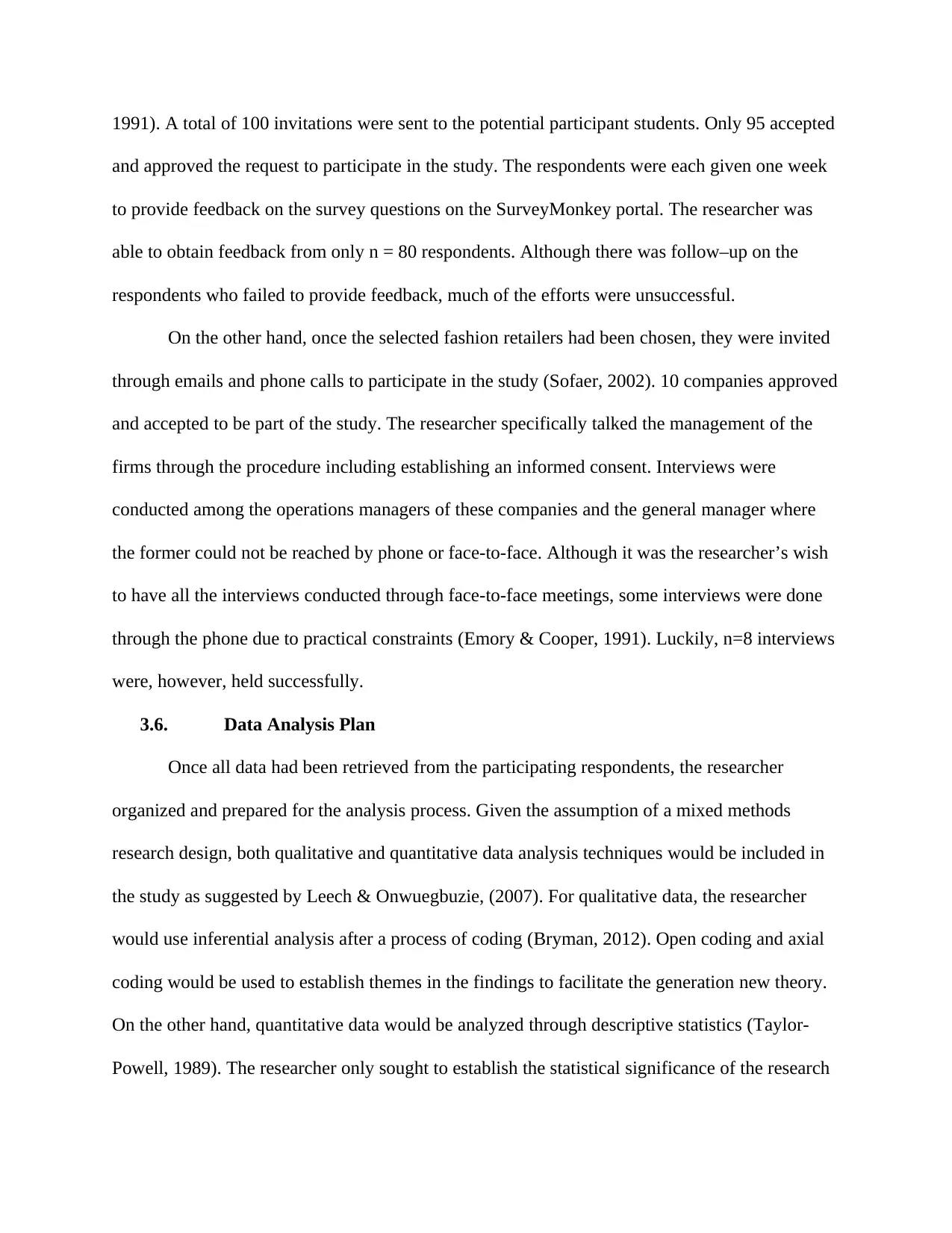
1991). A total of 100 invitations were sent to the potential participant students. Only 95 accepted
and approved the request to participate in the study. The respondents were each given one week
to provide feedback on the survey questions on the SurveyMonkey portal. The researcher was
able to obtain feedback from only n = 80 respondents. Although there was follow–up on the
respondents who failed to provide feedback, much of the efforts were unsuccessful.
On the other hand, once the selected fashion retailers had been chosen, they were invited
through emails and phone calls to participate in the study (Sofaer, 2002). 10 companies approved
and accepted to be part of the study. The researcher specifically talked the management of the
firms through the procedure including establishing an informed consent. Interviews were
conducted among the operations managers of these companies and the general manager where
the former could not be reached by phone or face-to-face. Although it was the researcher’s wish
to have all the interviews conducted through face-to-face meetings, some interviews were done
through the phone due to practical constraints (Emory & Cooper, 1991). Luckily, n=8 interviews
were, however, held successfully.
3.6. Data Analysis Plan
Once all data had been retrieved from the participating respondents, the researcher
organized and prepared for the analysis process. Given the assumption of a mixed methods
research design, both qualitative and quantitative data analysis techniques would be included in
the study as suggested by Leech & Onwuegbuzie, (2007). For qualitative data, the researcher
would use inferential analysis after a process of coding (Bryman, 2012). Open coding and axial
coding would be used to establish themes in the findings to facilitate the generation new theory.
On the other hand, quantitative data would be analyzed through descriptive statistics (Taylor-
Powell, 1989). The researcher only sought to establish the statistical significance of the research
and approved the request to participate in the study. The respondents were each given one week
to provide feedback on the survey questions on the SurveyMonkey portal. The researcher was
able to obtain feedback from only n = 80 respondents. Although there was follow–up on the
respondents who failed to provide feedback, much of the efforts were unsuccessful.
On the other hand, once the selected fashion retailers had been chosen, they were invited
through emails and phone calls to participate in the study (Sofaer, 2002). 10 companies approved
and accepted to be part of the study. The researcher specifically talked the management of the
firms through the procedure including establishing an informed consent. Interviews were
conducted among the operations managers of these companies and the general manager where
the former could not be reached by phone or face-to-face. Although it was the researcher’s wish
to have all the interviews conducted through face-to-face meetings, some interviews were done
through the phone due to practical constraints (Emory & Cooper, 1991). Luckily, n=8 interviews
were, however, held successfully.
3.6. Data Analysis Plan
Once all data had been retrieved from the participating respondents, the researcher
organized and prepared for the analysis process. Given the assumption of a mixed methods
research design, both qualitative and quantitative data analysis techniques would be included in
the study as suggested by Leech & Onwuegbuzie, (2007). For qualitative data, the researcher
would use inferential analysis after a process of coding (Bryman, 2012). Open coding and axial
coding would be used to establish themes in the findings to facilitate the generation new theory.
On the other hand, quantitative data would be analyzed through descriptive statistics (Taylor-
Powell, 1989). The researcher only sought to establish the statistical significance of the research

findings. Therefore, the researcher would use measures of central tendency including the mean
(average), mode and the median to analyze the data (Taylor-Powell, 1989). Percentages will also
be calculated to facilitate a comparison of online and in-store shopping of clothing items. The
idea is to present the research findings in a meaningful manner (Zikmund, et al., 2013).
(average), mode and the median to analyze the data (Taylor-Powell, 1989). Percentages will also
be calculated to facilitate a comparison of online and in-store shopping of clothing items. The
idea is to present the research findings in a meaningful manner (Zikmund, et al., 2013).
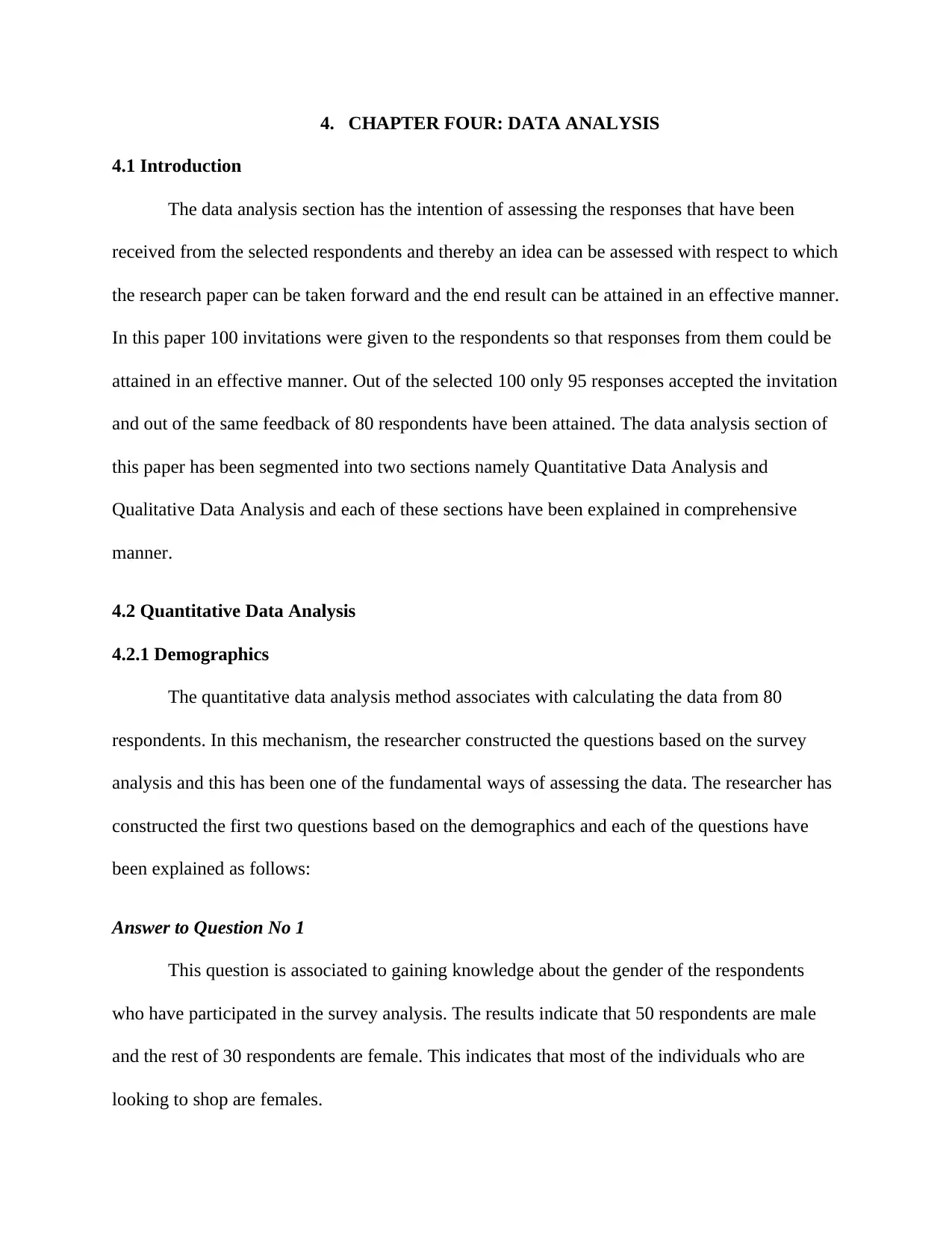
4. CHAPTER FOUR: DATA ANALYSIS
4.1 Introduction
The data analysis section has the intention of assessing the responses that have been
received from the selected respondents and thereby an idea can be assessed with respect to which
the research paper can be taken forward and the end result can be attained in an effective manner.
In this paper 100 invitations were given to the respondents so that responses from them could be
attained in an effective manner. Out of the selected 100 only 95 responses accepted the invitation
and out of the same feedback of 80 respondents have been attained. The data analysis section of
this paper has been segmented into two sections namely Quantitative Data Analysis and
Qualitative Data Analysis and each of these sections have been explained in comprehensive
manner.
4.2 Quantitative Data Analysis
4.2.1 Demographics
The quantitative data analysis method associates with calculating the data from 80
respondents. In this mechanism, the researcher constructed the questions based on the survey
analysis and this has been one of the fundamental ways of assessing the data. The researcher has
constructed the first two questions based on the demographics and each of the questions have
been explained as follows:
Answer to Question No 1
This question is associated to gaining knowledge about the gender of the respondents
who have participated in the survey analysis. The results indicate that 50 respondents are male
and the rest of 30 respondents are female. This indicates that most of the individuals who are
looking to shop are females.
4.1 Introduction
The data analysis section has the intention of assessing the responses that have been
received from the selected respondents and thereby an idea can be assessed with respect to which
the research paper can be taken forward and the end result can be attained in an effective manner.
In this paper 100 invitations were given to the respondents so that responses from them could be
attained in an effective manner. Out of the selected 100 only 95 responses accepted the invitation
and out of the same feedback of 80 respondents have been attained. The data analysis section of
this paper has been segmented into two sections namely Quantitative Data Analysis and
Qualitative Data Analysis and each of these sections have been explained in comprehensive
manner.
4.2 Quantitative Data Analysis
4.2.1 Demographics
The quantitative data analysis method associates with calculating the data from 80
respondents. In this mechanism, the researcher constructed the questions based on the survey
analysis and this has been one of the fundamental ways of assessing the data. The researcher has
constructed the first two questions based on the demographics and each of the questions have
been explained as follows:
Answer to Question No 1
This question is associated to gaining knowledge about the gender of the respondents
who have participated in the survey analysis. The results indicate that 50 respondents are male
and the rest of 30 respondents are female. This indicates that most of the individuals who are
looking to shop are females.
Paraphrase This Document
Need a fresh take? Get an instant paraphrase of this document with our AI Paraphraser
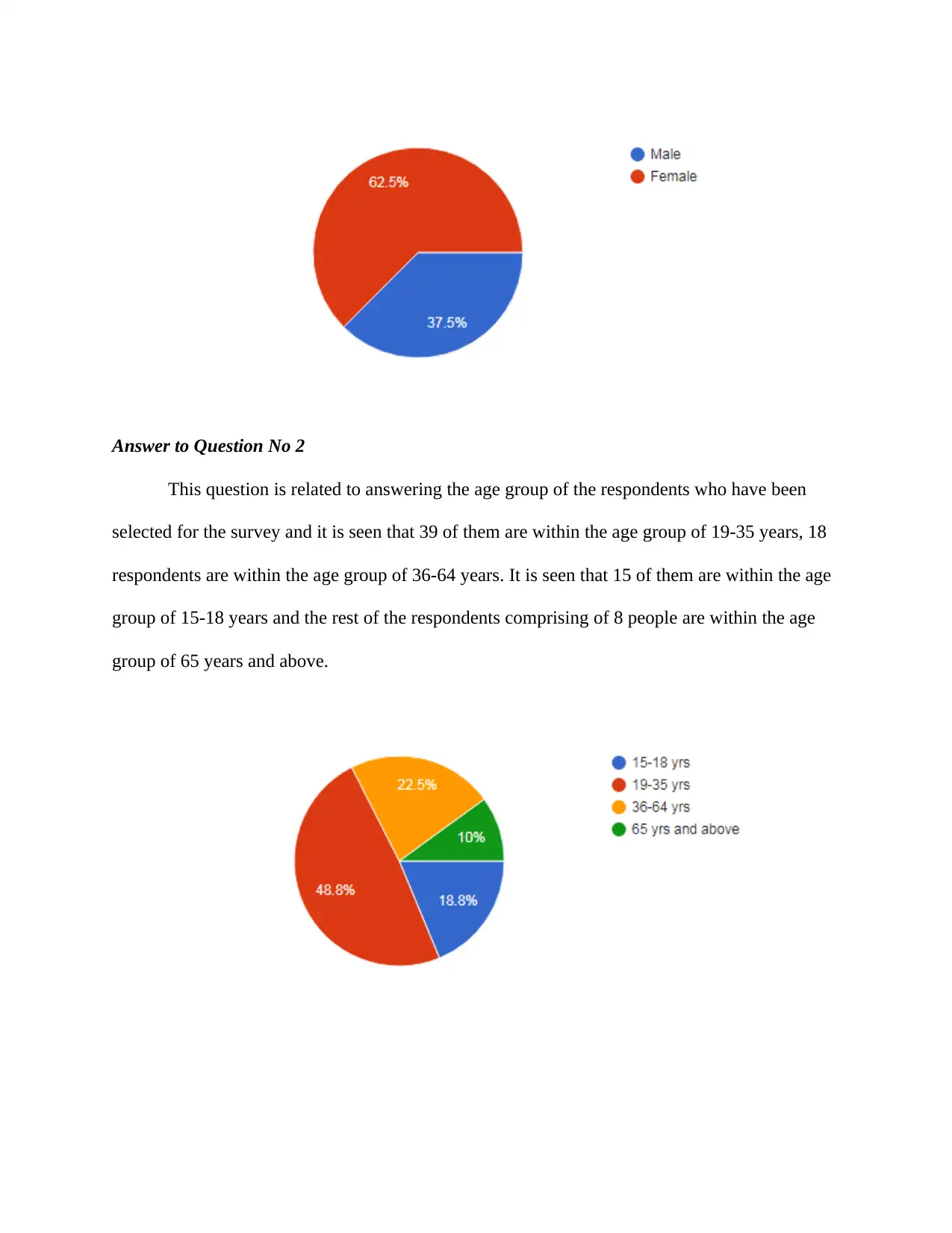
Answer to Question No 2
This question is related to answering the age group of the respondents who have been
selected for the survey and it is seen that 39 of them are within the age group of 19-35 years, 18
respondents are within the age group of 36-64 years. It is seen that 15 of them are within the age
group of 15-18 years and the rest of the respondents comprising of 8 people are within the age
group of 65 years and above.
This question is related to answering the age group of the respondents who have been
selected for the survey and it is seen that 39 of them are within the age group of 19-35 years, 18
respondents are within the age group of 36-64 years. It is seen that 15 of them are within the age
group of 15-18 years and the rest of the respondents comprising of 8 people are within the age
group of 65 years and above.
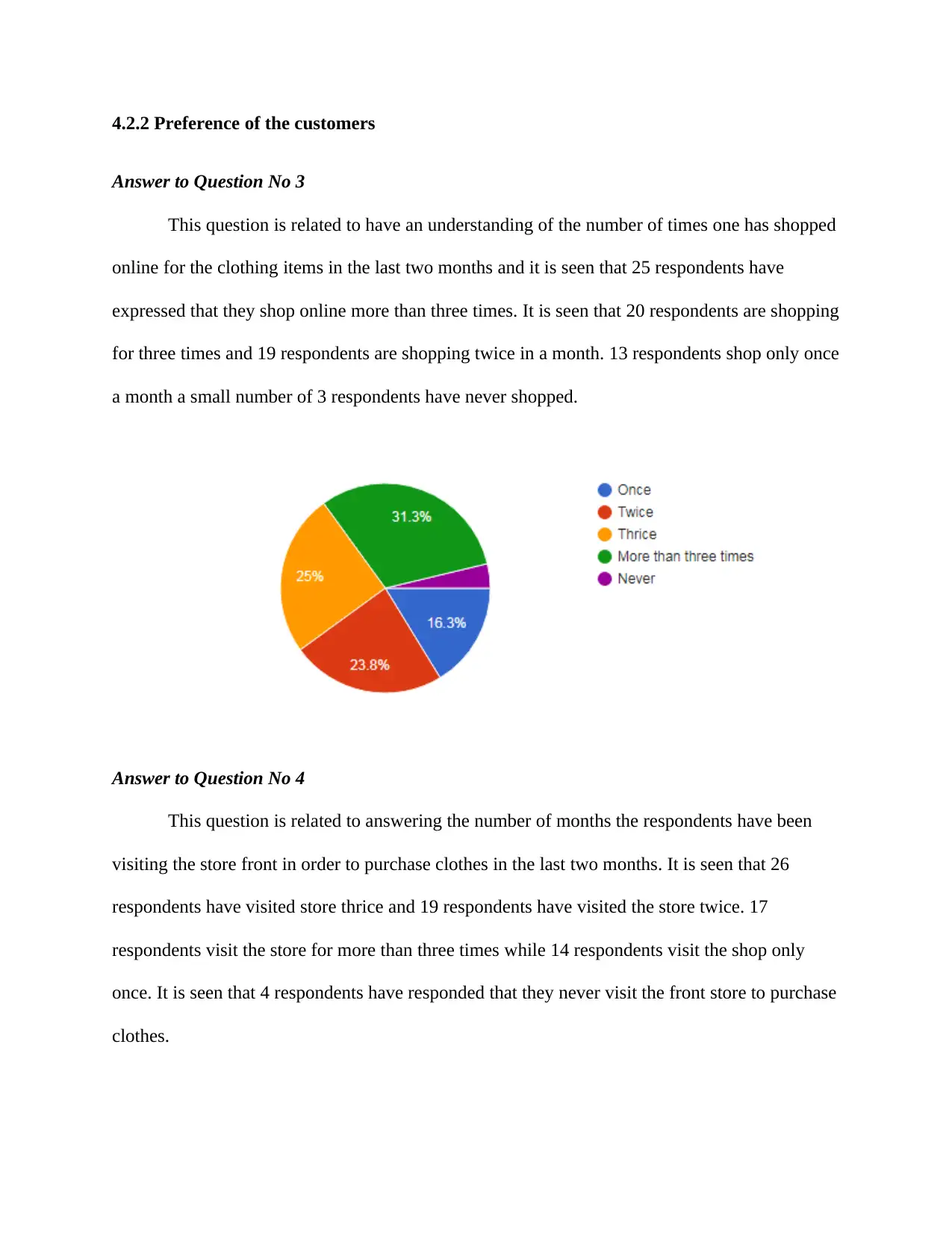
4.2.2 Preference of the customers
Answer to Question No 3
This question is related to have an understanding of the number of times one has shopped
online for the clothing items in the last two months and it is seen that 25 respondents have
expressed that they shop online more than three times. It is seen that 20 respondents are shopping
for three times and 19 respondents are shopping twice in a month. 13 respondents shop only once
a month a small number of 3 respondents have never shopped.
Answer to Question No 4
This question is related to answering the number of months the respondents have been
visiting the store front in order to purchase clothes in the last two months. It is seen that 26
respondents have visited store thrice and 19 respondents have visited the store twice. 17
respondents visit the store for more than three times while 14 respondents visit the shop only
once. It is seen that 4 respondents have responded that they never visit the front store to purchase
clothes.
Answer to Question No 3
This question is related to have an understanding of the number of times one has shopped
online for the clothing items in the last two months and it is seen that 25 respondents have
expressed that they shop online more than three times. It is seen that 20 respondents are shopping
for three times and 19 respondents are shopping twice in a month. 13 respondents shop only once
a month a small number of 3 respondents have never shopped.
Answer to Question No 4
This question is related to answering the number of months the respondents have been
visiting the store front in order to purchase clothes in the last two months. It is seen that 26
respondents have visited store thrice and 19 respondents have visited the store twice. 17
respondents visit the store for more than three times while 14 respondents visit the shop only
once. It is seen that 4 respondents have responded that they never visit the front store to purchase
clothes.

Answer to Question No 5
This question looks to answer where the research has been undertaken for the product
prior to the purchase and it is seen that 30 respondents have expressed that they do the survey
with the help of the social media advertisements and 23 respondents have undertaken the
research online. It is seen that 19 respondents have expressed that they undertake research at the
store and only 8 respondents have undertaken research with the word-of-mouth.
This question looks to answer where the research has been undertaken for the product
prior to the purchase and it is seen that 30 respondents have expressed that they do the survey
with the help of the social media advertisements and 23 respondents have undertaken the
research online. It is seen that 19 respondents have expressed that they undertake research at the
store and only 8 respondents have undertaken research with the word-of-mouth.
Secure Best Marks with AI Grader
Need help grading? Try our AI Grader for instant feedback on your assignments.
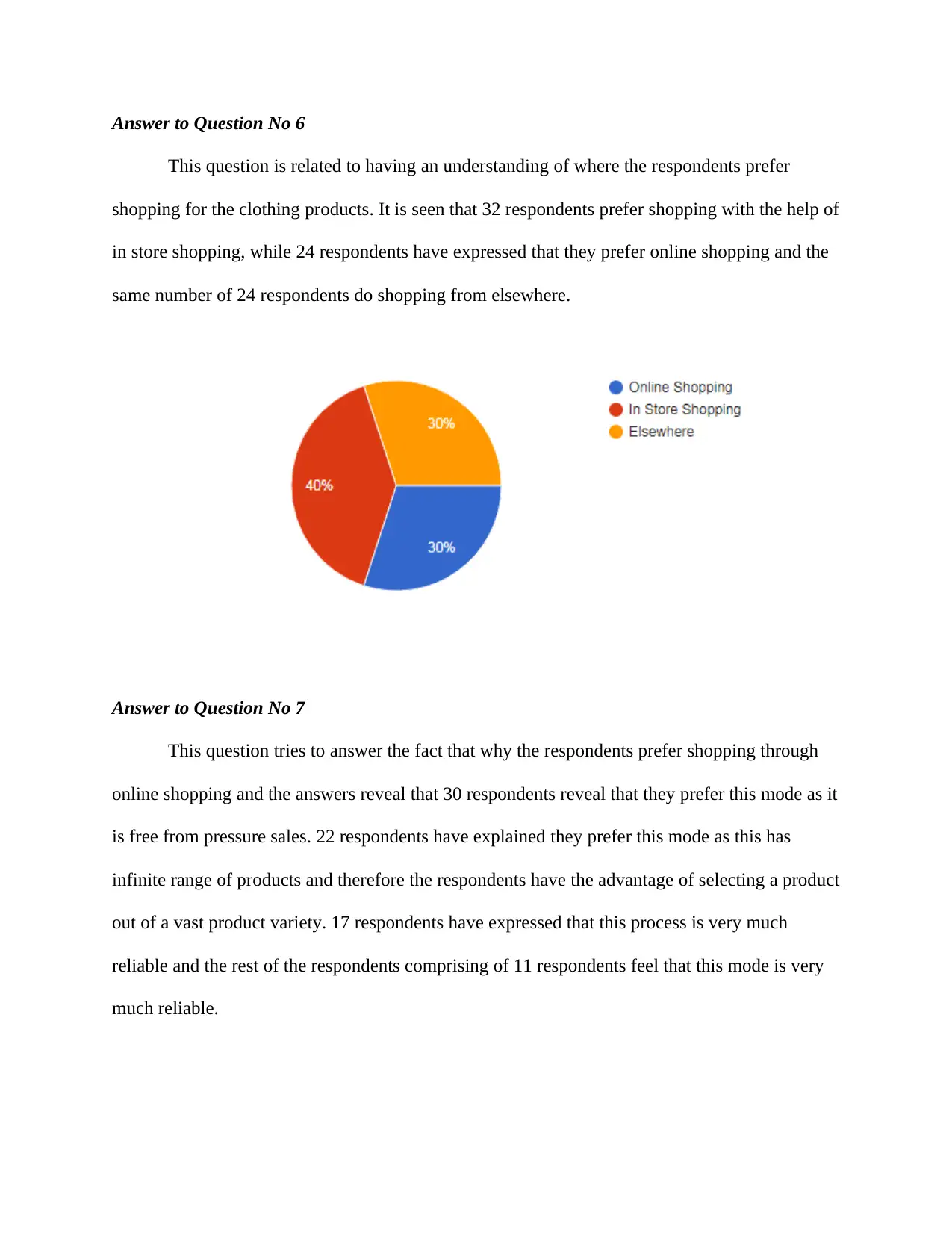
Answer to Question No 6
This question is related to having an understanding of where the respondents prefer
shopping for the clothing products. It is seen that 32 respondents prefer shopping with the help of
in store shopping, while 24 respondents have expressed that they prefer online shopping and the
same number of 24 respondents do shopping from elsewhere.
Answer to Question No 7
This question tries to answer the fact that why the respondents prefer shopping through
online shopping and the answers reveal that 30 respondents reveal that they prefer this mode as it
is free from pressure sales. 22 respondents have explained they prefer this mode as this has
infinite range of products and therefore the respondents have the advantage of selecting a product
out of a vast product variety. 17 respondents have expressed that this process is very much
reliable and the rest of the respondents comprising of 11 respondents feel that this mode is very
much reliable.
This question is related to having an understanding of where the respondents prefer
shopping for the clothing products. It is seen that 32 respondents prefer shopping with the help of
in store shopping, while 24 respondents have expressed that they prefer online shopping and the
same number of 24 respondents do shopping from elsewhere.
Answer to Question No 7
This question tries to answer the fact that why the respondents prefer shopping through
online shopping and the answers reveal that 30 respondents reveal that they prefer this mode as it
is free from pressure sales. 22 respondents have explained they prefer this mode as this has
infinite range of products and therefore the respondents have the advantage of selecting a product
out of a vast product variety. 17 respondents have expressed that this process is very much
reliable and the rest of the respondents comprising of 11 respondents feel that this mode is very
much reliable.
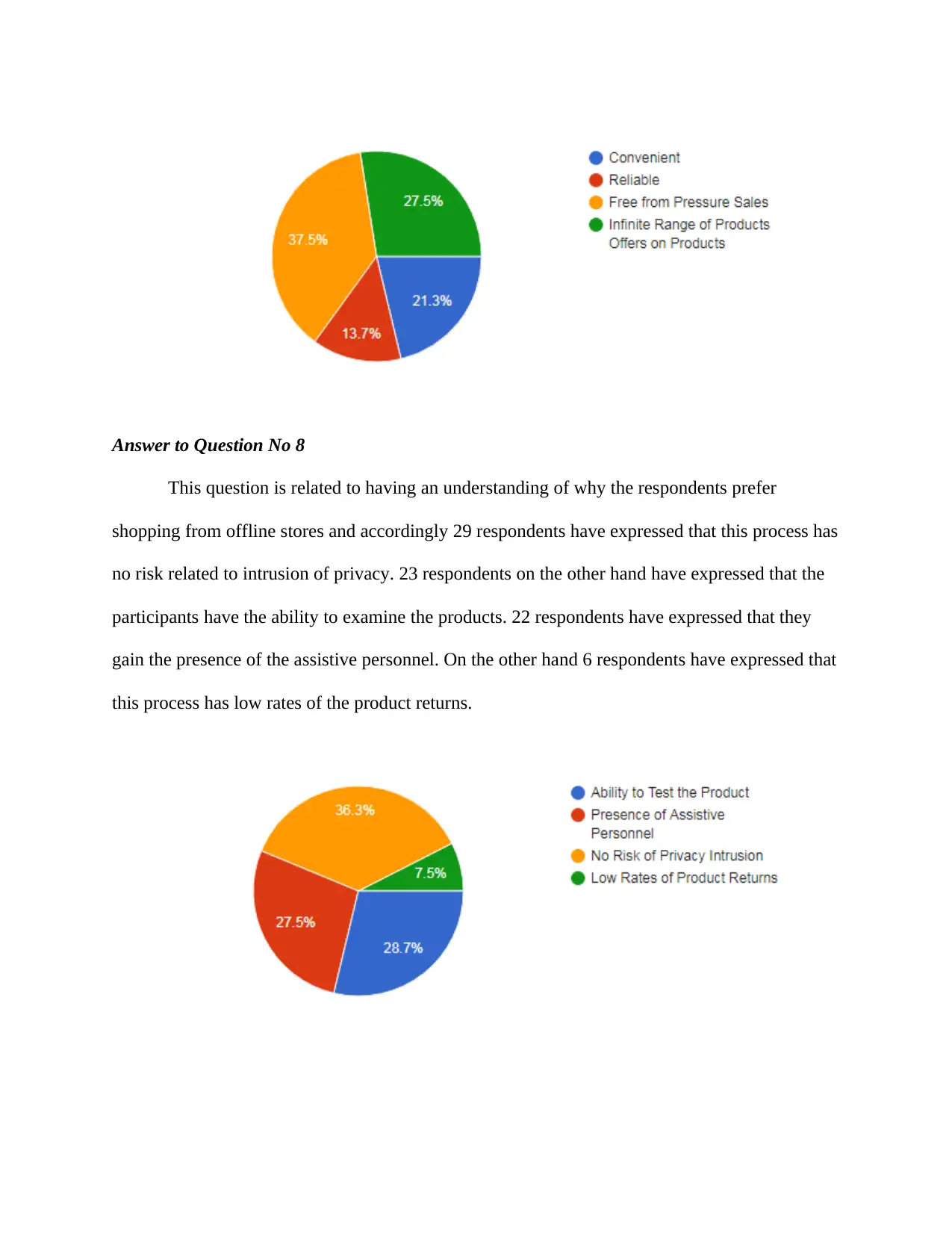
Answer to Question No 8
This question is related to having an understanding of why the respondents prefer
shopping from offline stores and accordingly 29 respondents have expressed that this process has
no risk related to intrusion of privacy. 23 respondents on the other hand have expressed that the
participants have the ability to examine the products. 22 respondents have expressed that they
gain the presence of the assistive personnel. On the other hand 6 respondents have expressed that
this process has low rates of the product returns.
This question is related to having an understanding of why the respondents prefer
shopping from offline stores and accordingly 29 respondents have expressed that this process has
no risk related to intrusion of privacy. 23 respondents on the other hand have expressed that the
participants have the ability to examine the products. 22 respondents have expressed that they
gain the presence of the assistive personnel. On the other hand 6 respondents have expressed that
this process has low rates of the product returns.

Answer to Question No 9
This question has been asked to the respondents with respect to having an understanding
of whether online shopping reduces the time that is consumed by the offline stores. The results
have indicated that 23 respondents have remained neutral and 20 respondents agree to this
statement. 19 respondents on the other hand disagree to this statement. 10 respondents have
strongly disagreed to this statement and 8 respondents on the other hand have strongly agreed.
Answer to Question No 10
This question assesses whether the discounts that are offered on the prices of the products
are more in the online stores rather than the offline stores. It is seen that 23 respondents remain
neutral and 21 respondents agree to this statement. 16 respondents disagree to this statement and
12 respondents strongly disagree. It is seen that 8 respondents have strongly agreed and thereby
explaining that discounts that are offered in the online stores are not much higher than the offline
stores.
This question has been asked to the respondents with respect to having an understanding
of whether online shopping reduces the time that is consumed by the offline stores. The results
have indicated that 23 respondents have remained neutral and 20 respondents agree to this
statement. 19 respondents on the other hand disagree to this statement. 10 respondents have
strongly disagreed to this statement and 8 respondents on the other hand have strongly agreed.
Answer to Question No 10
This question assesses whether the discounts that are offered on the prices of the products
are more in the online stores rather than the offline stores. It is seen that 23 respondents remain
neutral and 21 respondents agree to this statement. 16 respondents disagree to this statement and
12 respondents strongly disagree. It is seen that 8 respondents have strongly agreed and thereby
explaining that discounts that are offered in the online stores are not much higher than the offline
stores.
Paraphrase This Document
Need a fresh take? Get an instant paraphrase of this document with our AI Paraphraser
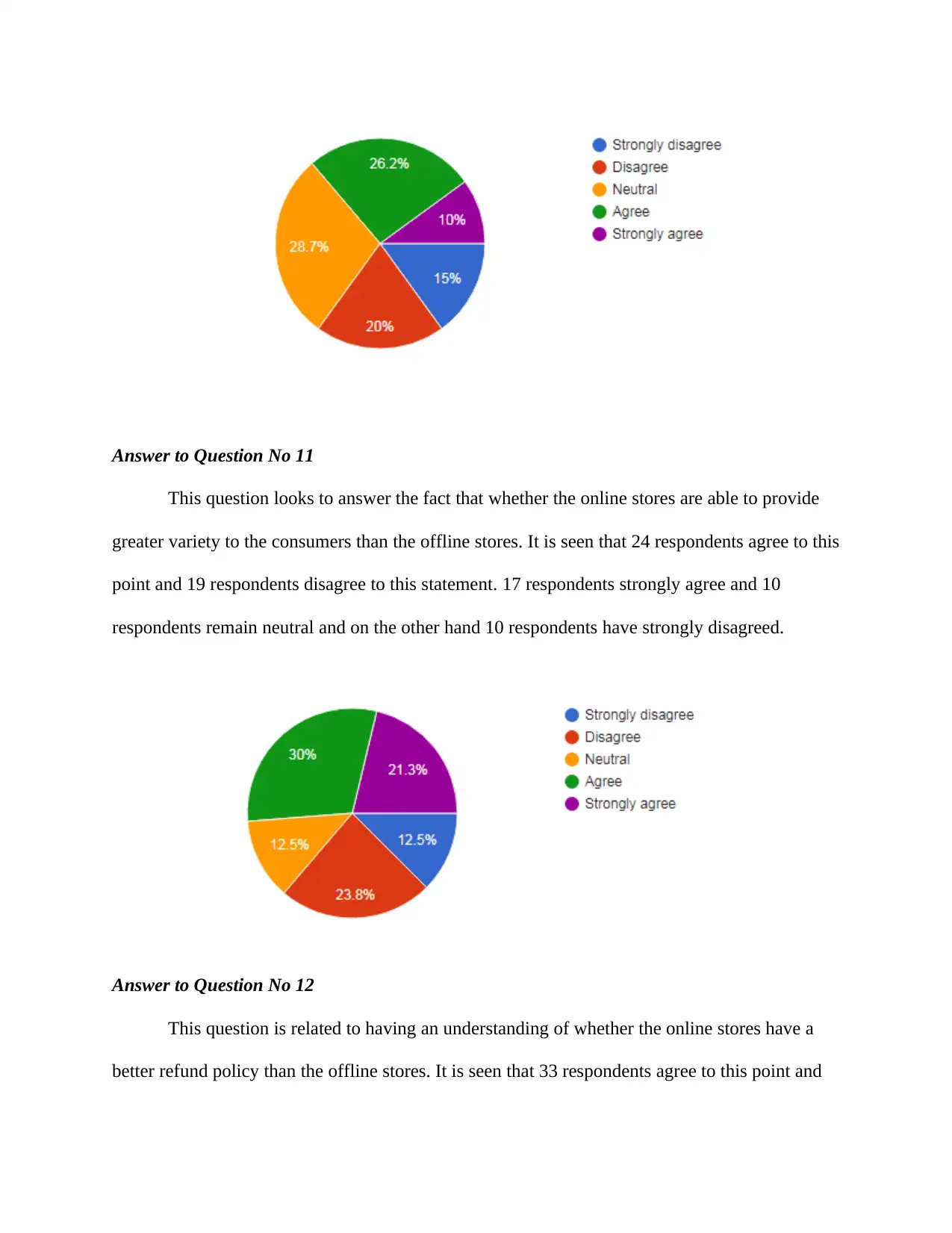
Answer to Question No 11
This question looks to answer the fact that whether the online stores are able to provide
greater variety to the consumers than the offline stores. It is seen that 24 respondents agree to this
point and 19 respondents disagree to this statement. 17 respondents strongly agree and 10
respondents remain neutral and on the other hand 10 respondents have strongly disagreed.
Answer to Question No 12
This question is related to having an understanding of whether the online stores have a
better refund policy than the offline stores. It is seen that 33 respondents agree to this point and
This question looks to answer the fact that whether the online stores are able to provide
greater variety to the consumers than the offline stores. It is seen that 24 respondents agree to this
point and 19 respondents disagree to this statement. 17 respondents strongly agree and 10
respondents remain neutral and on the other hand 10 respondents have strongly disagreed.
Answer to Question No 12
This question is related to having an understanding of whether the online stores have a
better refund policy than the offline stores. It is seen that 33 respondents agree to this point and
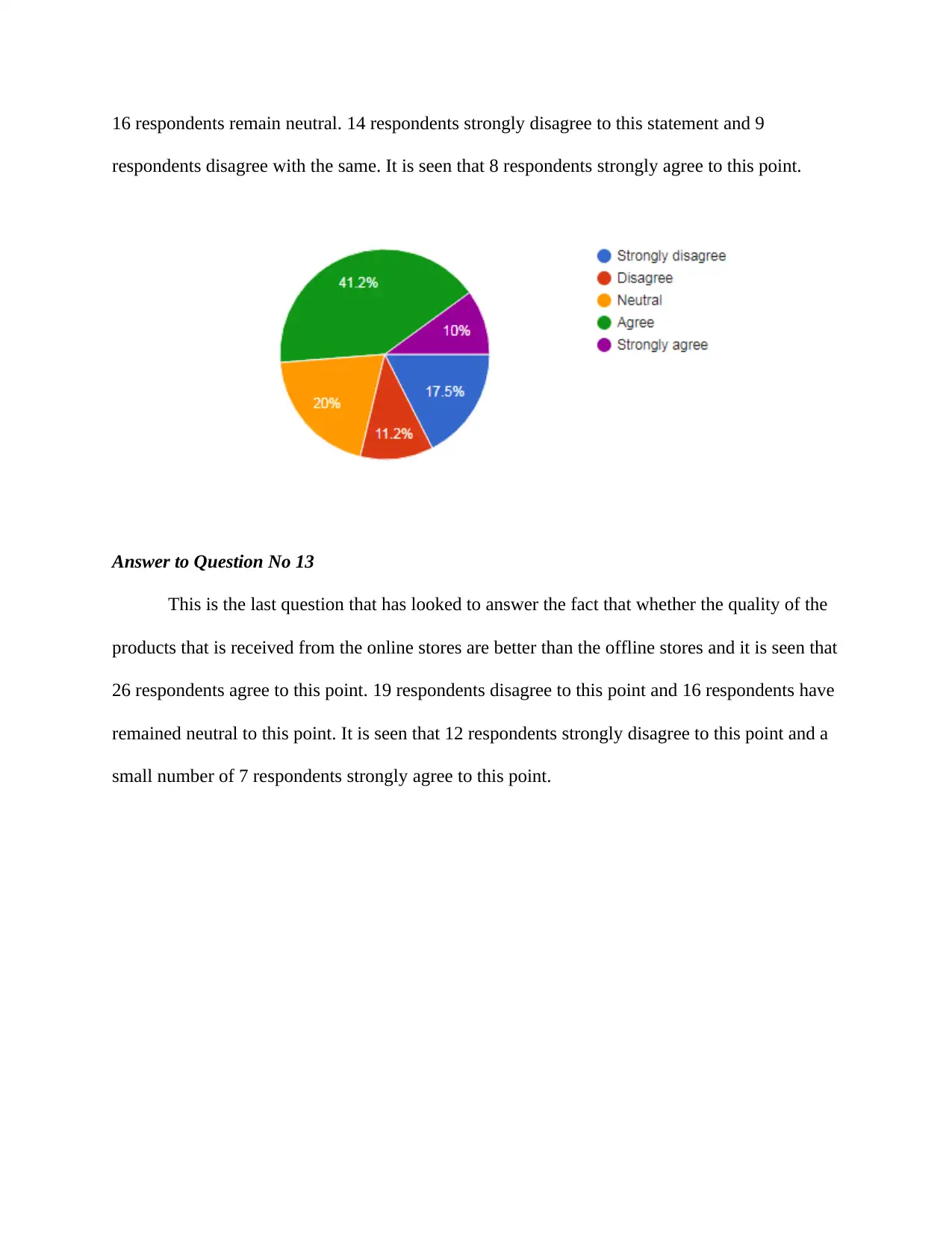
16 respondents remain neutral. 14 respondents strongly disagree to this statement and 9
respondents disagree with the same. It is seen that 8 respondents strongly agree to this point.
Answer to Question No 13
This is the last question that has looked to answer the fact that whether the quality of the
products that is received from the online stores are better than the offline stores and it is seen that
26 respondents agree to this point. 19 respondents disagree to this point and 16 respondents have
remained neutral to this point. It is seen that 12 respondents strongly disagree to this point and a
small number of 7 respondents strongly agree to this point.
respondents disagree with the same. It is seen that 8 respondents strongly agree to this point.
Answer to Question No 13
This is the last question that has looked to answer the fact that whether the quality of the
products that is received from the online stores are better than the offline stores and it is seen that
26 respondents agree to this point. 19 respondents disagree to this point and 16 respondents have
remained neutral to this point. It is seen that 12 respondents strongly disagree to this point and a
small number of 7 respondents strongly agree to this point.
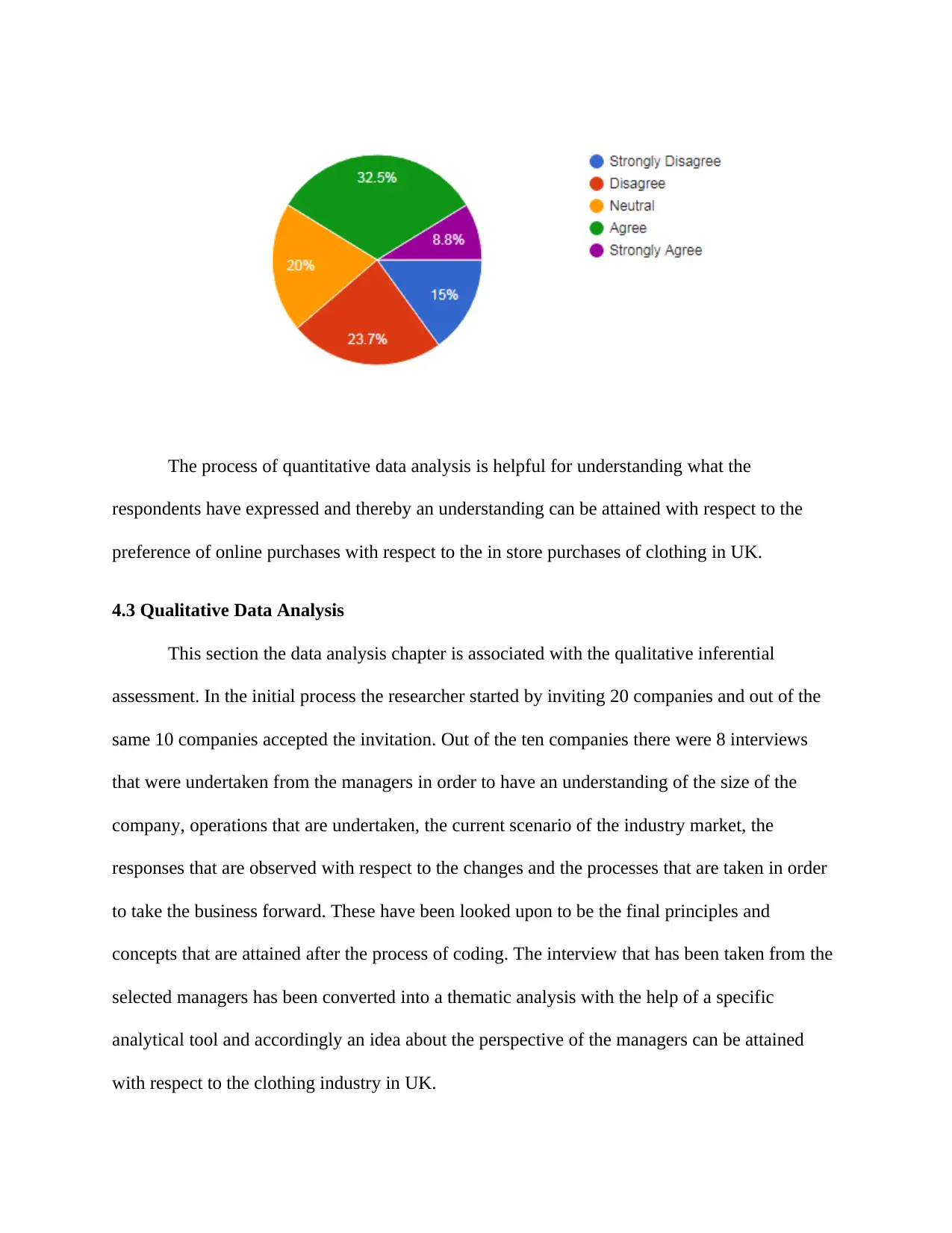
The process of quantitative data analysis is helpful for understanding what the
respondents have expressed and thereby an understanding can be attained with respect to the
preference of online purchases with respect to the in store purchases of clothing in UK.
4.3 Qualitative Data Analysis
This section the data analysis chapter is associated with the qualitative inferential
assessment. In the initial process the researcher started by inviting 20 companies and out of the
same 10 companies accepted the invitation. Out of the ten companies there were 8 interviews
that were undertaken from the managers in order to have an understanding of the size of the
company, operations that are undertaken, the current scenario of the industry market, the
responses that are observed with respect to the changes and the processes that are taken in order
to take the business forward. These have been looked upon to be the final principles and
concepts that are attained after the process of coding. The interview that has been taken from the
selected managers has been converted into a thematic analysis with the help of a specific
analytical tool and accordingly an idea about the perspective of the managers can be attained
with respect to the clothing industry in UK.
respondents have expressed and thereby an understanding can be attained with respect to the
preference of online purchases with respect to the in store purchases of clothing in UK.
4.3 Qualitative Data Analysis
This section the data analysis chapter is associated with the qualitative inferential
assessment. In the initial process the researcher started by inviting 20 companies and out of the
same 10 companies accepted the invitation. Out of the ten companies there were 8 interviews
that were undertaken from the managers in order to have an understanding of the size of the
company, operations that are undertaken, the current scenario of the industry market, the
responses that are observed with respect to the changes and the processes that are taken in order
to take the business forward. These have been looked upon to be the final principles and
concepts that are attained after the process of coding. The interview that has been taken from the
selected managers has been converted into a thematic analysis with the help of a specific
analytical tool and accordingly an idea about the perspective of the managers can be attained
with respect to the clothing industry in UK.
Secure Best Marks with AI Grader
Need help grading? Try our AI Grader for instant feedback on your assignments.
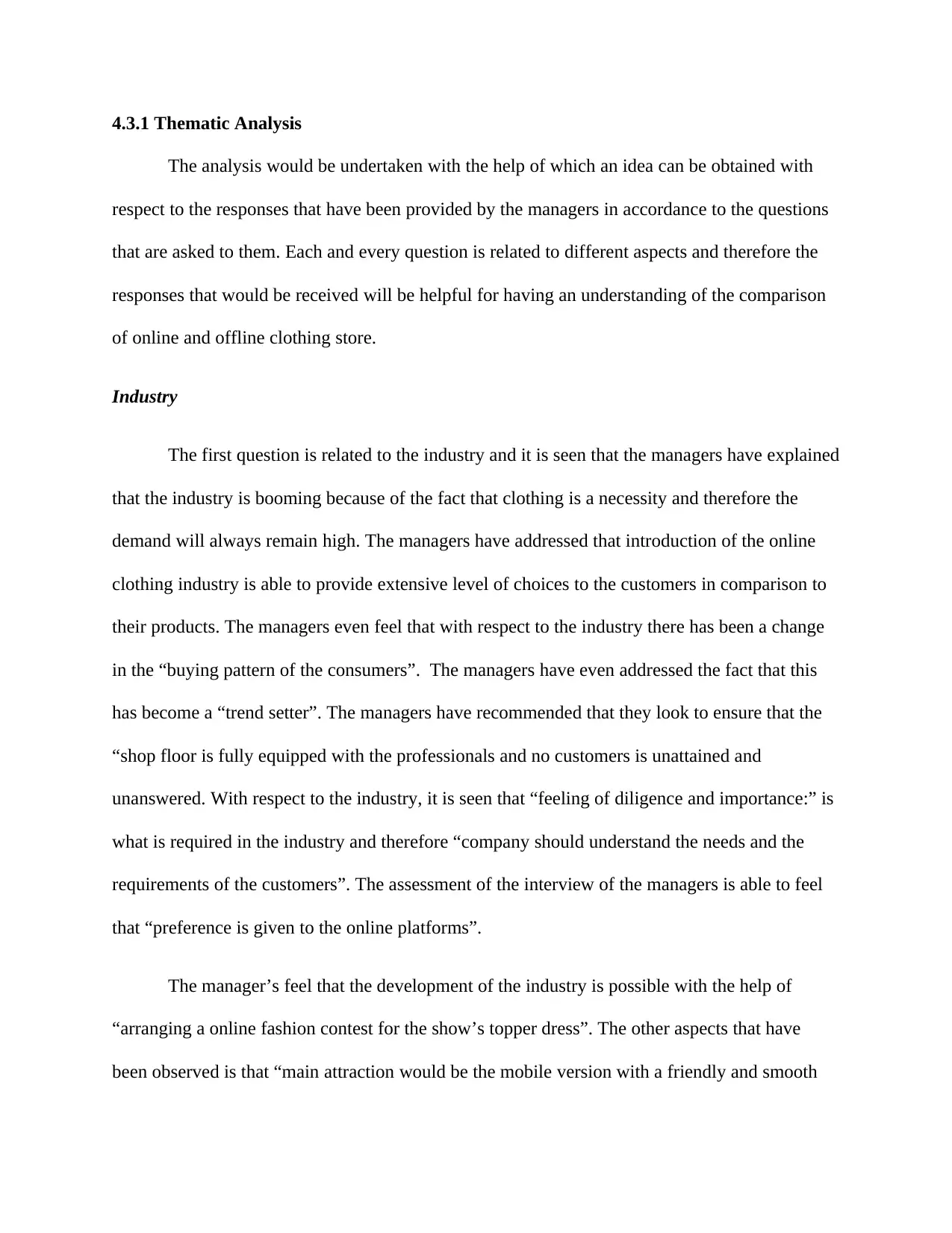
4.3.1 Thematic Analysis
The analysis would be undertaken with the help of which an idea can be obtained with
respect to the responses that have been provided by the managers in accordance to the questions
that are asked to them. Each and every question is related to different aspects and therefore the
responses that would be received will be helpful for having an understanding of the comparison
of online and offline clothing store.
Industry
The first question is related to the industry and it is seen that the managers have explained
that the industry is booming because of the fact that clothing is a necessity and therefore the
demand will always remain high. The managers have addressed that introduction of the online
clothing industry is able to provide extensive level of choices to the customers in comparison to
their products. The managers even feel that with respect to the industry there has been a change
in the “buying pattern of the consumers”. The managers have even addressed the fact that this
has become a “trend setter”. The managers have recommended that they look to ensure that the
“shop floor is fully equipped with the professionals and no customers is unattained and
unanswered. With respect to the industry, it is seen that “feeling of diligence and importance:” is
what is required in the industry and therefore “company should understand the needs and the
requirements of the customers”. The assessment of the interview of the managers is able to feel
that “preference is given to the online platforms”.
The manager’s feel that the development of the industry is possible with the help of
“arranging a online fashion contest for the show’s topper dress”. The other aspects that have
been observed is that “main attraction would be the mobile version with a friendly and smooth
The analysis would be undertaken with the help of which an idea can be obtained with
respect to the responses that have been provided by the managers in accordance to the questions
that are asked to them. Each and every question is related to different aspects and therefore the
responses that would be received will be helpful for having an understanding of the comparison
of online and offline clothing store.
Industry
The first question is related to the industry and it is seen that the managers have explained
that the industry is booming because of the fact that clothing is a necessity and therefore the
demand will always remain high. The managers have addressed that introduction of the online
clothing industry is able to provide extensive level of choices to the customers in comparison to
their products. The managers even feel that with respect to the industry there has been a change
in the “buying pattern of the consumers”. The managers have even addressed the fact that this
has become a “trend setter”. The managers have recommended that they look to ensure that the
“shop floor is fully equipped with the professionals and no customers is unattained and
unanswered. With respect to the industry, it is seen that “feeling of diligence and importance:” is
what is required in the industry and therefore “company should understand the needs and the
requirements of the customers”. The assessment of the interview of the managers is able to feel
that “preference is given to the online platforms”.
The manager’s feel that the development of the industry is possible with the help of
“arranging a online fashion contest for the show’s topper dress”. The other aspects that have
been observed is that “main attraction would be the mobile version with a friendly and smooth
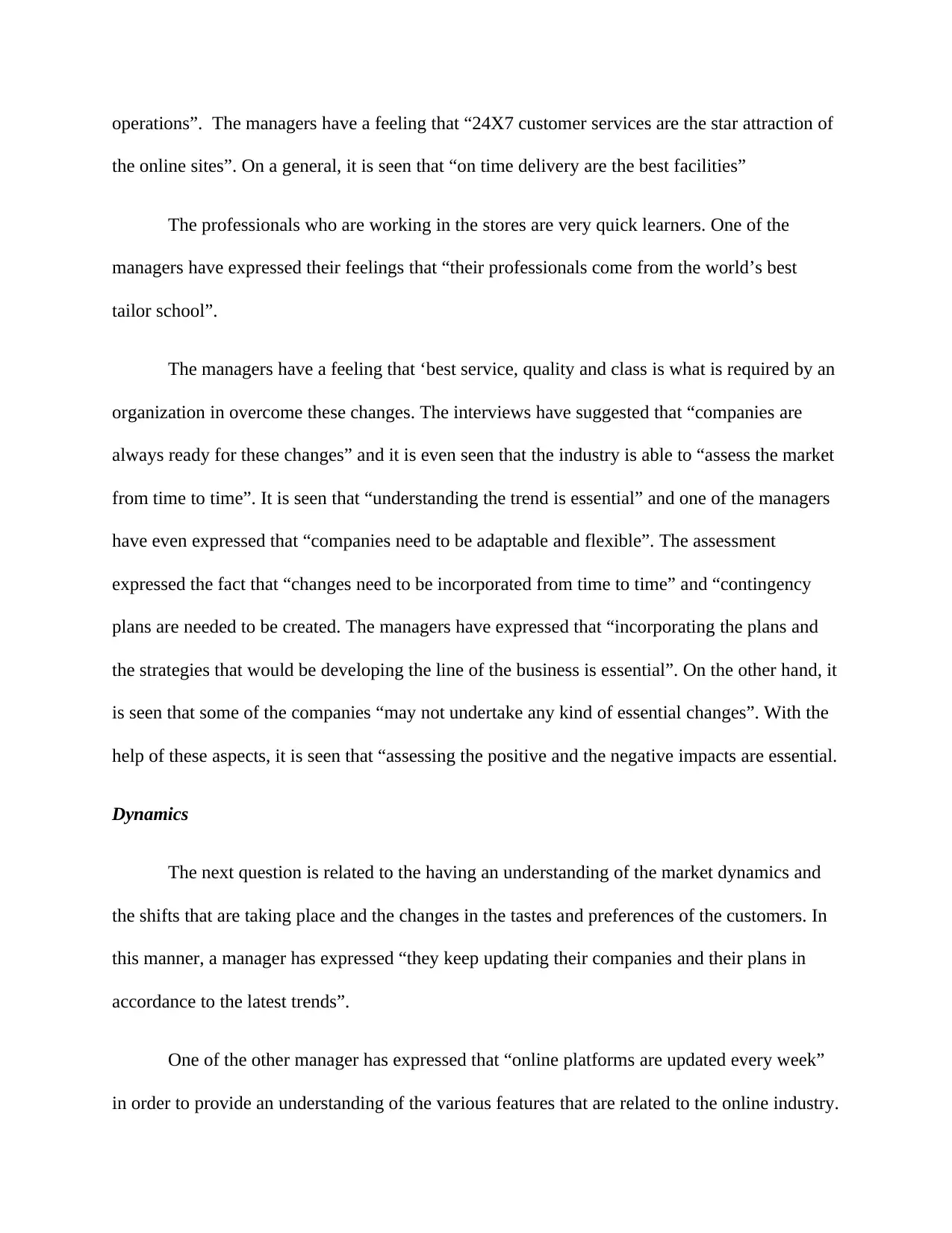
operations”. The managers have a feeling that “24X7 customer services are the star attraction of
the online sites”. On a general, it is seen that “on time delivery are the best facilities”
The professionals who are working in the stores are very quick learners. One of the
managers have expressed their feelings that “their professionals come from the world’s best
tailor school”.
The managers have a feeling that ‘best service, quality and class is what is required by an
organization in overcome these changes. The interviews have suggested that “companies are
always ready for these changes” and it is even seen that the industry is able to “assess the market
from time to time”. It is seen that “understanding the trend is essential” and one of the managers
have even expressed that “companies need to be adaptable and flexible”. The assessment
expressed the fact that “changes need to be incorporated from time to time” and “contingency
plans are needed to be created. The managers have expressed that “incorporating the plans and
the strategies that would be developing the line of the business is essential”. On the other hand, it
is seen that some of the companies “may not undertake any kind of essential changes”. With the
help of these aspects, it is seen that “assessing the positive and the negative impacts are essential.
Dynamics
The next question is related to the having an understanding of the market dynamics and
the shifts that are taking place and the changes in the tastes and preferences of the customers. In
this manner, a manager has expressed “they keep updating their companies and their plans in
accordance to the latest trends”.
One of the other manager has expressed that “online platforms are updated every week”
in order to provide an understanding of the various features that are related to the online industry.
the online sites”. On a general, it is seen that “on time delivery are the best facilities”
The professionals who are working in the stores are very quick learners. One of the
managers have expressed their feelings that “their professionals come from the world’s best
tailor school”.
The managers have a feeling that ‘best service, quality and class is what is required by an
organization in overcome these changes. The interviews have suggested that “companies are
always ready for these changes” and it is even seen that the industry is able to “assess the market
from time to time”. It is seen that “understanding the trend is essential” and one of the managers
have even expressed that “companies need to be adaptable and flexible”. The assessment
expressed the fact that “changes need to be incorporated from time to time” and “contingency
plans are needed to be created. The managers have expressed that “incorporating the plans and
the strategies that would be developing the line of the business is essential”. On the other hand, it
is seen that some of the companies “may not undertake any kind of essential changes”. With the
help of these aspects, it is seen that “assessing the positive and the negative impacts are essential.
Dynamics
The next question is related to the having an understanding of the market dynamics and
the shifts that are taking place and the changes in the tastes and preferences of the customers. In
this manner, a manager has expressed “they keep updating their companies and their plans in
accordance to the latest trends”.
One of the other manager has expressed that “online platforms are updated every week”
in order to provide an understanding of the various features that are related to the online industry.

“Fashion shows are the best ways to attract the customers” as the customers become aware of the
displayed product and can have an understanding of how the product would look on them.
It is seen that this industry is “conscious and demanding” and therefore there exists high
potential for growth. The responses have suggested that “the industry is reaching its height” and
hence “get the best they can”. The clothing industry is “affordable and luxury” and therefore the
results would be fundamental for the development of the same.
The managers have expressed that the “digital networking and innovation played a huge
role” and “the clothing industry has been growing and contributes for the betterment of the
services”.
The managers have expressed that “clothing industry has been growing with the growing
world”. The managers have expressed that “shift in the dynamics are able to develop the clothing
industry”. The overall results have indicated that “changes are positive in nature”.
Operations
This question is associated with the operations that are taking place and it is seen that
there have been several developments that have been taking place and one of the managers have
expressed that order to assess the operations “evaluate the competition as well as the target
markets”. It is seen that many companies have been working for “past 10 years”. The managers
have expressed that operations are related to the “sale of all type of clothing ranging from
casuals, formals shoes, party wear, accessories, bags and others”. One of the managers have
expressed that their company is “well known for their jeans”.
displayed product and can have an understanding of how the product would look on them.
It is seen that this industry is “conscious and demanding” and therefore there exists high
potential for growth. The responses have suggested that “the industry is reaching its height” and
hence “get the best they can”. The clothing industry is “affordable and luxury” and therefore the
results would be fundamental for the development of the same.
The managers have expressed that the “digital networking and innovation played a huge
role” and “the clothing industry has been growing and contributes for the betterment of the
services”.
The managers have expressed that “clothing industry has been growing with the growing
world”. The managers have expressed that “shift in the dynamics are able to develop the clothing
industry”. The overall results have indicated that “changes are positive in nature”.
Operations
This question is associated with the operations that are taking place and it is seen that
there have been several developments that have been taking place and one of the managers have
expressed that order to assess the operations “evaluate the competition as well as the target
markets”. It is seen that many companies have been working for “past 10 years”. The managers
have expressed that operations are related to the “sale of all type of clothing ranging from
casuals, formals shoes, party wear, accessories, bags and others”. One of the managers have
expressed that their company is “well known for their jeans”.
Paraphrase This Document
Need a fresh take? Get an instant paraphrase of this document with our AI Paraphraser
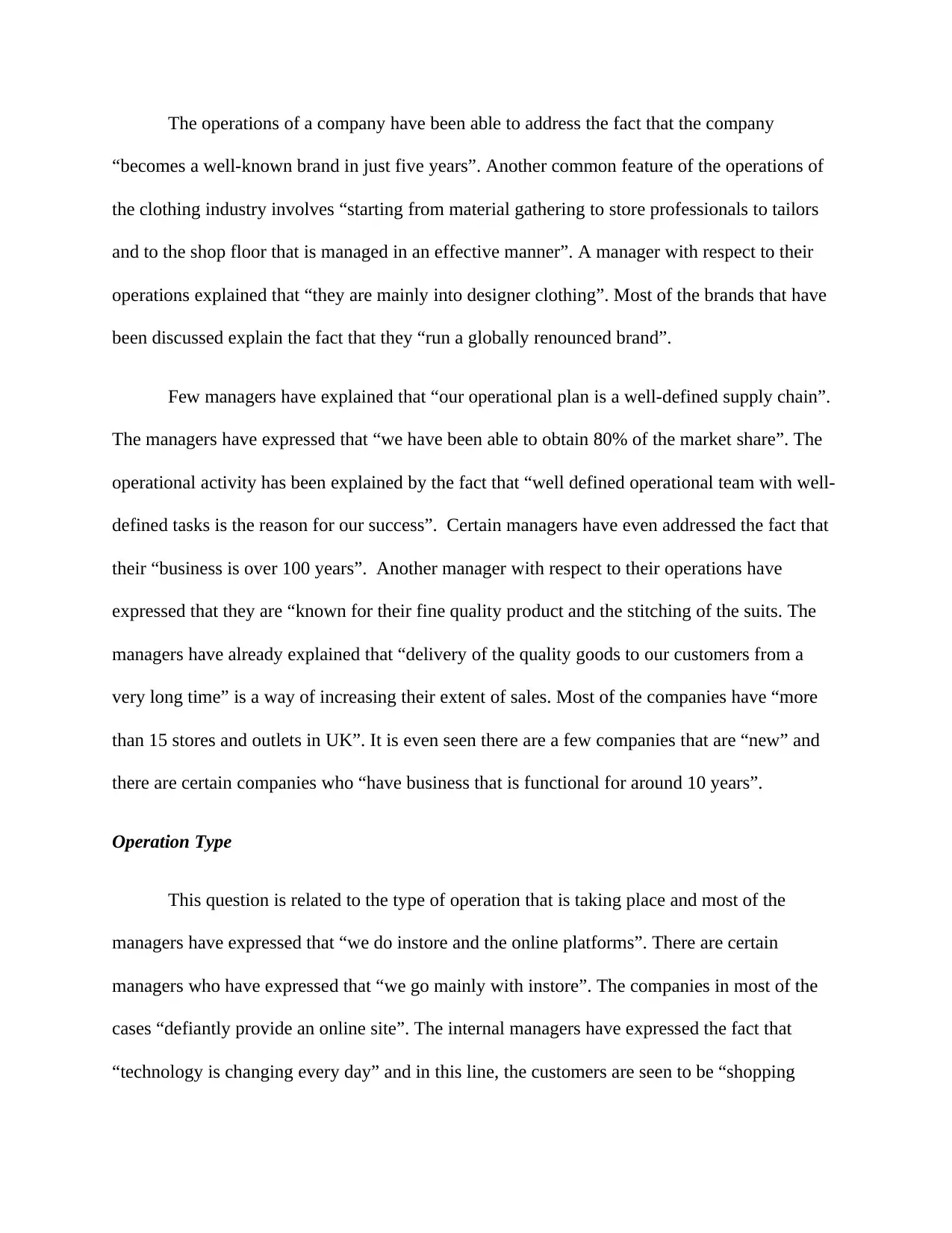
The operations of a company have been able to address the fact that the company
“becomes a well-known brand in just five years”. Another common feature of the operations of
the clothing industry involves “starting from material gathering to store professionals to tailors
and to the shop floor that is managed in an effective manner”. A manager with respect to their
operations explained that “they are mainly into designer clothing”. Most of the brands that have
been discussed explain the fact that they “run a globally renounced brand”.
Few managers have explained that “our operational plan is a well-defined supply chain”.
The managers have expressed that “we have been able to obtain 80% of the market share”. The
operational activity has been explained by the fact that “well defined operational team with well-
defined tasks is the reason for our success”. Certain managers have even addressed the fact that
their “business is over 100 years”. Another manager with respect to their operations have
expressed that they are “known for their fine quality product and the stitching of the suits. The
managers have already explained that “delivery of the quality goods to our customers from a
very long time” is a way of increasing their extent of sales. Most of the companies have “more
than 15 stores and outlets in UK”. It is even seen there are a few companies that are “new” and
there are certain companies who “have business that is functional for around 10 years”.
Operation Type
This question is related to the type of operation that is taking place and most of the
managers have expressed that “we do instore and the online platforms”. There are certain
managers who have expressed that “we go mainly with instore”. The companies in most of the
cases “defiantly provide an online site”. The internal managers have expressed the fact that
“technology is changing every day” and in this line, the customers are seen to be “shopping
“becomes a well-known brand in just five years”. Another common feature of the operations of
the clothing industry involves “starting from material gathering to store professionals to tailors
and to the shop floor that is managed in an effective manner”. A manager with respect to their
operations explained that “they are mainly into designer clothing”. Most of the brands that have
been discussed explain the fact that they “run a globally renounced brand”.
Few managers have explained that “our operational plan is a well-defined supply chain”.
The managers have expressed that “we have been able to obtain 80% of the market share”. The
operational activity has been explained by the fact that “well defined operational team with well-
defined tasks is the reason for our success”. Certain managers have even addressed the fact that
their “business is over 100 years”. Another manager with respect to their operations have
expressed that they are “known for their fine quality product and the stitching of the suits. The
managers have already explained that “delivery of the quality goods to our customers from a
very long time” is a way of increasing their extent of sales. Most of the companies have “more
than 15 stores and outlets in UK”. It is even seen there are a few companies that are “new” and
there are certain companies who “have business that is functional for around 10 years”.
Operation Type
This question is related to the type of operation that is taking place and most of the
managers have expressed that “we do instore and the online platforms”. There are certain
managers who have expressed that “we go mainly with instore”. The companies in most of the
cases “defiantly provide an online site”. The internal managers have expressed the fact that
“technology is changing every day” and in this line, the customers are seen to be “shopping
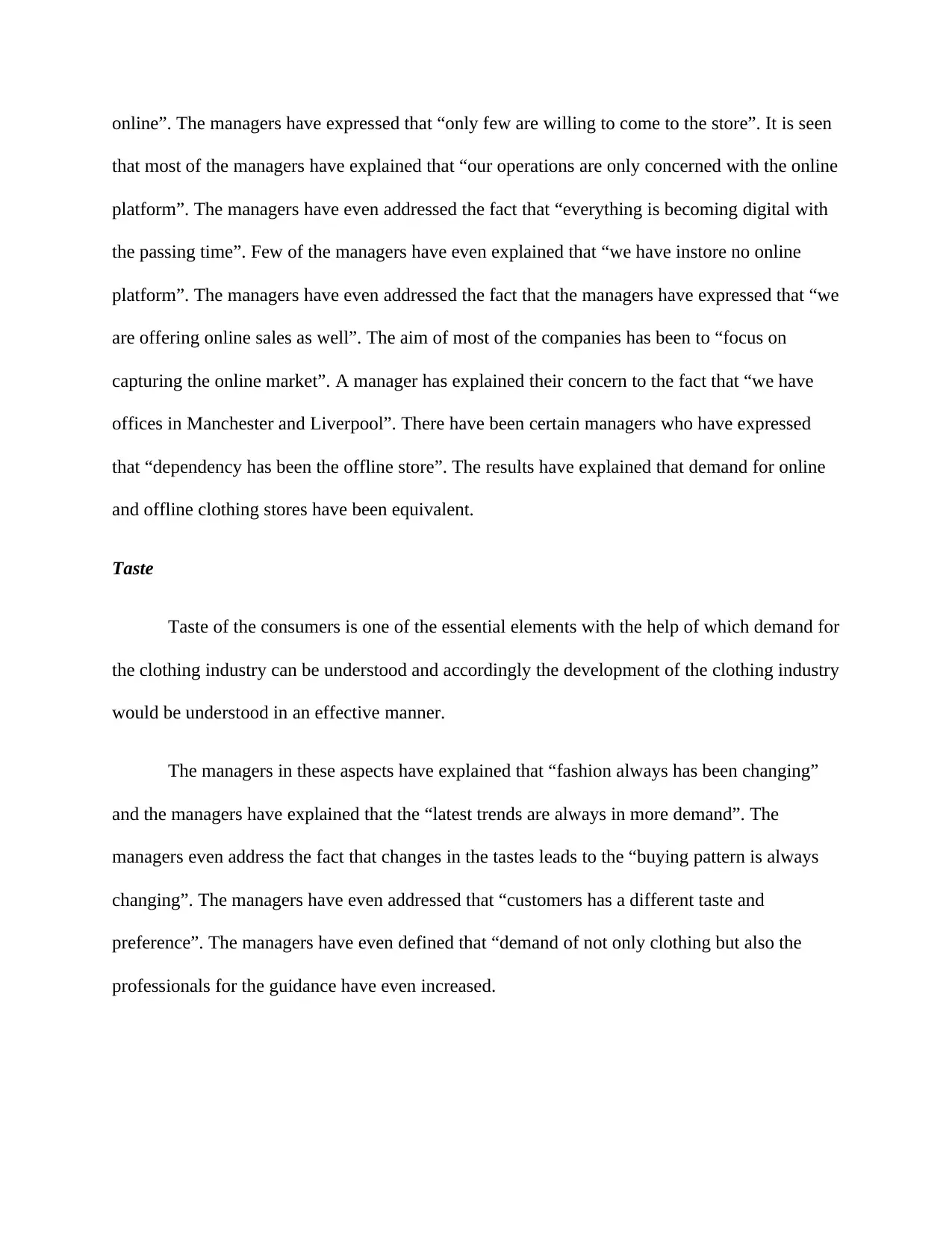
online”. The managers have expressed that “only few are willing to come to the store”. It is seen
that most of the managers have explained that “our operations are only concerned with the online
platform”. The managers have even addressed the fact that “everything is becoming digital with
the passing time”. Few of the managers have even explained that “we have instore no online
platform”. The managers have even addressed the fact that the managers have expressed that “we
are offering online sales as well”. The aim of most of the companies has been to “focus on
capturing the online market”. A manager has explained their concern to the fact that “we have
offices in Manchester and Liverpool”. There have been certain managers who have expressed
that “dependency has been the offline store”. The results have explained that demand for online
and offline clothing stores have been equivalent.
Taste
Taste of the consumers is one of the essential elements with the help of which demand for
the clothing industry can be understood and accordingly the development of the clothing industry
would be understood in an effective manner.
The managers in these aspects have explained that “fashion always has been changing”
and the managers have explained that the “latest trends are always in more demand”. The
managers even address the fact that changes in the tastes leads to the “buying pattern is always
changing”. The managers have even addressed that “customers has a different taste and
preference”. The managers have even defined that “demand of not only clothing but also the
professionals for the guidance have even increased.
that most of the managers have explained that “our operations are only concerned with the online
platform”. The managers have even addressed the fact that “everything is becoming digital with
the passing time”. Few of the managers have even explained that “we have instore no online
platform”. The managers have even addressed the fact that the managers have expressed that “we
are offering online sales as well”. The aim of most of the companies has been to “focus on
capturing the online market”. A manager has explained their concern to the fact that “we have
offices in Manchester and Liverpool”. There have been certain managers who have expressed
that “dependency has been the offline store”. The results have explained that demand for online
and offline clothing stores have been equivalent.
Taste
Taste of the consumers is one of the essential elements with the help of which demand for
the clothing industry can be understood and accordingly the development of the clothing industry
would be understood in an effective manner.
The managers in these aspects have explained that “fashion always has been changing”
and the managers have explained that the “latest trends are always in more demand”. The
managers even address the fact that changes in the tastes leads to the “buying pattern is always
changing”. The managers have even addressed that “customers has a different taste and
preference”. The managers have even defined that “demand of not only clothing but also the
professionals for the guidance have even increased.
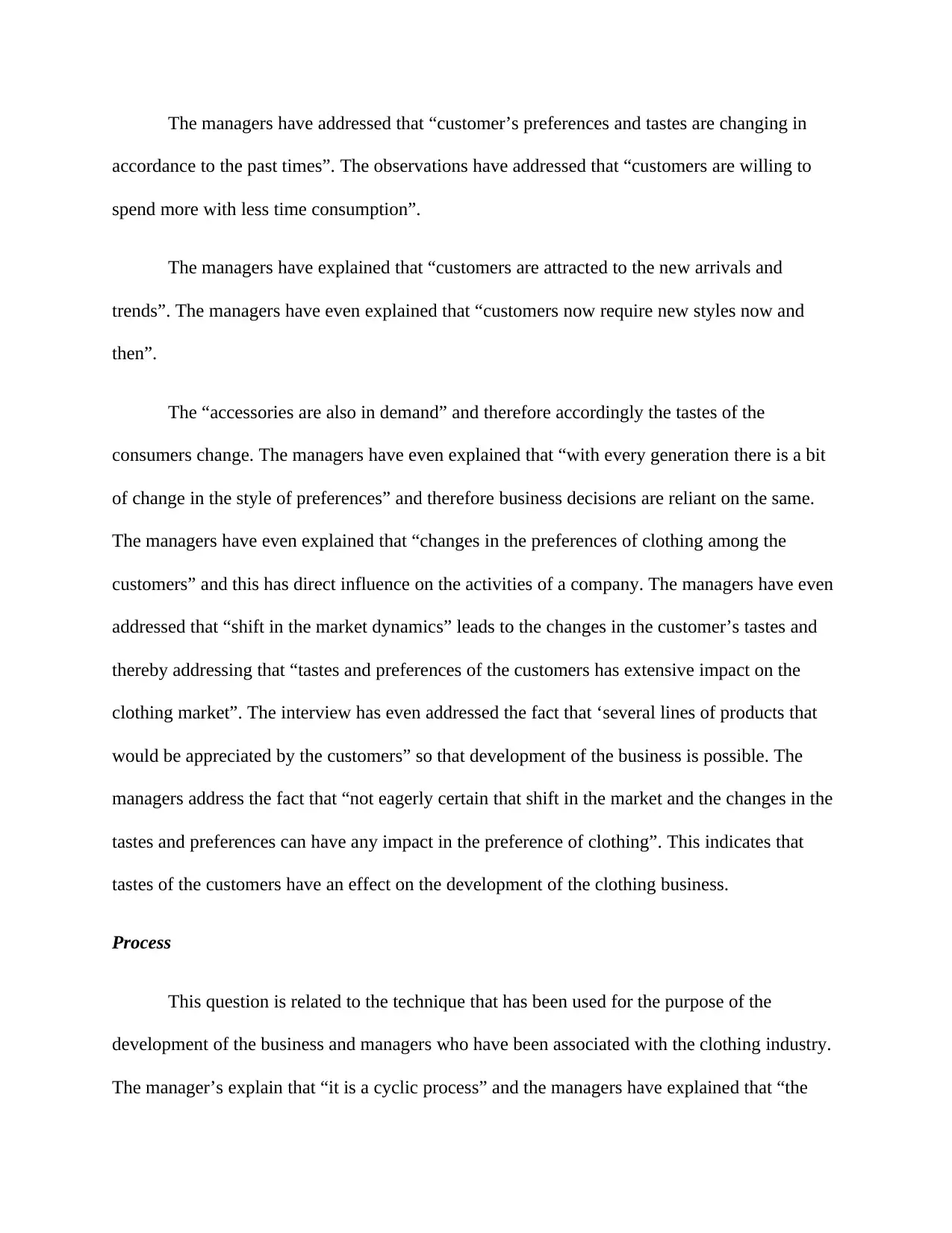
The managers have addressed that “customer’s preferences and tastes are changing in
accordance to the past times”. The observations have addressed that “customers are willing to
spend more with less time consumption”.
The managers have explained that “customers are attracted to the new arrivals and
trends”. The managers have even explained that “customers now require new styles now and
then”.
The “accessories are also in demand” and therefore accordingly the tastes of the
consumers change. The managers have even explained that “with every generation there is a bit
of change in the style of preferences” and therefore business decisions are reliant on the same.
The managers have even explained that “changes in the preferences of clothing among the
customers” and this has direct influence on the activities of a company. The managers have even
addressed that “shift in the market dynamics” leads to the changes in the customer’s tastes and
thereby addressing that “tastes and preferences of the customers has extensive impact on the
clothing market”. The interview has even addressed the fact that ‘several lines of products that
would be appreciated by the customers” so that development of the business is possible. The
managers address the fact that “not eagerly certain that shift in the market and the changes in the
tastes and preferences can have any impact in the preference of clothing”. This indicates that
tastes of the customers have an effect on the development of the clothing business.
Process
This question is related to the technique that has been used for the purpose of the
development of the business and managers who have been associated with the clothing industry.
The manager’s explain that “it is a cyclic process” and the managers have explained that “the
accordance to the past times”. The observations have addressed that “customers are willing to
spend more with less time consumption”.
The managers have explained that “customers are attracted to the new arrivals and
trends”. The managers have even explained that “customers now require new styles now and
then”.
The “accessories are also in demand” and therefore accordingly the tastes of the
consumers change. The managers have even explained that “with every generation there is a bit
of change in the style of preferences” and therefore business decisions are reliant on the same.
The managers have even explained that “changes in the preferences of clothing among the
customers” and this has direct influence on the activities of a company. The managers have even
addressed that “shift in the market dynamics” leads to the changes in the customer’s tastes and
thereby addressing that “tastes and preferences of the customers has extensive impact on the
clothing market”. The interview has even addressed the fact that ‘several lines of products that
would be appreciated by the customers” so that development of the business is possible. The
managers address the fact that “not eagerly certain that shift in the market and the changes in the
tastes and preferences can have any impact in the preference of clothing”. This indicates that
tastes of the customers have an effect on the development of the clothing business.
Process
This question is related to the technique that has been used for the purpose of the
development of the business and managers who have been associated with the clothing industry.
The manager’s explain that “it is a cyclic process” and the managers have explained that “the
Secure Best Marks with AI Grader
Need help grading? Try our AI Grader for instant feedback on your assignments.
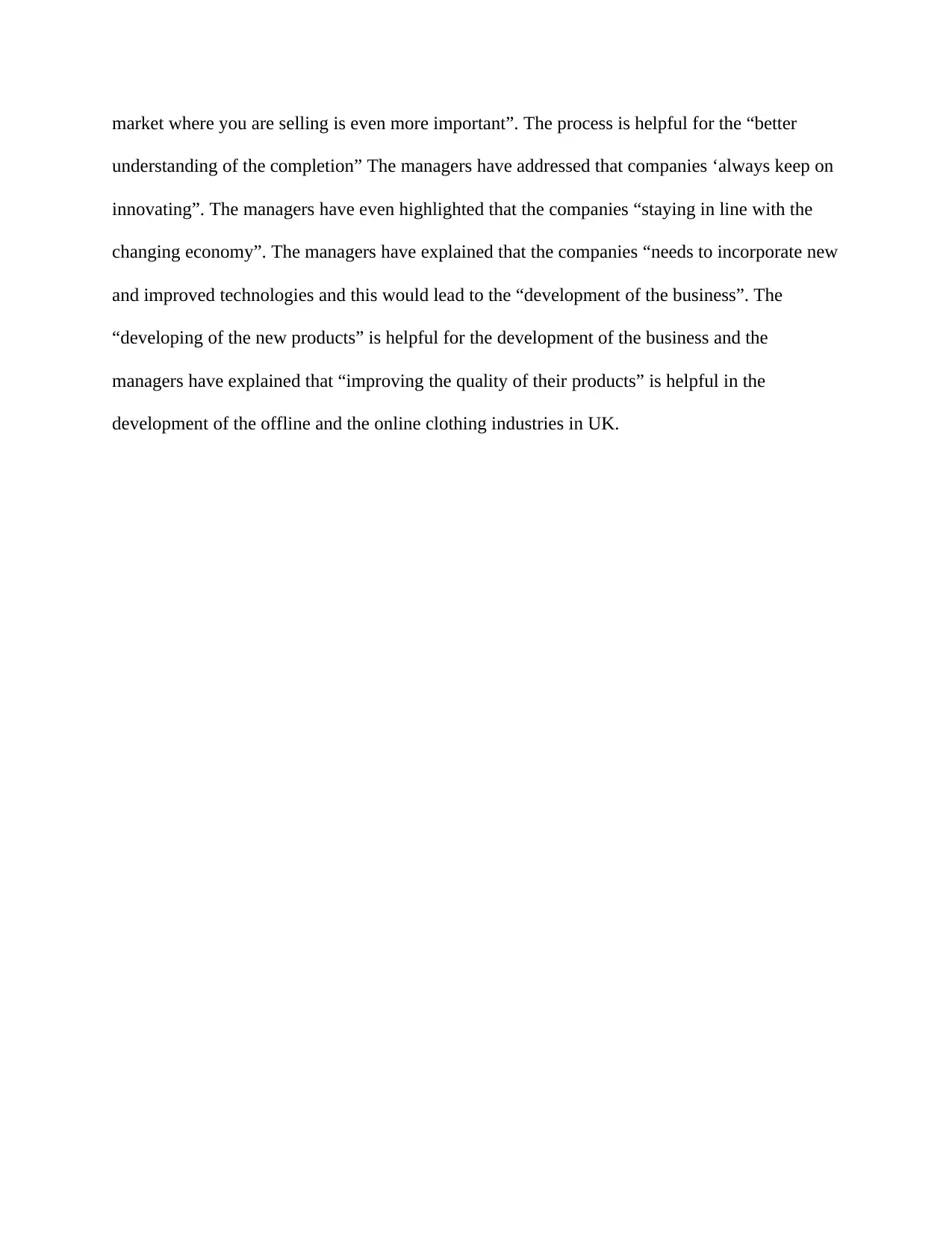
market where you are selling is even more important”. The process is helpful for the “better
understanding of the completion” The managers have addressed that companies ‘always keep on
innovating”. The managers have even highlighted that the companies “staying in line with the
changing economy”. The managers have explained that the companies “needs to incorporate new
and improved technologies and this would lead to the “development of the business”. The
“developing of the new products” is helpful for the development of the business and the
managers have explained that “improving the quality of their products” is helpful in the
development of the offline and the online clothing industries in UK.
understanding of the completion” The managers have addressed that companies ‘always keep on
innovating”. The managers have even highlighted that the companies “staying in line with the
changing economy”. The managers have explained that the companies “needs to incorporate new
and improved technologies and this would lead to the “development of the business”. The
“developing of the new products” is helpful for the development of the business and the
managers have explained that “improving the quality of their products” is helpful in the
development of the offline and the online clothing industries in UK.
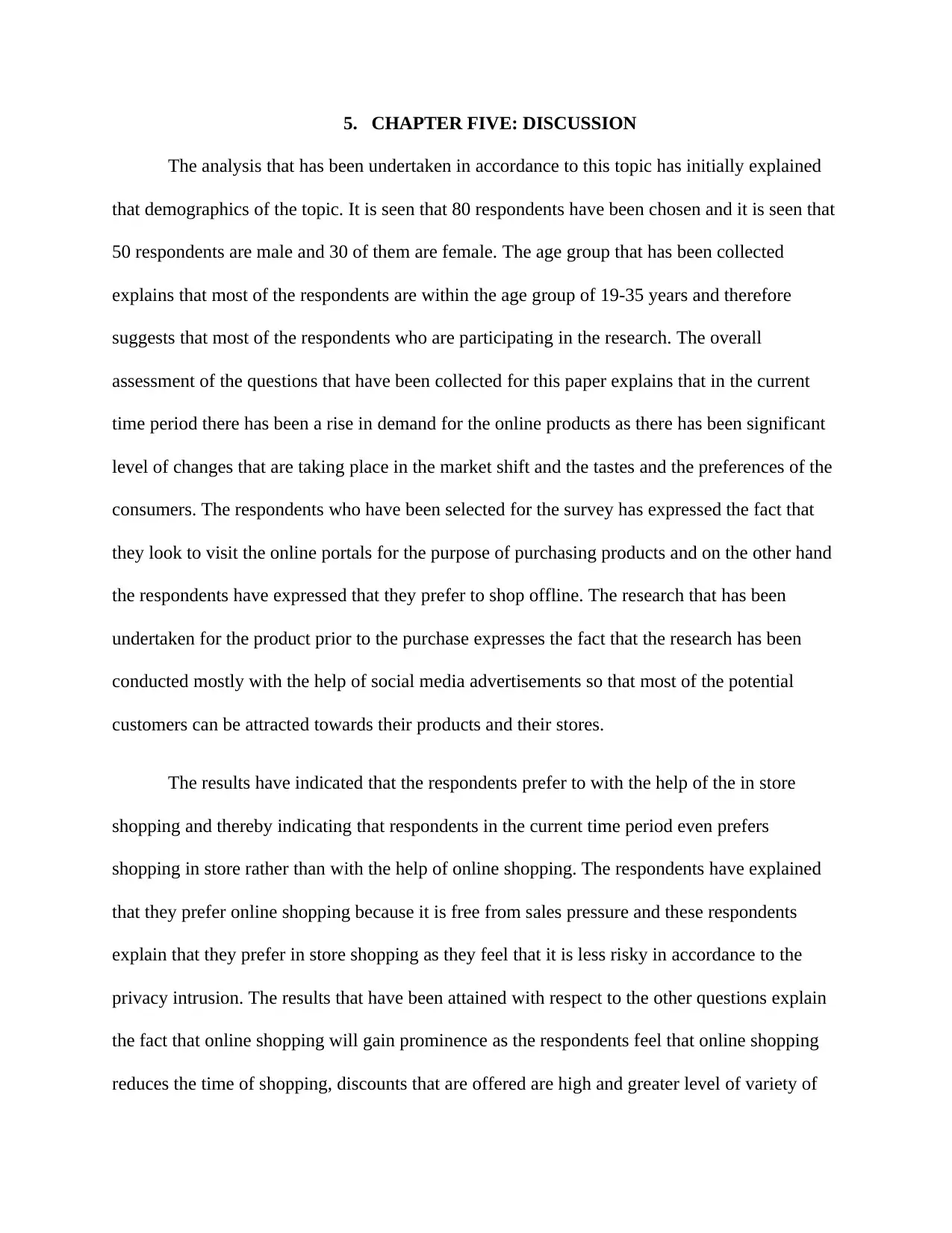
5. CHAPTER FIVE: DISCUSSION
The analysis that has been undertaken in accordance to this topic has initially explained
that demographics of the topic. It is seen that 80 respondents have been chosen and it is seen that
50 respondents are male and 30 of them are female. The age group that has been collected
explains that most of the respondents are within the age group of 19-35 years and therefore
suggests that most of the respondents who are participating in the research. The overall
assessment of the questions that have been collected for this paper explains that in the current
time period there has been a rise in demand for the online products as there has been significant
level of changes that are taking place in the market shift and the tastes and the preferences of the
consumers. The respondents who have been selected for the survey has expressed the fact that
they look to visit the online portals for the purpose of purchasing products and on the other hand
the respondents have expressed that they prefer to shop offline. The research that has been
undertaken for the product prior to the purchase expresses the fact that the research has been
conducted mostly with the help of social media advertisements so that most of the potential
customers can be attracted towards their products and their stores.
The results have indicated that the respondents prefer to with the help of the in store
shopping and thereby indicating that respondents in the current time period even prefers
shopping in store rather than with the help of online shopping. The respondents have explained
that they prefer online shopping because it is free from sales pressure and these respondents
explain that they prefer in store shopping as they feel that it is less risky in accordance to the
privacy intrusion. The results that have been attained with respect to the other questions explain
the fact that online shopping will gain prominence as the respondents feel that online shopping
reduces the time of shopping, discounts that are offered are high and greater level of variety of
The analysis that has been undertaken in accordance to this topic has initially explained
that demographics of the topic. It is seen that 80 respondents have been chosen and it is seen that
50 respondents are male and 30 of them are female. The age group that has been collected
explains that most of the respondents are within the age group of 19-35 years and therefore
suggests that most of the respondents who are participating in the research. The overall
assessment of the questions that have been collected for this paper explains that in the current
time period there has been a rise in demand for the online products as there has been significant
level of changes that are taking place in the market shift and the tastes and the preferences of the
consumers. The respondents who have been selected for the survey has expressed the fact that
they look to visit the online portals for the purpose of purchasing products and on the other hand
the respondents have expressed that they prefer to shop offline. The research that has been
undertaken for the product prior to the purchase expresses the fact that the research has been
conducted mostly with the help of social media advertisements so that most of the potential
customers can be attracted towards their products and their stores.
The results have indicated that the respondents prefer to with the help of the in store
shopping and thereby indicating that respondents in the current time period even prefers
shopping in store rather than with the help of online shopping. The respondents have explained
that they prefer online shopping because it is free from sales pressure and these respondents
explain that they prefer in store shopping as they feel that it is less risky in accordance to the
privacy intrusion. The results that have been attained with respect to the other questions explain
the fact that online shopping will gain prominence as the respondents feel that online shopping
reduces the time of shopping, discounts that are offered are high and greater level of variety of
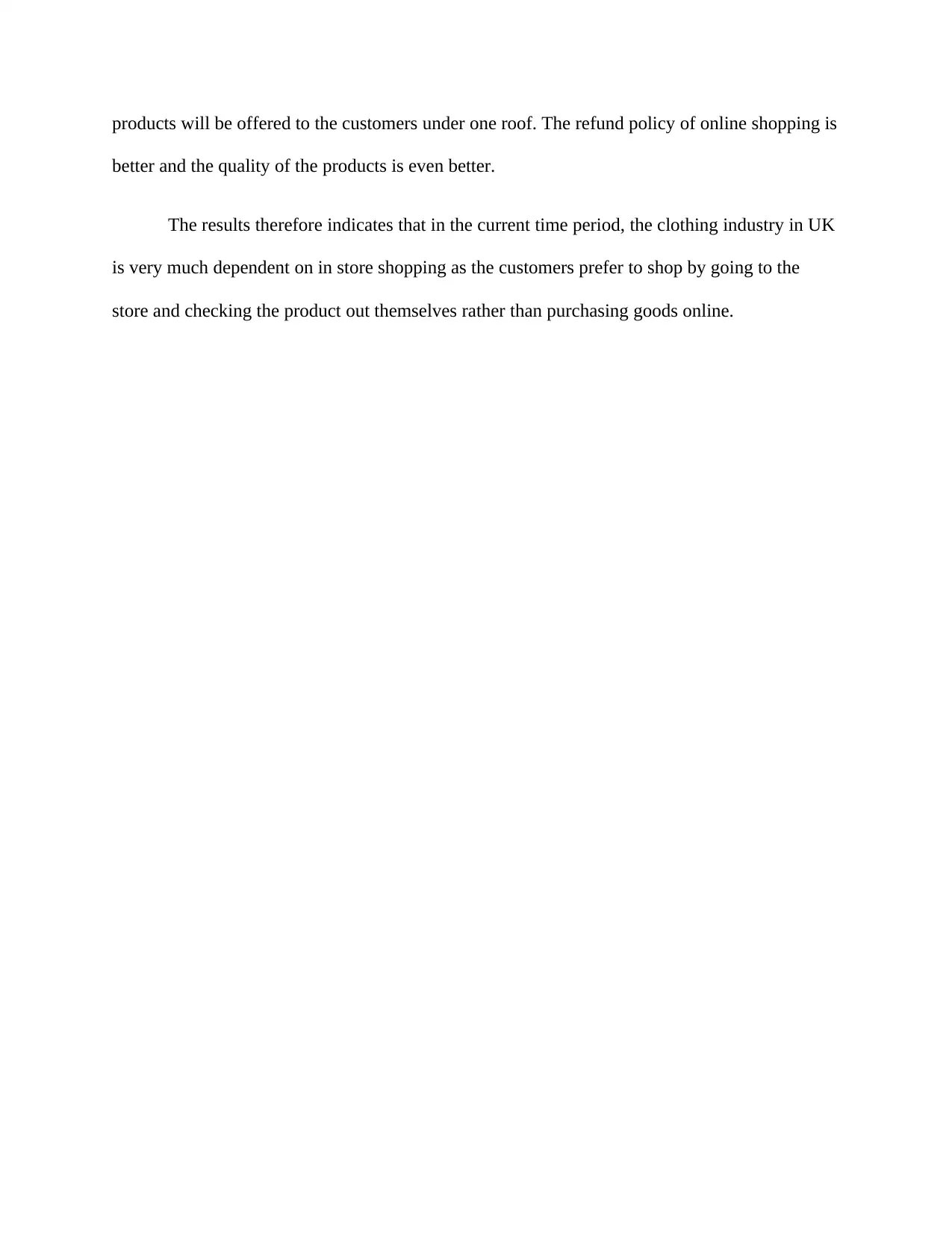
products will be offered to the customers under one roof. The refund policy of online shopping is
better and the quality of the products is even better.
The results therefore indicates that in the current time period, the clothing industry in UK
is very much dependent on in store shopping as the customers prefer to shop by going to the
store and checking the product out themselves rather than purchasing goods online.
better and the quality of the products is even better.
The results therefore indicates that in the current time period, the clothing industry in UK
is very much dependent on in store shopping as the customers prefer to shop by going to the
store and checking the product out themselves rather than purchasing goods online.
Paraphrase This Document
Need a fresh take? Get an instant paraphrase of this document with our AI Paraphraser
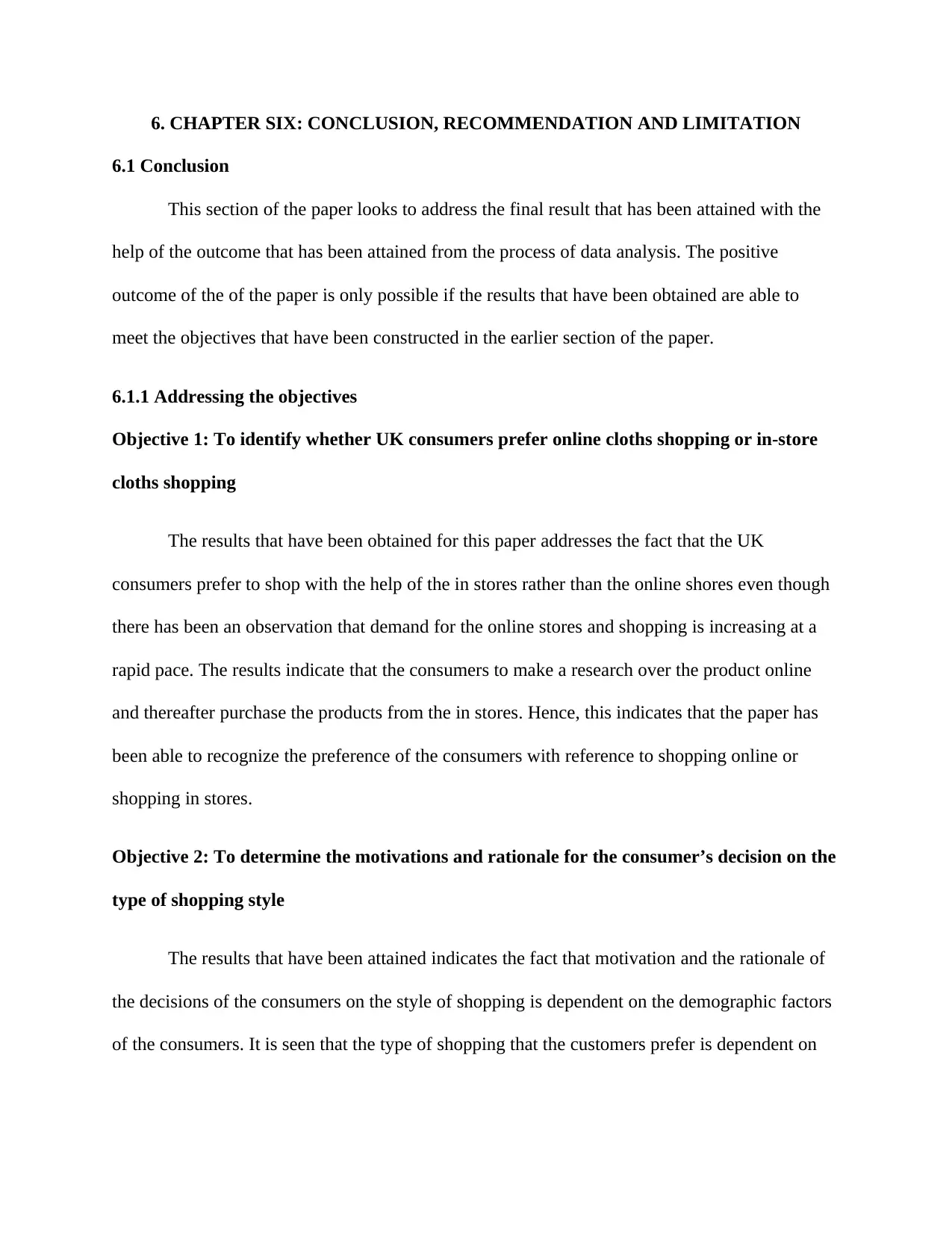
6. CHAPTER SIX: CONCLUSION, RECOMMENDATION AND LIMITATION
6.1 Conclusion
This section of the paper looks to address the final result that has been attained with the
help of the outcome that has been attained from the process of data analysis. The positive
outcome of the of the paper is only possible if the results that have been obtained are able to
meet the objectives that have been constructed in the earlier section of the paper.
6.1.1 Addressing the objectives
Objective 1: To identify whether UK consumers prefer online cloths shopping or in-store
cloths shopping
The results that have been obtained for this paper addresses the fact that the UK
consumers prefer to shop with the help of the in stores rather than the online shores even though
there has been an observation that demand for the online stores and shopping is increasing at a
rapid pace. The results indicate that the consumers to make a research over the product online
and thereafter purchase the products from the in stores. Hence, this indicates that the paper has
been able to recognize the preference of the consumers with reference to shopping online or
shopping in stores.
Objective 2: To determine the motivations and rationale for the consumer’s decision on the
type of shopping style
The results that have been attained indicates the fact that motivation and the rationale of
the decisions of the consumers on the style of shopping is dependent on the demographic factors
of the consumers. It is seen that the type of shopping that the customers prefer is dependent on
6.1 Conclusion
This section of the paper looks to address the final result that has been attained with the
help of the outcome that has been attained from the process of data analysis. The positive
outcome of the of the paper is only possible if the results that have been obtained are able to
meet the objectives that have been constructed in the earlier section of the paper.
6.1.1 Addressing the objectives
Objective 1: To identify whether UK consumers prefer online cloths shopping or in-store
cloths shopping
The results that have been obtained for this paper addresses the fact that the UK
consumers prefer to shop with the help of the in stores rather than the online shores even though
there has been an observation that demand for the online stores and shopping is increasing at a
rapid pace. The results indicate that the consumers to make a research over the product online
and thereafter purchase the products from the in stores. Hence, this indicates that the paper has
been able to recognize the preference of the consumers with reference to shopping online or
shopping in stores.
Objective 2: To determine the motivations and rationale for the consumer’s decision on the
type of shopping style
The results that have been attained indicates the fact that motivation and the rationale of
the decisions of the consumers on the style of shopping is dependent on the demographic factors
of the consumers. It is seen that the type of shopping that the customers prefer is dependent on

the age and the gender of the customers. Hence, the second objective has even been explained in
an effective manner.
Objective 3: To establish the implications of the trends for businesses in the UK’s fashion
retail industry
The results that have been attained with the help of data analysis indicates that UK’s
fashion retail industry has the demand for the current trends as the customers are looking for new
and stylish products even though the results have indicated that they prefer to shop with the help
of in stores rather than with the help of the online processes.
6.2 Recommendation
The paper has key level of implications for the ones who are citizens of UK who are
related to the fashion industry. The current trend that is available in the market needs to be
accepted and accordingly plans and policies need to be developed with the help of which the
company would be able to attract new and potential customers. It has been observed that the
consumers prefer to assess the product with the help of internet and therefore development of the
websites needs to be done with the help of which the customers would be attracted and thereby
effective results can be attained. It is essential for the companies to incorporate strategies for
online and the offline services with the help of which all sorts of customers can be satisfied and
development of the company can be attained.
6.3 Limitations
The limitations that have been attained for this paper indicates the fact that all the data
that has been collected may not provide effective results as the respondents as well as the
managers may be reluctant to share their actual feelings and this may hamper the actual findings
an effective manner.
Objective 3: To establish the implications of the trends for businesses in the UK’s fashion
retail industry
The results that have been attained with the help of data analysis indicates that UK’s
fashion retail industry has the demand for the current trends as the customers are looking for new
and stylish products even though the results have indicated that they prefer to shop with the help
of in stores rather than with the help of the online processes.
6.2 Recommendation
The paper has key level of implications for the ones who are citizens of UK who are
related to the fashion industry. The current trend that is available in the market needs to be
accepted and accordingly plans and policies need to be developed with the help of which the
company would be able to attract new and potential customers. It has been observed that the
consumers prefer to assess the product with the help of internet and therefore development of the
websites needs to be done with the help of which the customers would be attracted and thereby
effective results can be attained. It is essential for the companies to incorporate strategies for
online and the offline services with the help of which all sorts of customers can be satisfied and
development of the company can be attained.
6.3 Limitations
The limitations that have been attained for this paper indicates the fact that all the data
that has been collected may not provide effective results as the respondents as well as the
managers may be reluctant to share their actual feelings and this may hamper the actual findings
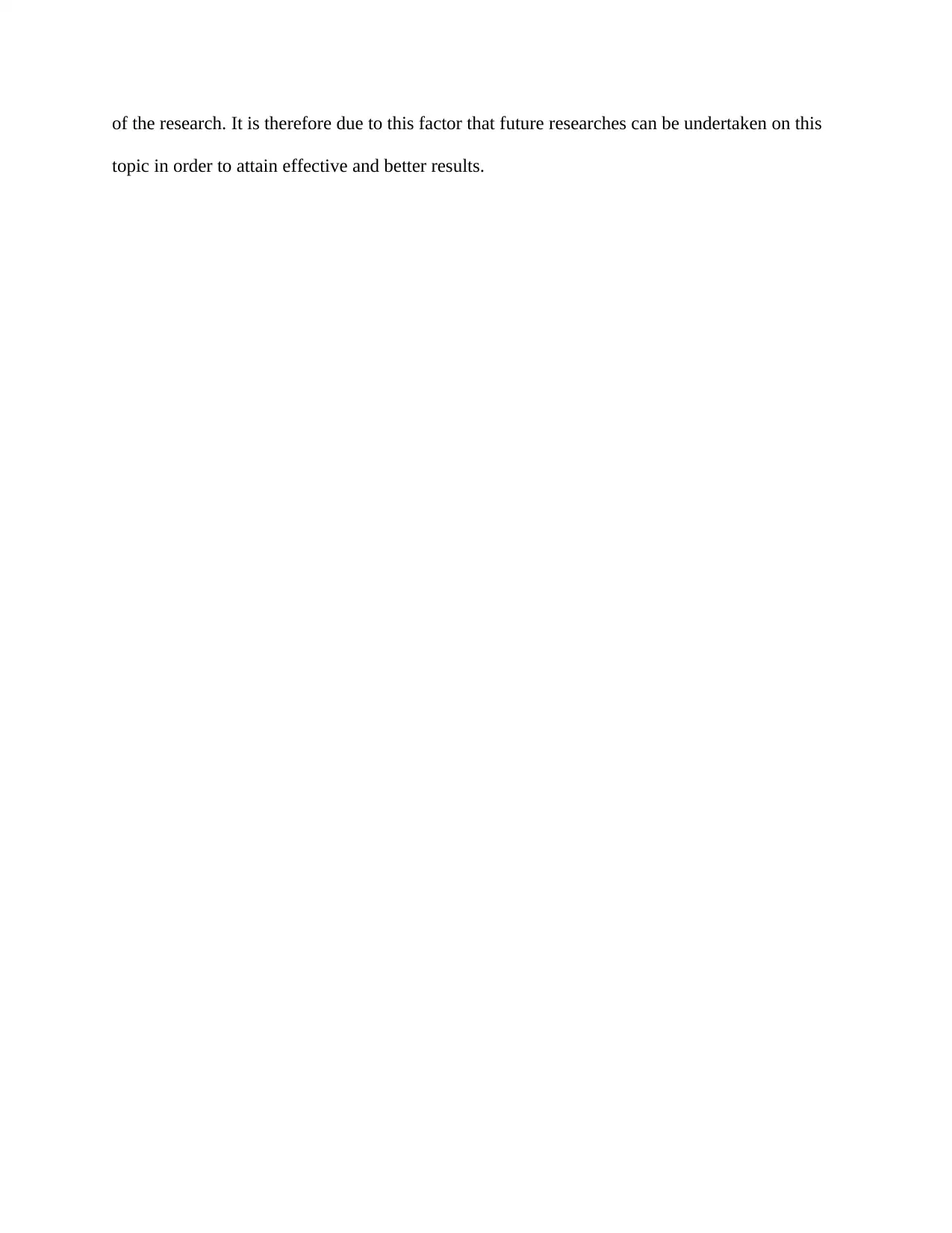
of the research. It is therefore due to this factor that future researches can be undertaken on this
topic in order to attain effective and better results.
topic in order to attain effective and better results.
Secure Best Marks with AI Grader
Need help grading? Try our AI Grader for instant feedback on your assignments.
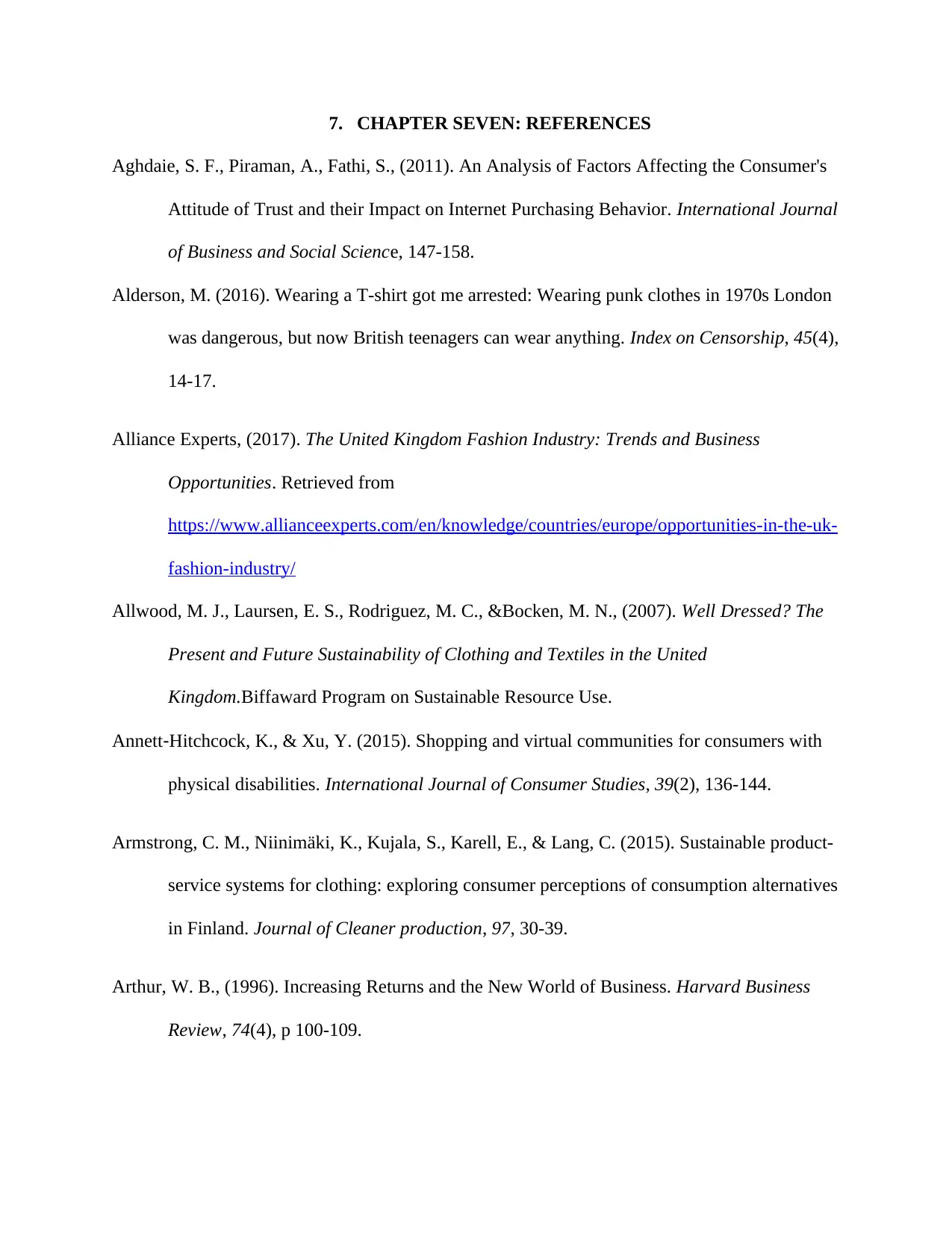
7. CHAPTER SEVEN: REFERENCES
Aghdaie, S. F., Piraman, A., Fathi, S., (2011). An Analysis of Factors Affecting the Consumer's
Attitude of Trust and their Impact on Internet Purchasing Behavior. International Journal
of Business and Social Science, 147-158.
Alderson, M. (2016). Wearing a T-shirt got me arrested: Wearing punk clothes in 1970s London
was dangerous, but now British teenagers can wear anything. Index on Censorship, 45(4),
14-17.
Alliance Experts, (2017). The United Kingdom Fashion Industry: Trends and Business
Opportunities. Retrieved from
https://www.allianceexperts.com/en/knowledge/countries/europe/opportunities-in-the-uk-
fashion-industry/
Allwood, M. J., Laursen, E. S., Rodriguez, M. C., &Bocken, M. N., (2007). Well Dressed? The
Present and Future Sustainability of Clothing and Textiles in the United
Kingdom.Biffaward Program on Sustainable Resource Use.
Annett‐Hitchcock, K., & Xu, Y. (2015). Shopping and virtual communities for consumers with
physical disabilities. International Journal of Consumer Studies, 39(2), 136-144.
Armstrong, C. M., Niinimäki, K., Kujala, S., Karell, E., & Lang, C. (2015). Sustainable product-
service systems for clothing: exploring consumer perceptions of consumption alternatives
in Finland. Journal of Cleaner production, 97, 30-39.
Arthur, W. B., (1996). Increasing Returns and the New World of Business. Harvard Business
Review, 74(4), p 100-109.
Aghdaie, S. F., Piraman, A., Fathi, S., (2011). An Analysis of Factors Affecting the Consumer's
Attitude of Trust and their Impact on Internet Purchasing Behavior. International Journal
of Business and Social Science, 147-158.
Alderson, M. (2016). Wearing a T-shirt got me arrested: Wearing punk clothes in 1970s London
was dangerous, but now British teenagers can wear anything. Index on Censorship, 45(4),
14-17.
Alliance Experts, (2017). The United Kingdom Fashion Industry: Trends and Business
Opportunities. Retrieved from
https://www.allianceexperts.com/en/knowledge/countries/europe/opportunities-in-the-uk-
fashion-industry/
Allwood, M. J., Laursen, E. S., Rodriguez, M. C., &Bocken, M. N., (2007). Well Dressed? The
Present and Future Sustainability of Clothing and Textiles in the United
Kingdom.Biffaward Program on Sustainable Resource Use.
Annett‐Hitchcock, K., & Xu, Y. (2015). Shopping and virtual communities for consumers with
physical disabilities. International Journal of Consumer Studies, 39(2), 136-144.
Armstrong, C. M., Niinimäki, K., Kujala, S., Karell, E., & Lang, C. (2015). Sustainable product-
service systems for clothing: exploring consumer perceptions of consumption alternatives
in Finland. Journal of Cleaner production, 97, 30-39.
Arthur, W. B., (1996). Increasing Returns and the New World of Business. Harvard Business
Review, 74(4), p 100-109.
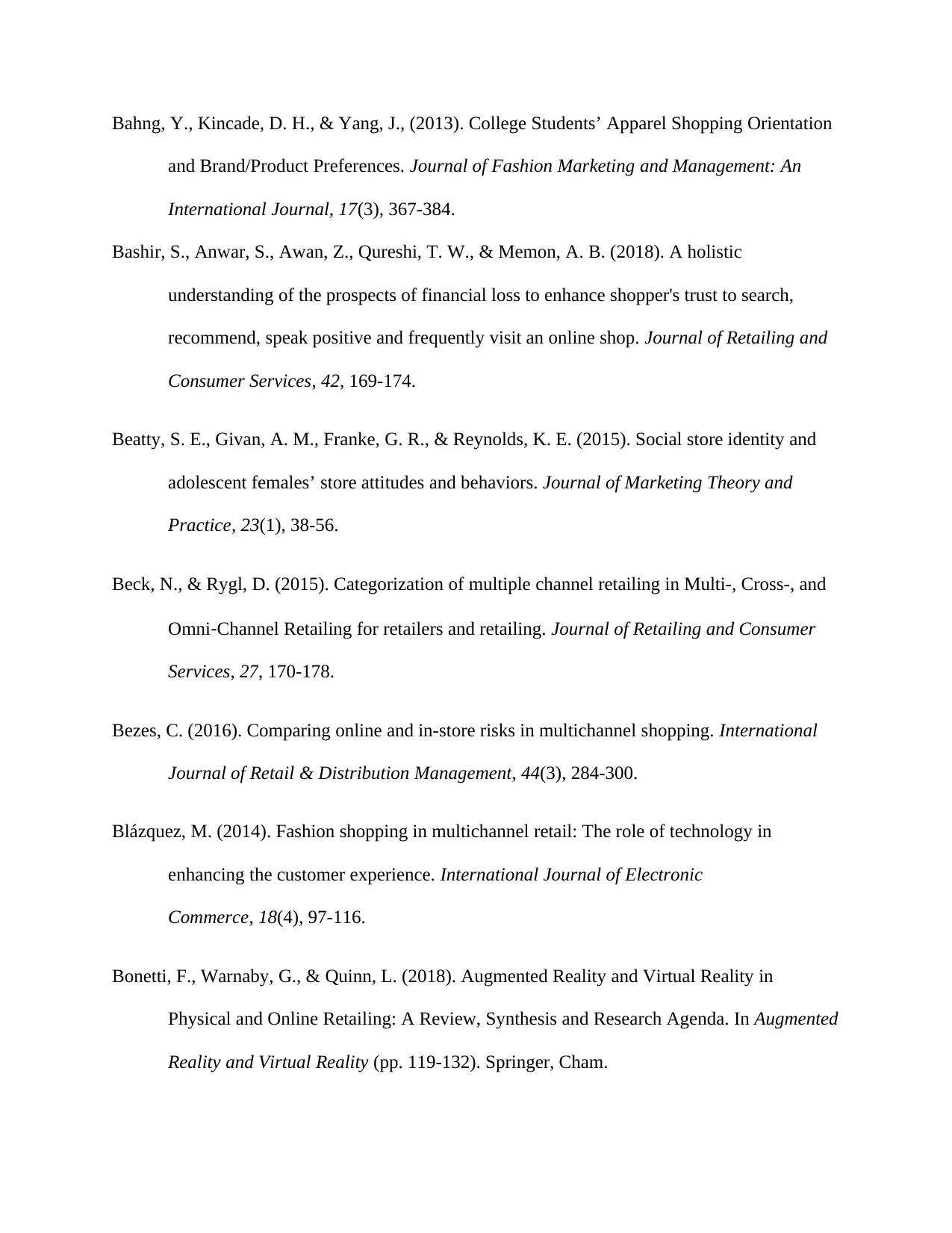
Bahng, Y., Kincade, D. H., & Yang, J., (2013). College Students’ Apparel Shopping Orientation
and Brand/Product Preferences. Journal of Fashion Marketing and Management: An
International Journal, 17(3), 367-384.
Bashir, S., Anwar, S., Awan, Z., Qureshi, T. W., & Memon, A. B. (2018). A holistic
understanding of the prospects of financial loss to enhance shopper's trust to search,
recommend, speak positive and frequently visit an online shop. Journal of Retailing and
Consumer Services, 42, 169-174.
Beatty, S. E., Givan, A. M., Franke, G. R., & Reynolds, K. E. (2015). Social store identity and
adolescent females’ store attitudes and behaviors. Journal of Marketing Theory and
Practice, 23(1), 38-56.
Beck, N., & Rygl, D. (2015). Categorization of multiple channel retailing in Multi-, Cross-, and
Omni‐Channel Retailing for retailers and retailing. Journal of Retailing and Consumer
Services, 27, 170-178.
Bezes, C. (2016). Comparing online and in-store risks in multichannel shopping. International
Journal of Retail & Distribution Management, 44(3), 284-300.
Blázquez, M. (2014). Fashion shopping in multichannel retail: The role of technology in
enhancing the customer experience. International Journal of Electronic
Commerce, 18(4), 97-116.
Bonetti, F., Warnaby, G., & Quinn, L. (2018). Augmented Reality and Virtual Reality in
Physical and Online Retailing: A Review, Synthesis and Research Agenda. In Augmented
Reality and Virtual Reality (pp. 119-132). Springer, Cham.
and Brand/Product Preferences. Journal of Fashion Marketing and Management: An
International Journal, 17(3), 367-384.
Bashir, S., Anwar, S., Awan, Z., Qureshi, T. W., & Memon, A. B. (2018). A holistic
understanding of the prospects of financial loss to enhance shopper's trust to search,
recommend, speak positive and frequently visit an online shop. Journal of Retailing and
Consumer Services, 42, 169-174.
Beatty, S. E., Givan, A. M., Franke, G. R., & Reynolds, K. E. (2015). Social store identity and
adolescent females’ store attitudes and behaviors. Journal of Marketing Theory and
Practice, 23(1), 38-56.
Beck, N., & Rygl, D. (2015). Categorization of multiple channel retailing in Multi-, Cross-, and
Omni‐Channel Retailing for retailers and retailing. Journal of Retailing and Consumer
Services, 27, 170-178.
Bezes, C. (2016). Comparing online and in-store risks in multichannel shopping. International
Journal of Retail & Distribution Management, 44(3), 284-300.
Blázquez, M. (2014). Fashion shopping in multichannel retail: The role of technology in
enhancing the customer experience. International Journal of Electronic
Commerce, 18(4), 97-116.
Bonetti, F., Warnaby, G., & Quinn, L. (2018). Augmented Reality and Virtual Reality in
Physical and Online Retailing: A Review, Synthesis and Research Agenda. In Augmented
Reality and Virtual Reality (pp. 119-132). Springer, Cham.
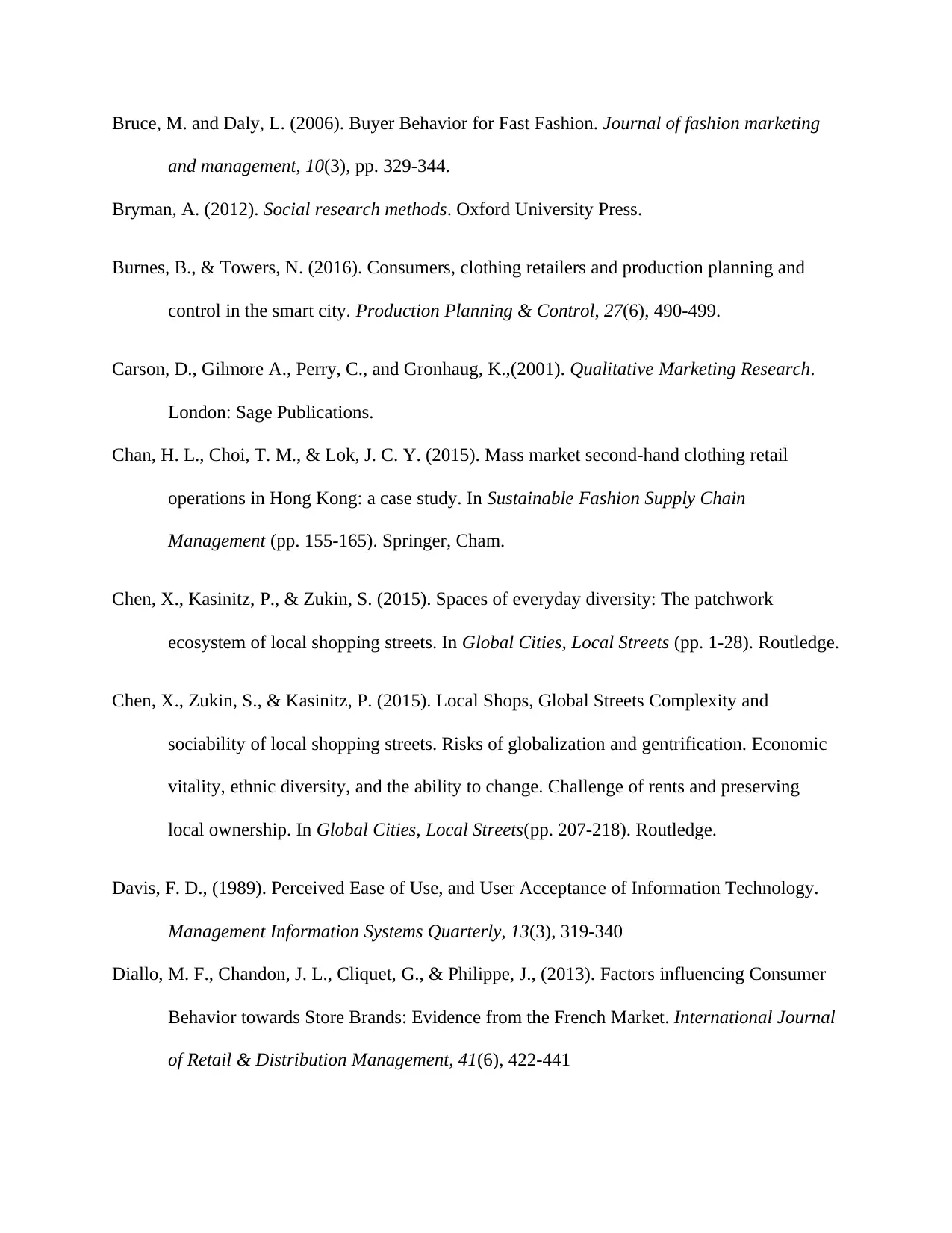
Bruce, M. and Daly, L. (2006). Buyer Behavior for Fast Fashion. Journal of fashion marketing
and management, 10(3), pp. 329-344.
Bryman, A. (2012). Social research methods. Oxford University Press.
Burnes, B., & Towers, N. (2016). Consumers, clothing retailers and production planning and
control in the smart city. Production Planning & Control, 27(6), 490-499.
Carson, D., Gilmore A., Perry, C., and Gronhaug, K.,(2001). Qualitative Marketing Research.
London: Sage Publications.
Chan, H. L., Choi, T. M., & Lok, J. C. Y. (2015). Mass market second-hand clothing retail
operations in Hong Kong: a case study. In Sustainable Fashion Supply Chain
Management (pp. 155-165). Springer, Cham.
Chen, X., Kasinitz, P., & Zukin, S. (2015). Spaces of everyday diversity: The patchwork
ecosystem of local shopping streets. In Global Cities, Local Streets (pp. 1-28). Routledge.
Chen, X., Zukin, S., & Kasinitz, P. (2015). Local Shops, Global Streets Complexity and
sociability of local shopping streets. Risks of globalization and gentrification. Economic
vitality, ethnic diversity, and the ability to change. Challenge of rents and preserving
local ownership. In Global Cities, Local Streets(pp. 207-218). Routledge.
Davis, F. D., (1989). Perceived Ease of Use, and User Acceptance of Information Technology.
Management Information Systems Quarterly, 13(3), 319-340
Diallo, M. F., Chandon, J. L., Cliquet, G., & Philippe, J., (2013). Factors influencing Consumer
Behavior towards Store Brands: Evidence from the French Market. International Journal
of Retail & Distribution Management, 41(6), 422-441
and management, 10(3), pp. 329-344.
Bryman, A. (2012). Social research methods. Oxford University Press.
Burnes, B., & Towers, N. (2016). Consumers, clothing retailers and production planning and
control in the smart city. Production Planning & Control, 27(6), 490-499.
Carson, D., Gilmore A., Perry, C., and Gronhaug, K.,(2001). Qualitative Marketing Research.
London: Sage Publications.
Chan, H. L., Choi, T. M., & Lok, J. C. Y. (2015). Mass market second-hand clothing retail
operations in Hong Kong: a case study. In Sustainable Fashion Supply Chain
Management (pp. 155-165). Springer, Cham.
Chen, X., Kasinitz, P., & Zukin, S. (2015). Spaces of everyday diversity: The patchwork
ecosystem of local shopping streets. In Global Cities, Local Streets (pp. 1-28). Routledge.
Chen, X., Zukin, S., & Kasinitz, P. (2015). Local Shops, Global Streets Complexity and
sociability of local shopping streets. Risks of globalization and gentrification. Economic
vitality, ethnic diversity, and the ability to change. Challenge of rents and preserving
local ownership. In Global Cities, Local Streets(pp. 207-218). Routledge.
Davis, F. D., (1989). Perceived Ease of Use, and User Acceptance of Information Technology.
Management Information Systems Quarterly, 13(3), 319-340
Diallo, M. F., Chandon, J. L., Cliquet, G., & Philippe, J., (2013). Factors influencing Consumer
Behavior towards Store Brands: Evidence from the French Market. International Journal
of Retail & Distribution Management, 41(6), 422-441
Paraphrase This Document
Need a fresh take? Get an instant paraphrase of this document with our AI Paraphraser
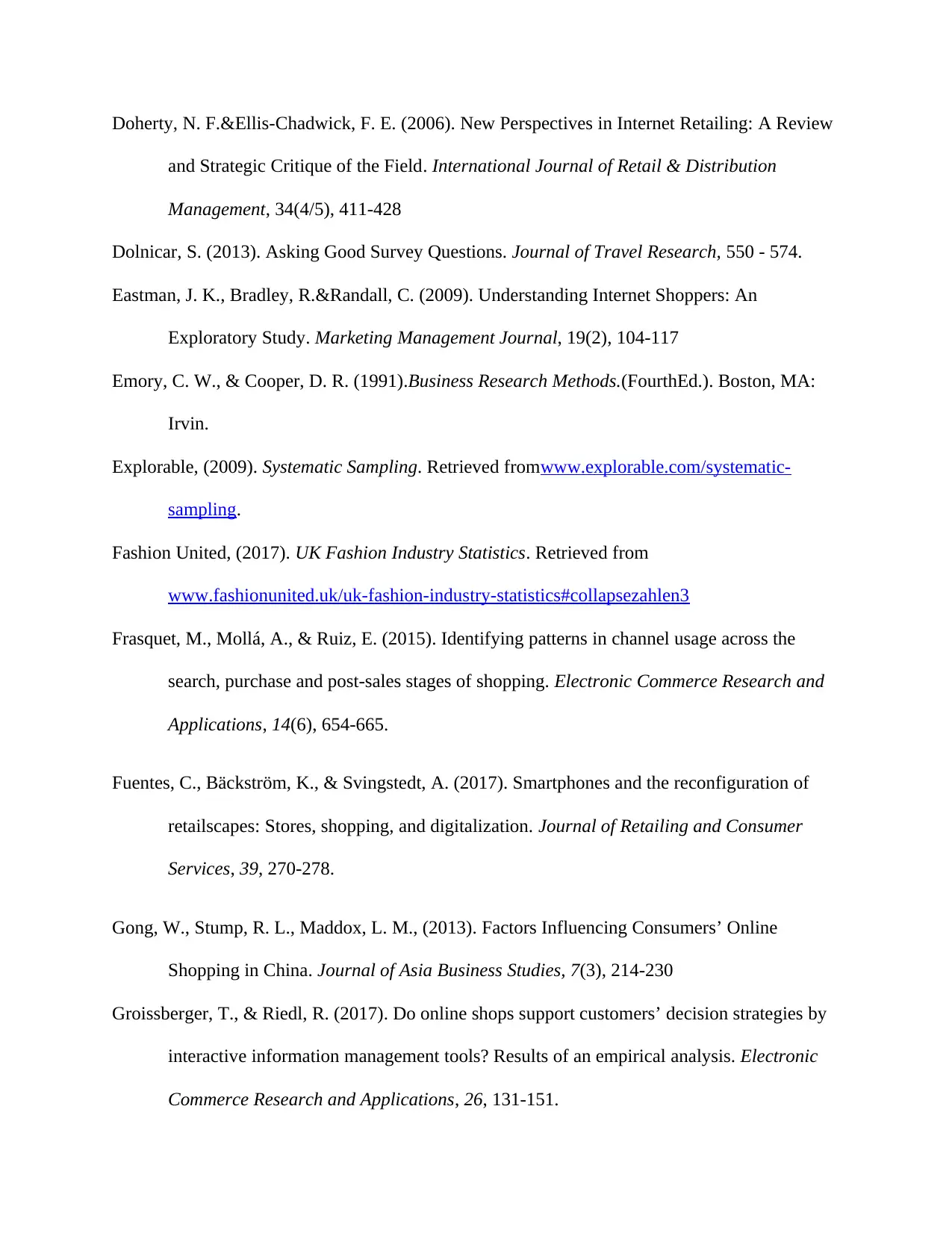
Doherty, N. F.&Ellis-Chadwick, F. E. (2006). New Perspectives in Internet Retailing: A Review
and Strategic Critique of the Field. International Journal of Retail & Distribution
Management, 34(4/5), 411-428
Dolnicar, S. (2013). Asking Good Survey Questions. Journal of Travel Research, 550 - 574.
Eastman, J. K., Bradley, R.&Randall, C. (2009). Understanding Internet Shoppers: An
Exploratory Study. Marketing Management Journal, 19(2), 104-117
Emory, C. W., & Cooper, D. R. (1991).Business Research Methods.(FourthEd.). Boston, MA:
Irvin.
Explorable, (2009). Systematic Sampling. Retrieved fromwww.explorable.com/systematic-
sampling.
Fashion United, (2017). UK Fashion Industry Statistics. Retrieved from
www.fashionunited.uk/uk-fashion-industry-statistics#collapsezahlen3
Frasquet, M., Mollá, A., & Ruiz, E. (2015). Identifying patterns in channel usage across the
search, purchase and post-sales stages of shopping. Electronic Commerce Research and
Applications, 14(6), 654-665.
Fuentes, C., Bäckström, K., & Svingstedt, A. (2017). Smartphones and the reconfiguration of
retailscapes: Stores, shopping, and digitalization. Journal of Retailing and Consumer
Services, 39, 270-278.
Gong, W., Stump, R. L., Maddox, L. M., (2013). Factors Influencing Consumers’ Online
Shopping in China. Journal of Asia Business Studies, 7(3), 214-230
Groissberger, T., & Riedl, R. (2017). Do online shops support customers’ decision strategies by
interactive information management tools? Results of an empirical analysis. Electronic
Commerce Research and Applications, 26, 131-151.
and Strategic Critique of the Field. International Journal of Retail & Distribution
Management, 34(4/5), 411-428
Dolnicar, S. (2013). Asking Good Survey Questions. Journal of Travel Research, 550 - 574.
Eastman, J. K., Bradley, R.&Randall, C. (2009). Understanding Internet Shoppers: An
Exploratory Study. Marketing Management Journal, 19(2), 104-117
Emory, C. W., & Cooper, D. R. (1991).Business Research Methods.(FourthEd.). Boston, MA:
Irvin.
Explorable, (2009). Systematic Sampling. Retrieved fromwww.explorable.com/systematic-
sampling.
Fashion United, (2017). UK Fashion Industry Statistics. Retrieved from
www.fashionunited.uk/uk-fashion-industry-statistics#collapsezahlen3
Frasquet, M., Mollá, A., & Ruiz, E. (2015). Identifying patterns in channel usage across the
search, purchase and post-sales stages of shopping. Electronic Commerce Research and
Applications, 14(6), 654-665.
Fuentes, C., Bäckström, K., & Svingstedt, A. (2017). Smartphones and the reconfiguration of
retailscapes: Stores, shopping, and digitalization. Journal of Retailing and Consumer
Services, 39, 270-278.
Gong, W., Stump, R. L., Maddox, L. M., (2013). Factors Influencing Consumers’ Online
Shopping in China. Journal of Asia Business Studies, 7(3), 214-230
Groissberger, T., & Riedl, R. (2017). Do online shops support customers’ decision strategies by
interactive information management tools? Results of an empirical analysis. Electronic
Commerce Research and Applications, 26, 131-151.
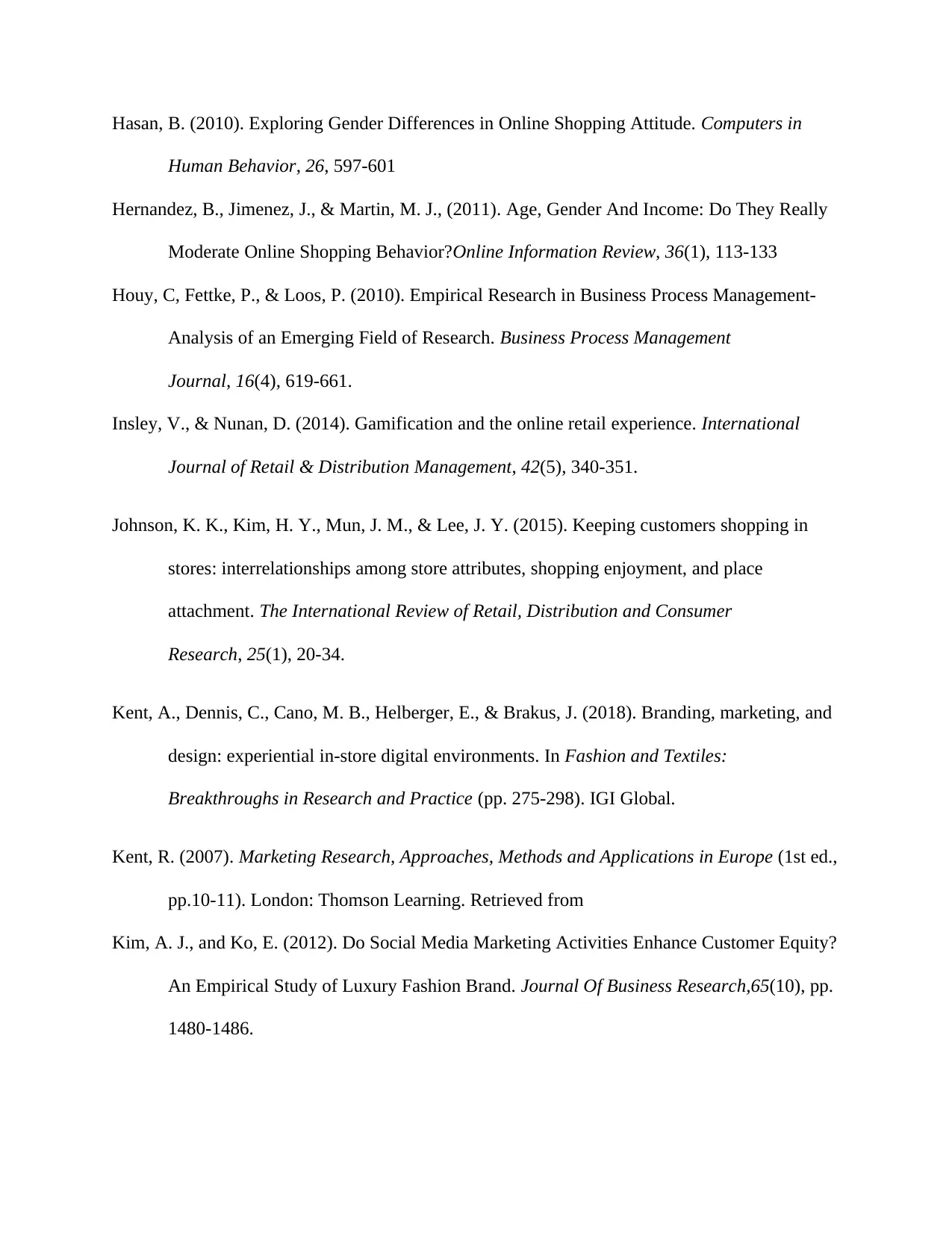
Hasan, B. (2010). Exploring Gender Differences in Online Shopping Attitude. Computers in
Human Behavior, 26, 597-601
Hernandez, B., Jimenez, J., & Martin, M. J., (2011). Age, Gender And Income: Do They Really
Moderate Online Shopping Behavior?Online Information Review, 36(1), 113-133
Houy, C, Fettke, P., & Loos, P. (2010). Empirical Research in Business Process Management-
Analysis of an Emerging Field of Research. Business Process Management
Journal, 16(4), 619-661.
Insley, V., & Nunan, D. (2014). Gamification and the online retail experience. International
Journal of Retail & Distribution Management, 42(5), 340-351.
Johnson, K. K., Kim, H. Y., Mun, J. M., & Lee, J. Y. (2015). Keeping customers shopping in
stores: interrelationships among store attributes, shopping enjoyment, and place
attachment. The International Review of Retail, Distribution and Consumer
Research, 25(1), 20-34.
Kent, A., Dennis, C., Cano, M. B., Helberger, E., & Brakus, J. (2018). Branding, marketing, and
design: experiential in-store digital environments. In Fashion and Textiles:
Breakthroughs in Research and Practice (pp. 275-298). IGI Global.
Kent, R. (2007). Marketing Research, Approaches, Methods and Applications in Europe (1st ed.,
pp.10-11). London: Thomson Learning. Retrieved from
Kim, A. J., and Ko, E. (2012). Do Social Media Marketing Activities Enhance Customer Equity?
An Empirical Study of Luxury Fashion Brand. Journal Of Business Research,65(10), pp.
1480-1486.
Human Behavior, 26, 597-601
Hernandez, B., Jimenez, J., & Martin, M. J., (2011). Age, Gender And Income: Do They Really
Moderate Online Shopping Behavior?Online Information Review, 36(1), 113-133
Houy, C, Fettke, P., & Loos, P. (2010). Empirical Research in Business Process Management-
Analysis of an Emerging Field of Research. Business Process Management
Journal, 16(4), 619-661.
Insley, V., & Nunan, D. (2014). Gamification and the online retail experience. International
Journal of Retail & Distribution Management, 42(5), 340-351.
Johnson, K. K., Kim, H. Y., Mun, J. M., & Lee, J. Y. (2015). Keeping customers shopping in
stores: interrelationships among store attributes, shopping enjoyment, and place
attachment. The International Review of Retail, Distribution and Consumer
Research, 25(1), 20-34.
Kent, A., Dennis, C., Cano, M. B., Helberger, E., & Brakus, J. (2018). Branding, marketing, and
design: experiential in-store digital environments. In Fashion and Textiles:
Breakthroughs in Research and Practice (pp. 275-298). IGI Global.
Kent, R. (2007). Marketing Research, Approaches, Methods and Applications in Europe (1st ed.,
pp.10-11). London: Thomson Learning. Retrieved from
Kim, A. J., and Ko, E. (2012). Do Social Media Marketing Activities Enhance Customer Equity?
An Empirical Study of Luxury Fashion Brand. Journal Of Business Research,65(10), pp.
1480-1486.

Kim, E. Y., & Kim, Y., (2004). Predicting Online Purchase Intentions for Clothing Products.
European Journal of Marketing, 38(7), 883-897.
Kim, H. Y., Lee, J. Y., Mun, J. M., & Johnson, K. K. (2017). Consumer adoption of smart in-
store technology: assessing the predictive value of attitude versus beliefs in the
technology acceptance model. International Journal of Fashion Design, Technology and
Education, 10(1), 26-36.
Kothari, C.R., (2001).Research Methodology, New Delhi: Wishaw Prakashan.
Kothari, C.R., (2014). Research methodology: Methods and techniques. New Age International
Kramer, M. (2012). The Unravelling of Apparel: Online Shopping Behavior. Reinvention: a
Journal of Undergraduate Research, 5(1). Retrieved from
http://www.warwick.ac.uk/reinventionjournal/issues/volume5issue1/kramer
Lai, J. (2017). The comparative research on online impulsive buying behaviour between the UK
and China. Journal of Residuals Science and Technology, 14(S1), S119-S124.
Lee, H. and Kim, J. (2008). The Effects of Shopping Orientations on Consumers’ Satisfaction
with Product Search and Purchases in a Multi‐Channel Environment. Journal of Fashion
Marketing and Management, 12(2), 193‐216.
Leech, N. L. & Onwuegbuzie, A. J. (2007). A Typology of Mixed Methods Research Designs.
Quality & Quantity: International Journal of Methodology,43, 265–275.
Lim, J. Y., Osman, A., Salahuddin, N. S., Romle, A. & Abdullah, S., (2016). Factors Influencing
Online Shopping Behavior: The Mediating Role of Purchase Intention. Procedia
Economics and Finance, 35(2016), 401-410.
European Journal of Marketing, 38(7), 883-897.
Kim, H. Y., Lee, J. Y., Mun, J. M., & Johnson, K. K. (2017). Consumer adoption of smart in-
store technology: assessing the predictive value of attitude versus beliefs in the
technology acceptance model. International Journal of Fashion Design, Technology and
Education, 10(1), 26-36.
Kothari, C.R., (2001).Research Methodology, New Delhi: Wishaw Prakashan.
Kothari, C.R., (2014). Research methodology: Methods and techniques. New Age International
Kramer, M. (2012). The Unravelling of Apparel: Online Shopping Behavior. Reinvention: a
Journal of Undergraduate Research, 5(1). Retrieved from
http://www.warwick.ac.uk/reinventionjournal/issues/volume5issue1/kramer
Lai, J. (2017). The comparative research on online impulsive buying behaviour between the UK
and China. Journal of Residuals Science and Technology, 14(S1), S119-S124.
Lee, H. and Kim, J. (2008). The Effects of Shopping Orientations on Consumers’ Satisfaction
with Product Search and Purchases in a Multi‐Channel Environment. Journal of Fashion
Marketing and Management, 12(2), 193‐216.
Leech, N. L. & Onwuegbuzie, A. J. (2007). A Typology of Mixed Methods Research Designs.
Quality & Quantity: International Journal of Methodology,43, 265–275.
Lim, J. Y., Osman, A., Salahuddin, N. S., Romle, A. & Abdullah, S., (2016). Factors Influencing
Online Shopping Behavior: The Mediating Role of Purchase Intention. Procedia
Economics and Finance, 35(2016), 401-410.
Secure Best Marks with AI Grader
Need help grading? Try our AI Grader for instant feedback on your assignments.
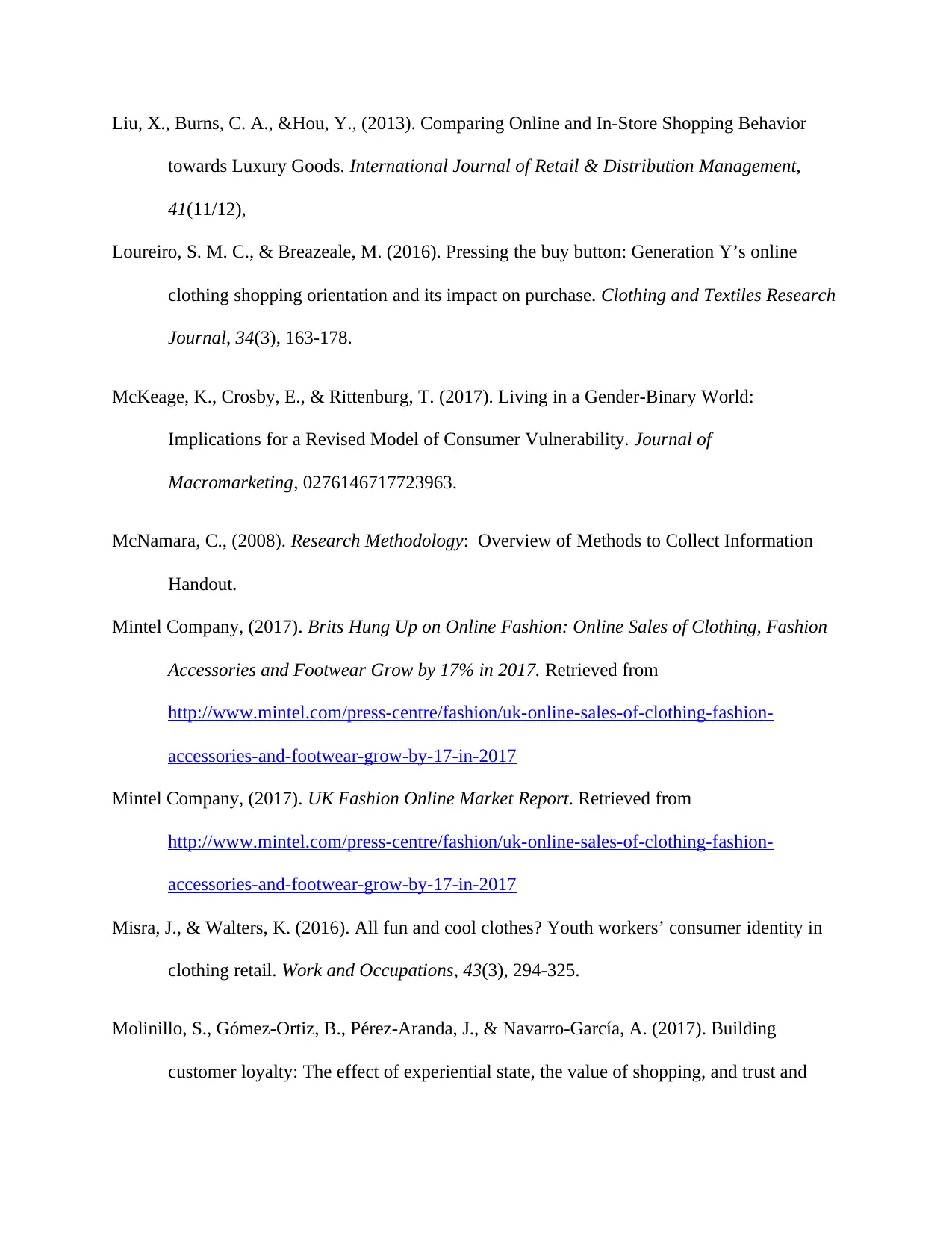
Liu, X., Burns, C. A., &Hou, Y., (2013). Comparing Online and In-Store Shopping Behavior
towards Luxury Goods. International Journal of Retail & Distribution Management,
41(11/12),
Loureiro, S. M. C., & Breazeale, M. (2016). Pressing the buy button: Generation Y’s online
clothing shopping orientation and its impact on purchase. Clothing and Textiles Research
Journal, 34(3), 163-178.
McKeage, K., Crosby, E., & Rittenburg, T. (2017). Living in a Gender-Binary World:
Implications for a Revised Model of Consumer Vulnerability. Journal of
Macromarketing, 0276146717723963.
McNamara, C., (2008). Research Methodology: Overview of Methods to Collect Information
Handout.
Mintel Company, (2017). Brits Hung Up on Online Fashion: Online Sales of Clothing, Fashion
Accessories and Footwear Grow by 17% in 2017. Retrieved from
http://www.mintel.com/press-centre/fashion/uk-online-sales-of-clothing-fashion-
accessories-and-footwear-grow-by-17-in-2017
Mintel Company, (2017). UK Fashion Online Market Report. Retrieved from
http://www.mintel.com/press-centre/fashion/uk-online-sales-of-clothing-fashion-
accessories-and-footwear-grow-by-17-in-2017
Misra, J., & Walters, K. (2016). All fun and cool clothes? Youth workers’ consumer identity in
clothing retail. Work and Occupations, 43(3), 294-325.
Molinillo, S., Gómez-Ortiz, B., Pérez-Aranda, J., & Navarro-García, A. (2017). Building
customer loyalty: The effect of experiential state, the value of shopping, and trust and
towards Luxury Goods. International Journal of Retail & Distribution Management,
41(11/12),
Loureiro, S. M. C., & Breazeale, M. (2016). Pressing the buy button: Generation Y’s online
clothing shopping orientation and its impact on purchase. Clothing and Textiles Research
Journal, 34(3), 163-178.
McKeage, K., Crosby, E., & Rittenburg, T. (2017). Living in a Gender-Binary World:
Implications for a Revised Model of Consumer Vulnerability. Journal of
Macromarketing, 0276146717723963.
McNamara, C., (2008). Research Methodology: Overview of Methods to Collect Information
Handout.
Mintel Company, (2017). Brits Hung Up on Online Fashion: Online Sales of Clothing, Fashion
Accessories and Footwear Grow by 17% in 2017. Retrieved from
http://www.mintel.com/press-centre/fashion/uk-online-sales-of-clothing-fashion-
accessories-and-footwear-grow-by-17-in-2017
Mintel Company, (2017). UK Fashion Online Market Report. Retrieved from
http://www.mintel.com/press-centre/fashion/uk-online-sales-of-clothing-fashion-
accessories-and-footwear-grow-by-17-in-2017
Misra, J., & Walters, K. (2016). All fun and cool clothes? Youth workers’ consumer identity in
clothing retail. Work and Occupations, 43(3), 294-325.
Molinillo, S., Gómez-Ortiz, B., Pérez-Aranda, J., & Navarro-García, A. (2017). Building
customer loyalty: The effect of experiential state, the value of shopping, and trust and
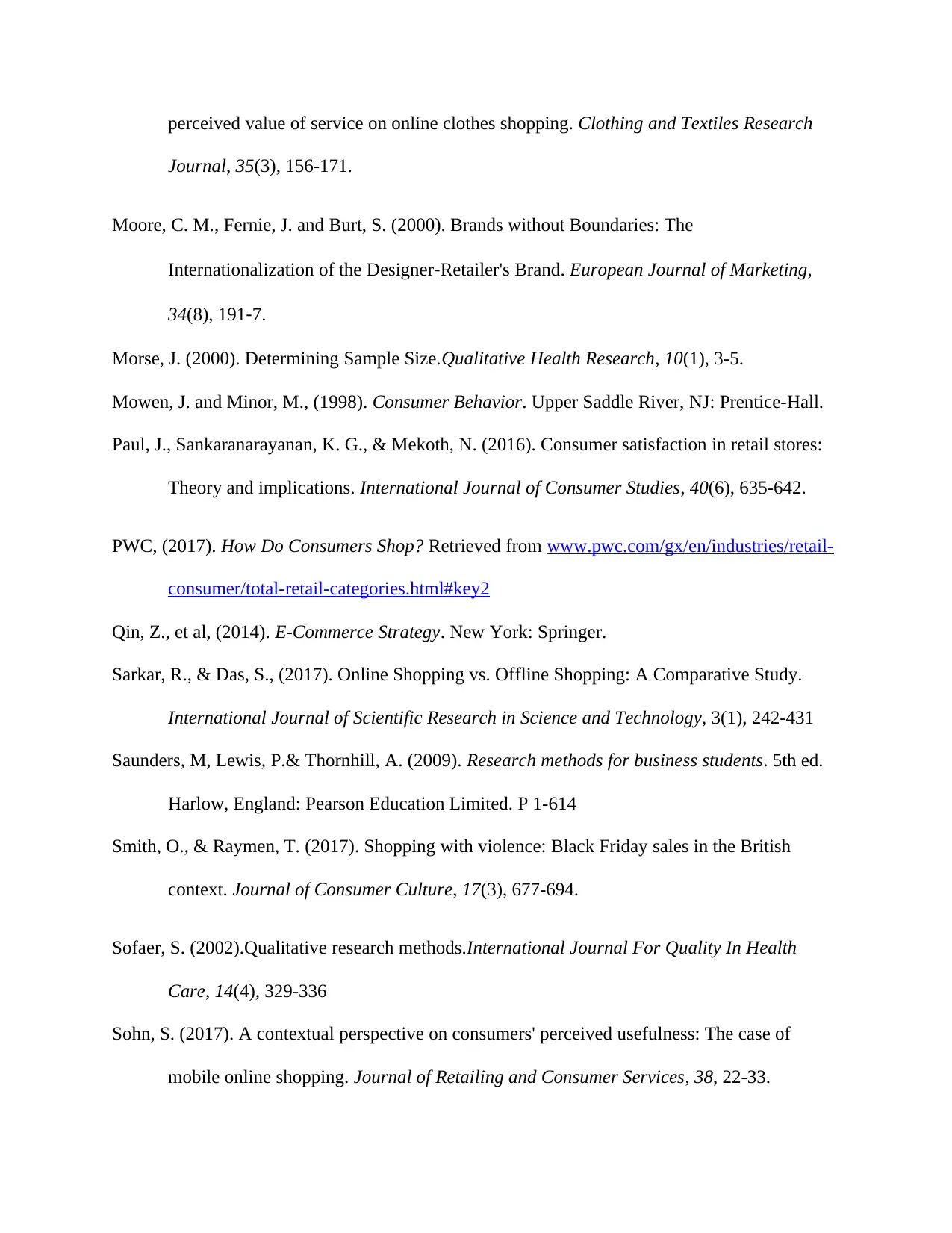
perceived value of service on online clothes shopping. Clothing and Textiles Research
Journal, 35(3), 156-171.
Moore, C. M., Fernie, J. and Burt, S. (2000). Brands without Boundaries: The
Internationalization of the Designer‐Retailer's Brand. European Journal of Marketing,
34(8), 191‐7.
Morse, J. (2000). Determining Sample Size.Qualitative Health Research, 10(1), 3-5.
Mowen, J. and Minor, M., (1998). Consumer Behavior. Upper Saddle River, NJ: Prentice-Hall.
Paul, J., Sankaranarayanan, K. G., & Mekoth, N. (2016). Consumer satisfaction in retail stores:
Theory and implications. International Journal of Consumer Studies, 40(6), 635-642.
PWC, (2017). How Do Consumers Shop? Retrieved from www.pwc.com/gx/en/industries/retail-
consumer/total-retail-categories.html#key2
Qin, Z., et al, (2014). E-Commerce Strategy. New York: Springer.
Sarkar, R., & Das, S., (2017). Online Shopping vs. Offline Shopping: A Comparative Study.
International Journal of Scientific Research in Science and Technology, 3(1), 242-431
Saunders, M, Lewis, P.& Thornhill, A. (2009). Research methods for business students. 5th ed.
Harlow, England: Pearson Education Limited. P 1-614
Smith, O., & Raymen, T. (2017). Shopping with violence: Black Friday sales in the British
context. Journal of Consumer Culture, 17(3), 677-694.
Sofaer, S. (2002).Qualitative research methods.International Journal For Quality In Health
Care, 14(4), 329-336
Sohn, S. (2017). A contextual perspective on consumers' perceived usefulness: The case of
mobile online shopping. Journal of Retailing and Consumer Services, 38, 22-33.
Journal, 35(3), 156-171.
Moore, C. M., Fernie, J. and Burt, S. (2000). Brands without Boundaries: The
Internationalization of the Designer‐Retailer's Brand. European Journal of Marketing,
34(8), 191‐7.
Morse, J. (2000). Determining Sample Size.Qualitative Health Research, 10(1), 3-5.
Mowen, J. and Minor, M., (1998). Consumer Behavior. Upper Saddle River, NJ: Prentice-Hall.
Paul, J., Sankaranarayanan, K. G., & Mekoth, N. (2016). Consumer satisfaction in retail stores:
Theory and implications. International Journal of Consumer Studies, 40(6), 635-642.
PWC, (2017). How Do Consumers Shop? Retrieved from www.pwc.com/gx/en/industries/retail-
consumer/total-retail-categories.html#key2
Qin, Z., et al, (2014). E-Commerce Strategy. New York: Springer.
Sarkar, R., & Das, S., (2017). Online Shopping vs. Offline Shopping: A Comparative Study.
International Journal of Scientific Research in Science and Technology, 3(1), 242-431
Saunders, M, Lewis, P.& Thornhill, A. (2009). Research methods for business students. 5th ed.
Harlow, England: Pearson Education Limited. P 1-614
Smith, O., & Raymen, T. (2017). Shopping with violence: Black Friday sales in the British
context. Journal of Consumer Culture, 17(3), 677-694.
Sofaer, S. (2002).Qualitative research methods.International Journal For Quality In Health
Care, 14(4), 329-336
Sohn, S. (2017). A contextual perspective on consumers' perceived usefulness: The case of
mobile online shopping. Journal of Retailing and Consumer Services, 38, 22-33.
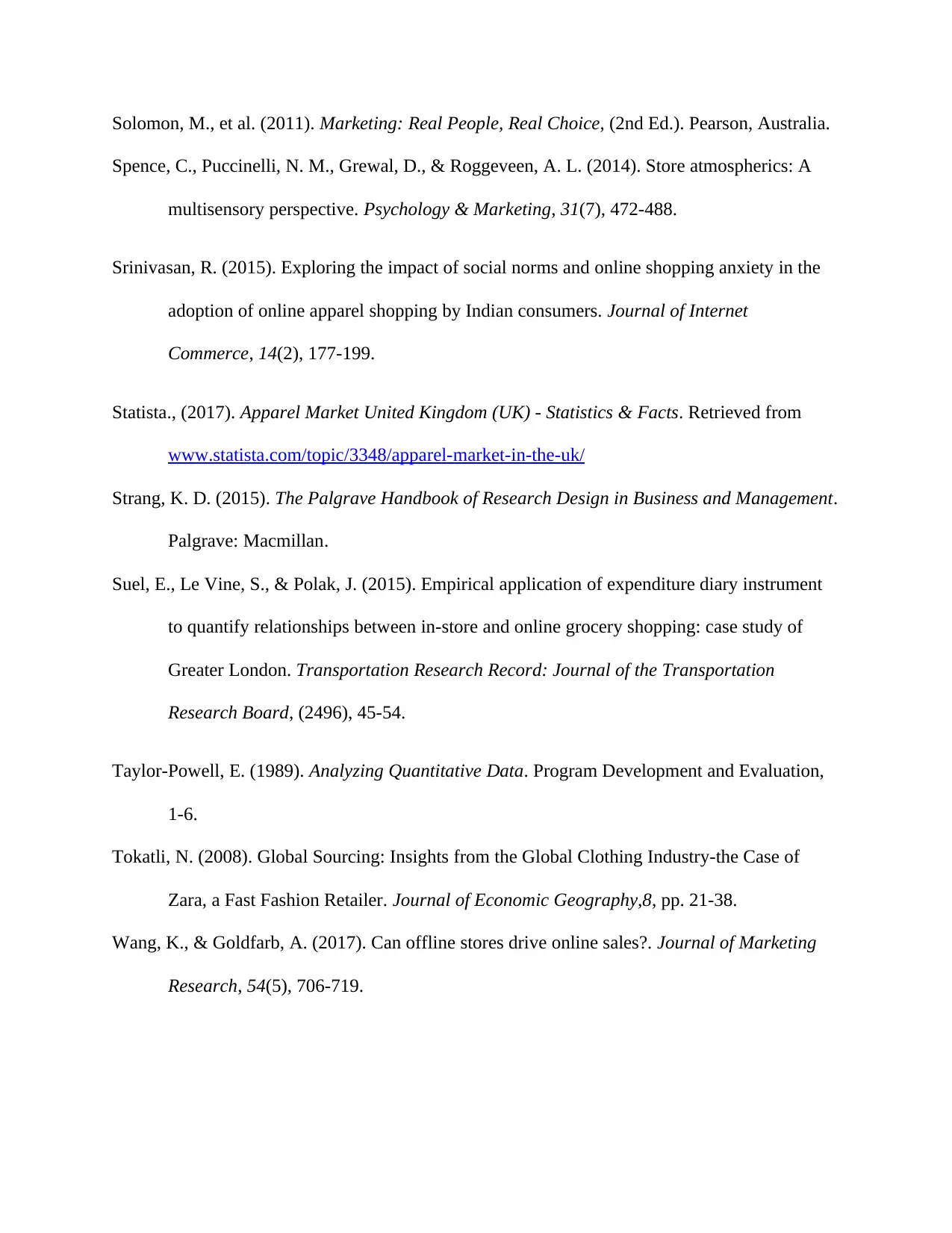
Solomon, M., et al. (2011). Marketing: Real People, Real Choice, (2nd Ed.). Pearson, Australia.
Spence, C., Puccinelli, N. M., Grewal, D., & Roggeveen, A. L. (2014). Store atmospherics: A
multisensory perspective. Psychology & Marketing, 31(7), 472-488.
Srinivasan, R. (2015). Exploring the impact of social norms and online shopping anxiety in the
adoption of online apparel shopping by Indian consumers. Journal of Internet
Commerce, 14(2), 177-199.
Statista., (2017). Apparel Market United Kingdom (UK) - Statistics & Facts. Retrieved from
www.statista.com/topic/3348/apparel-market-in-the-uk/
Strang, K. D. (2015). The Palgrave Handbook of Research Design in Business and Management.
Palgrave: Macmillan.
Suel, E., Le Vine, S., & Polak, J. (2015). Empirical application of expenditure diary instrument
to quantify relationships between in-store and online grocery shopping: case study of
Greater London. Transportation Research Record: Journal of the Transportation
Research Board, (2496), 45-54.
Taylor-Powell, E. (1989). Analyzing Quantitative Data. Program Development and Evaluation,
1-6.
Tokatli, N. (2008). Global Sourcing: Insights from the Global Clothing Industry-the Case of
Zara, a Fast Fashion Retailer. Journal of Economic Geography,8, pp. 21-38.
Wang, K., & Goldfarb, A. (2017). Can offline stores drive online sales?. Journal of Marketing
Research, 54(5), 706-719.
Spence, C., Puccinelli, N. M., Grewal, D., & Roggeveen, A. L. (2014). Store atmospherics: A
multisensory perspective. Psychology & Marketing, 31(7), 472-488.
Srinivasan, R. (2015). Exploring the impact of social norms and online shopping anxiety in the
adoption of online apparel shopping by Indian consumers. Journal of Internet
Commerce, 14(2), 177-199.
Statista., (2017). Apparel Market United Kingdom (UK) - Statistics & Facts. Retrieved from
www.statista.com/topic/3348/apparel-market-in-the-uk/
Strang, K. D. (2015). The Palgrave Handbook of Research Design in Business and Management.
Palgrave: Macmillan.
Suel, E., Le Vine, S., & Polak, J. (2015). Empirical application of expenditure diary instrument
to quantify relationships between in-store and online grocery shopping: case study of
Greater London. Transportation Research Record: Journal of the Transportation
Research Board, (2496), 45-54.
Taylor-Powell, E. (1989). Analyzing Quantitative Data. Program Development and Evaluation,
1-6.
Tokatli, N. (2008). Global Sourcing: Insights from the Global Clothing Industry-the Case of
Zara, a Fast Fashion Retailer. Journal of Economic Geography,8, pp. 21-38.
Wang, K., & Goldfarb, A. (2017). Can offline stores drive online sales?. Journal of Marketing
Research, 54(5), 706-719.
Paraphrase This Document
Need a fresh take? Get an instant paraphrase of this document with our AI Paraphraser
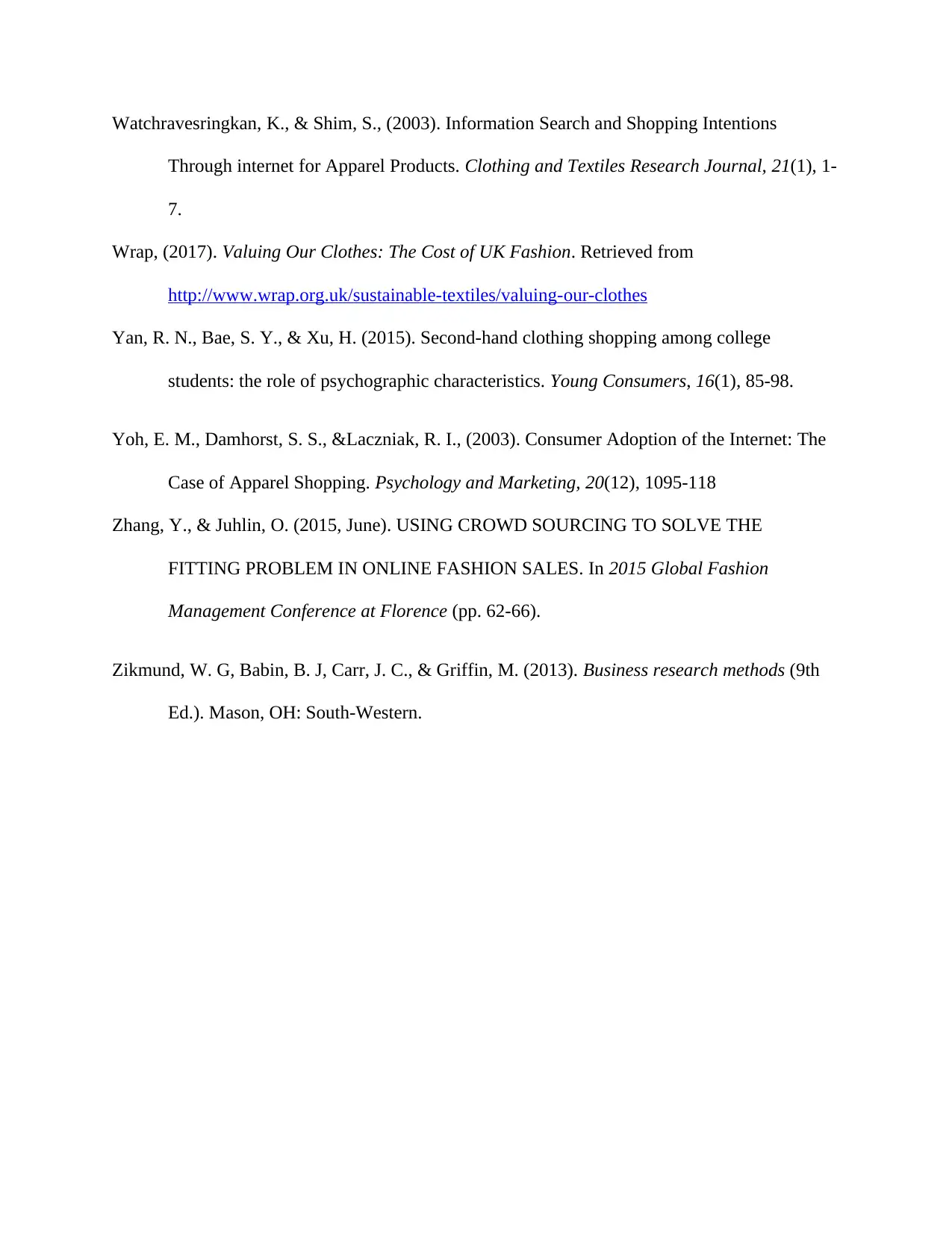
Watchravesringkan, K., & Shim, S., (2003). Information Search and Shopping Intentions
Through internet for Apparel Products. Clothing and Textiles Research Journal, 21(1), 1-
7.
Wrap, (2017). Valuing Our Clothes: The Cost of UK Fashion. Retrieved from
http://www.wrap.org.uk/sustainable-textiles/valuing-our-clothes
Yan, R. N., Bae, S. Y., & Xu, H. (2015). Second-hand clothing shopping among college
students: the role of psychographic characteristics. Young Consumers, 16(1), 85-98.
Yoh, E. M., Damhorst, S. S., &Laczniak, R. I., (2003). Consumer Adoption of the Internet: The
Case of Apparel Shopping. Psychology and Marketing, 20(12), 1095-118
Zhang, Y., & Juhlin, O. (2015, June). USING CROWD SOURCING TO SOLVE THE
FITTING PROBLEM IN ONLINE FASHION SALES. In 2015 Global Fashion
Management Conference at Florence (pp. 62-66).
Zikmund, W. G, Babin, B. J, Carr, J. C., & Griffin, M. (2013). Business research methods (9th
Ed.). Mason, OH: South-Western.
Through internet for Apparel Products. Clothing and Textiles Research Journal, 21(1), 1-
7.
Wrap, (2017). Valuing Our Clothes: The Cost of UK Fashion. Retrieved from
http://www.wrap.org.uk/sustainable-textiles/valuing-our-clothes
Yan, R. N., Bae, S. Y., & Xu, H. (2015). Second-hand clothing shopping among college
students: the role of psychographic characteristics. Young Consumers, 16(1), 85-98.
Yoh, E. M., Damhorst, S. S., &Laczniak, R. I., (2003). Consumer Adoption of the Internet: The
Case of Apparel Shopping. Psychology and Marketing, 20(12), 1095-118
Zhang, Y., & Juhlin, O. (2015, June). USING CROWD SOURCING TO SOLVE THE
FITTING PROBLEM IN ONLINE FASHION SALES. In 2015 Global Fashion
Management Conference at Florence (pp. 62-66).
Zikmund, W. G, Babin, B. J, Carr, J. C., & Griffin, M. (2013). Business research methods (9th
Ed.). Mason, OH: South-Western.
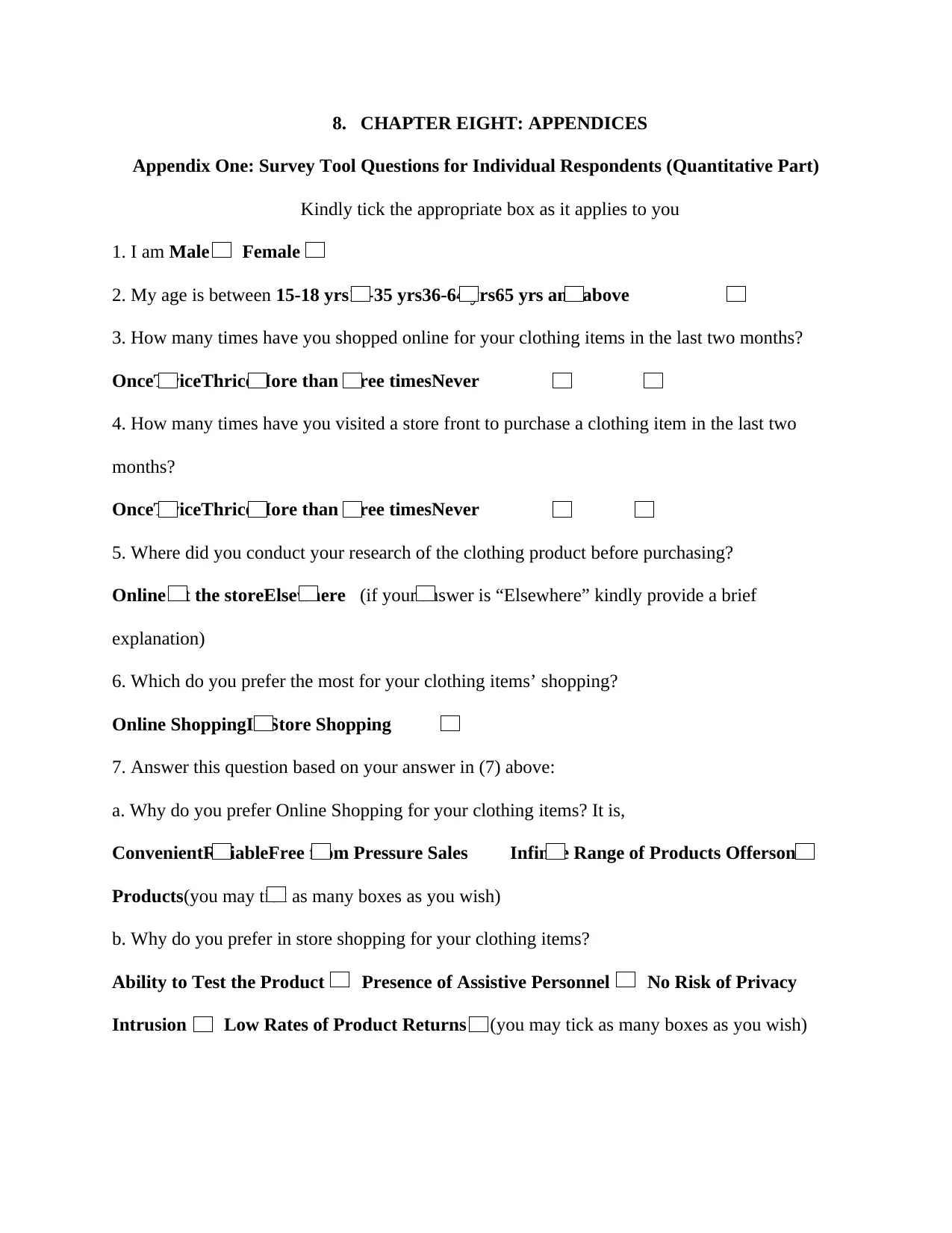
8. CHAPTER EIGHT: APPENDICES
Appendix One: Survey Tool Questions for Individual Respondents (Quantitative Part)
Kindly tick the appropriate box as it applies to you
1. I am Male Female
2. My age is between 15-18 yrs19-35 yrs36-64 yrs65 yrs and above
3. How many times have you shopped online for your clothing items in the last two months?
OnceTwiceThriceMore than three timesNever
4. How many times have you visited a store front to purchase a clothing item in the last two
months?
OnceTwiceThriceMore than three timesNever
5. Where did you conduct your research of the clothing product before purchasing?
Online At the storeElsewhere (if your answer is “Elsewhere” kindly provide a brief
explanation)
6. Which do you prefer the most for your clothing items’ shopping?
Online ShoppingIn Store Shopping
7. Answer this question based on your answer in (7) above:
a. Why do you prefer Online Shopping for your clothing items? It is,
ConvenientReliableFree from Pressure Sales Infinite Range of Products Offerson
Products(you may tick as many boxes as you wish)
b. Why do you prefer in store shopping for your clothing items?
Ability to Test the Product Presence of Assistive Personnel No Risk of Privacy
Intrusion Low Rates of Product Returns (you may tick as many boxes as you wish)
Appendix One: Survey Tool Questions for Individual Respondents (Quantitative Part)
Kindly tick the appropriate box as it applies to you
1. I am Male Female
2. My age is between 15-18 yrs19-35 yrs36-64 yrs65 yrs and above
3. How many times have you shopped online for your clothing items in the last two months?
OnceTwiceThriceMore than three timesNever
4. How many times have you visited a store front to purchase a clothing item in the last two
months?
OnceTwiceThriceMore than three timesNever
5. Where did you conduct your research of the clothing product before purchasing?
Online At the storeElsewhere (if your answer is “Elsewhere” kindly provide a brief
explanation)
6. Which do you prefer the most for your clothing items’ shopping?
Online ShoppingIn Store Shopping
7. Answer this question based on your answer in (7) above:
a. Why do you prefer Online Shopping for your clothing items? It is,
ConvenientReliableFree from Pressure Sales Infinite Range of Products Offerson
Products(you may tick as many boxes as you wish)
b. Why do you prefer in store shopping for your clothing items?
Ability to Test the Product Presence of Assistive Personnel No Risk of Privacy
Intrusion Low Rates of Product Returns (you may tick as many boxes as you wish)
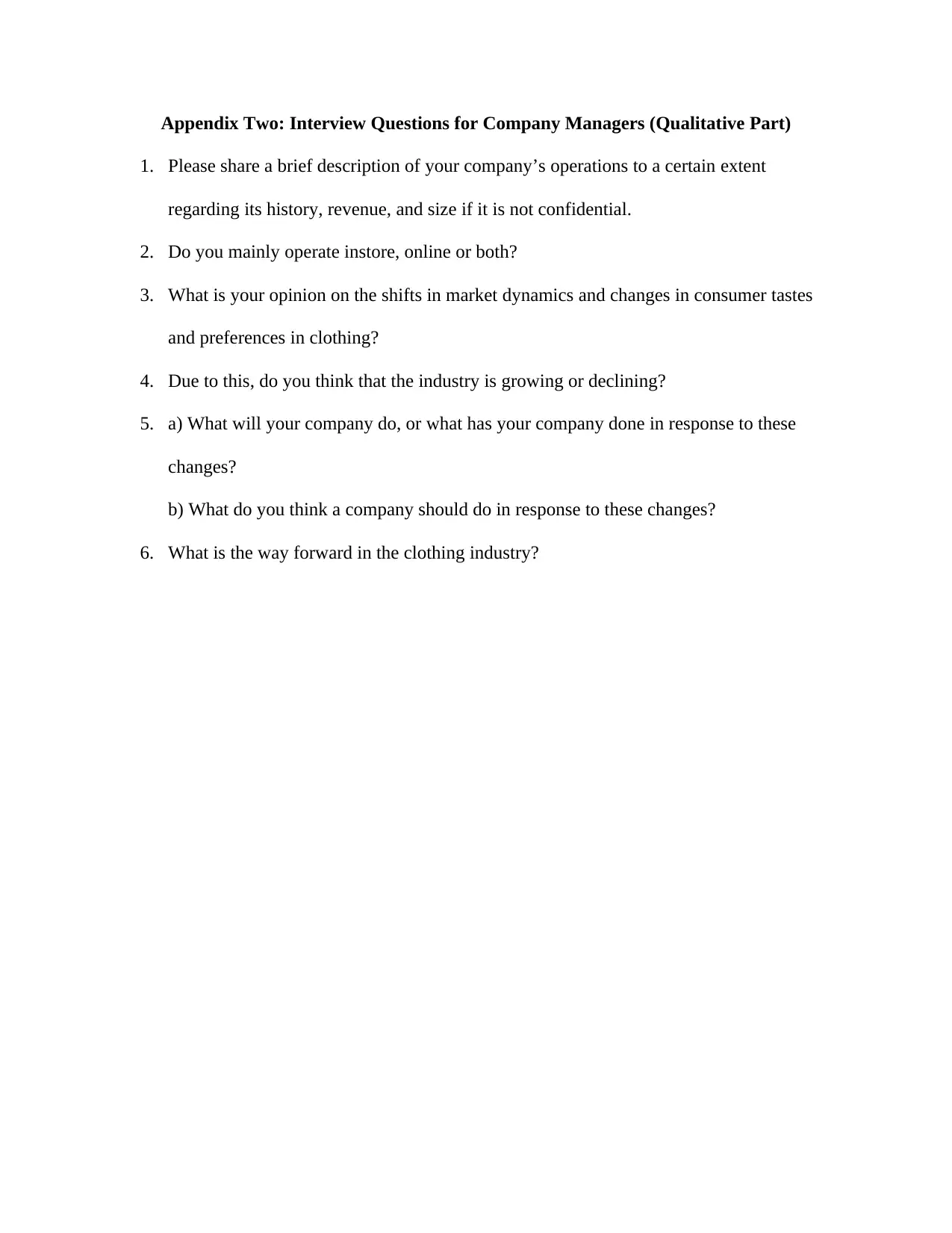
Appendix Two: Interview Questions for Company Managers (Qualitative Part)
1. Please share a brief description of your company’s operations to a certain extent
regarding its history, revenue, and size if it is not confidential.
2. Do you mainly operate instore, online or both?
3. What is your opinion on the shifts in market dynamics and changes in consumer tastes
and preferences in clothing?
4. Due to this, do you think that the industry is growing or declining?
5. a) What will your company do, or what has your company done in response to these
changes?
b) What do you think a company should do in response to these changes?
6. What is the way forward in the clothing industry?
1. Please share a brief description of your company’s operations to a certain extent
regarding its history, revenue, and size if it is not confidential.
2. Do you mainly operate instore, online or both?
3. What is your opinion on the shifts in market dynamics and changes in consumer tastes
and preferences in clothing?
4. Due to this, do you think that the industry is growing or declining?
5. a) What will your company do, or what has your company done in response to these
changes?
b) What do you think a company should do in response to these changes?
6. What is the way forward in the clothing industry?
1 out of 64
Related Documents
Your All-in-One AI-Powered Toolkit for Academic Success.
+13062052269
info@desklib.com
Available 24*7 on WhatsApp / Email
![[object Object]](/_next/static/media/star-bottom.7253800d.svg)
Unlock your academic potential
© 2024 | Zucol Services PVT LTD | All rights reserved.





